Finding the Universe
Travel tales, photography and a dash of humor
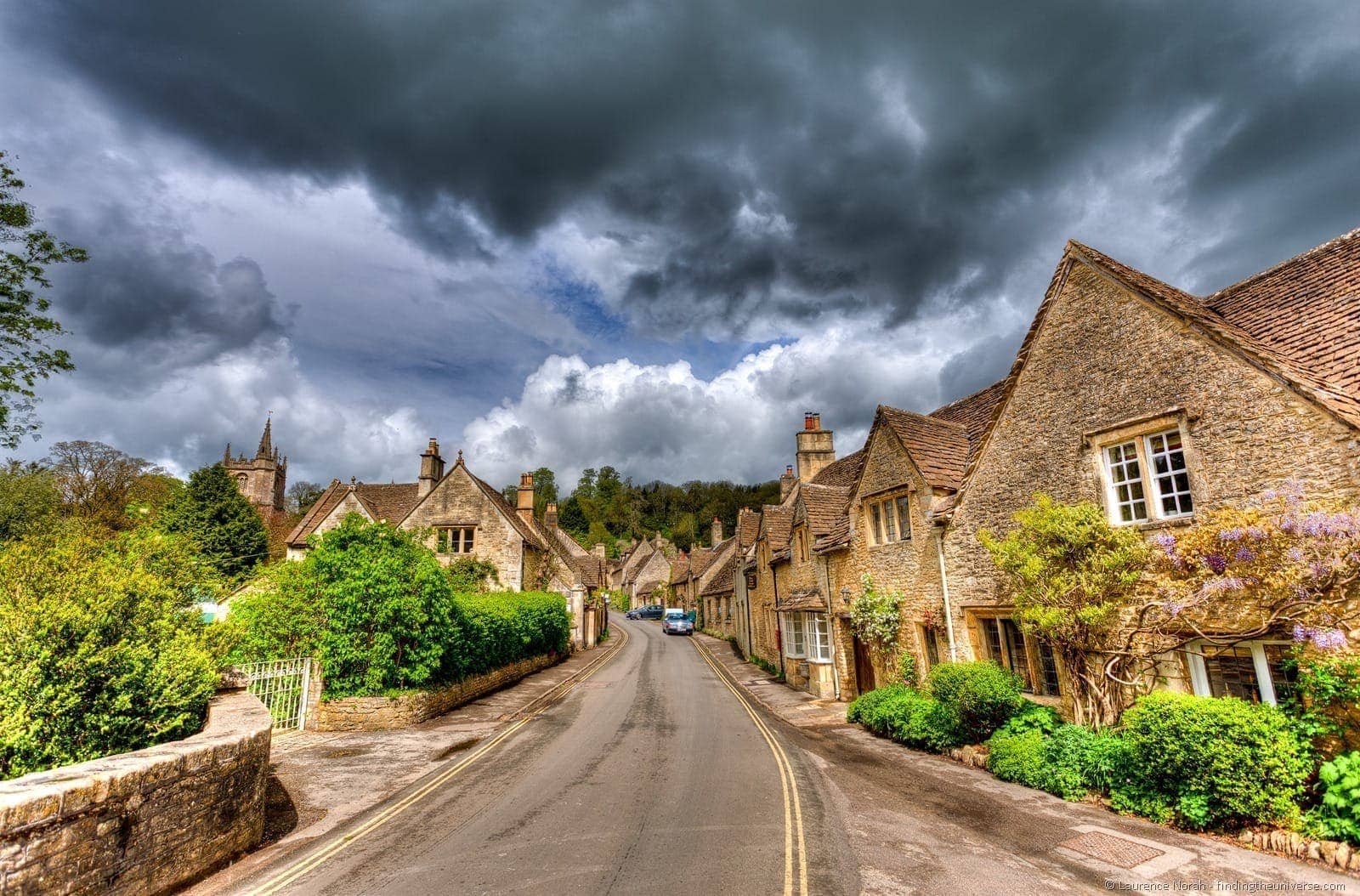

2 Weeks in the UK – My Perfect UK Trip Itinerary
Last updated: April 16, 2024 . Written by Laurence Norah - 219 Comments
If you are looking for a two week UK itinerary which includes Ireland, you have come to the right place. This UK road trip itinerary has you starting in London, and using a rental car as the transportation method. It covers some of our highlights in the UK, including cities, castles, and stunning natural scenery.
I have spent a great deal of time living in and exploring the UK. I’ve drawn on my experiences travelling here to put together my perfect two week UK trip to help you plan your own trip.
This UK itinerary (which also includes Ireland) covers England, Scotland, Northern Ireland and Wales. It’s a self-drive road-trip, although could also be modified to support travel by public transport if you prefer.
If you haven’t driven in the UK before, do check out my guide to driving in the UK for helpful tips. We also have a guide to how much it costs to travel in the UK if you need budget planning help.
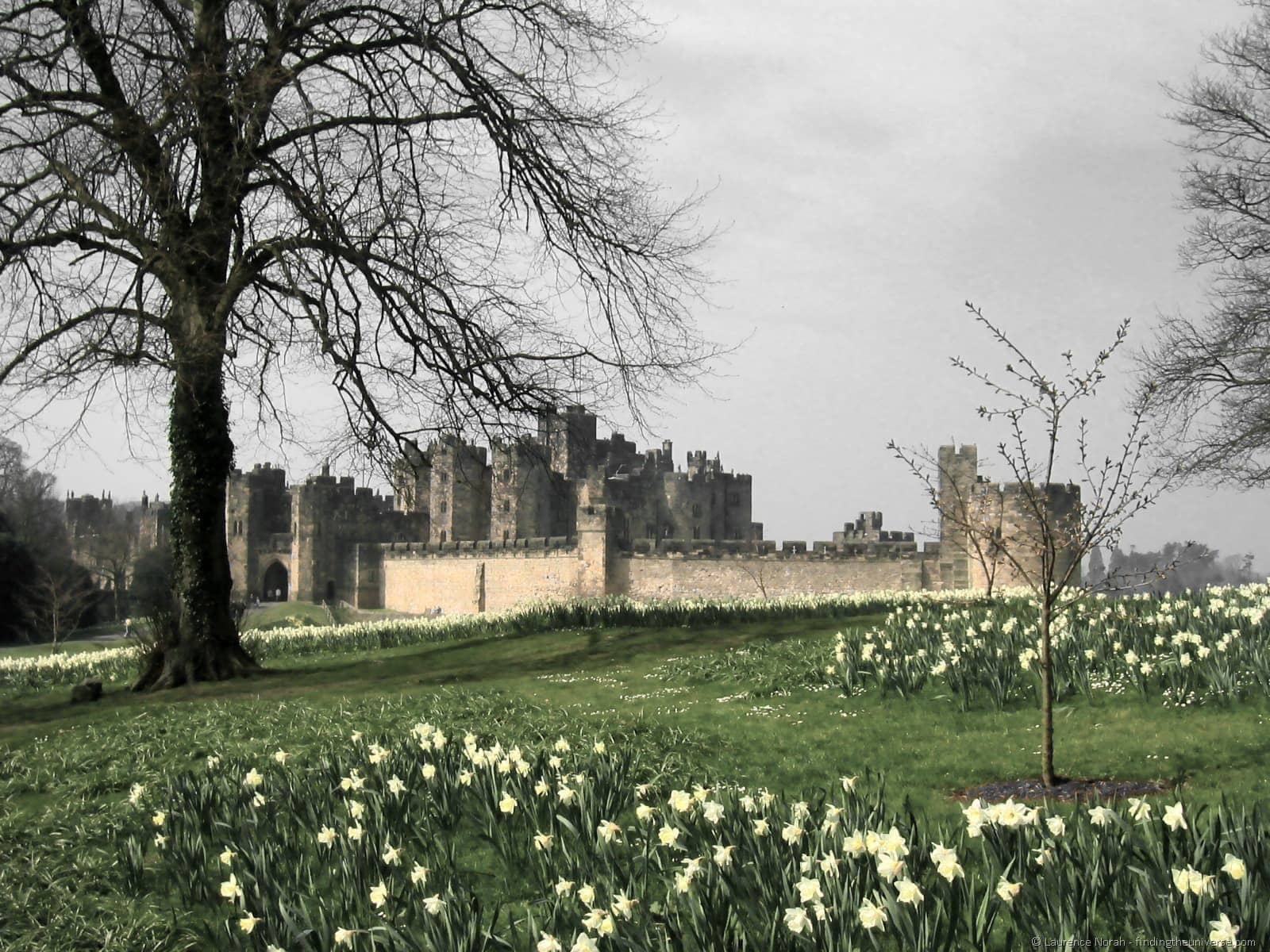
Without further ado, allow me to present my two-week UK itinerary.
A 2 week UK Trip itinerary
This itinerary is very busy and fits a lot in, including time in Ireland. It is doable, but just be aware that it will be fast paced with quite a lot of driving. Naturally, you are welcome to take the itinerary and adjust it to meet your own interests and pace.
For example, many folks prefer to focus on the UK with their two weeks, and skip the island of Ireland, returning instead via the Lake District and Wales. However, if you want to see as much as possible, this itinerary is how to do it.
Days 1 & 2: London
The UK’s capital is one of my favourite cities in the world. It’s been hanging around for over 2000 years on the banks of the Thames, and there is just an incredible wealth of things to see, from historical sights, to amazing museums, to crazy street markets.
It’s a wonderfully walk-able capital, and you can easily take in the major central sights in a day or so, leaving you the second day to explore museums, art galleries, or go a little further afield and take in some of the other sights, from crumbling cemeteries to massive parks. And if all else fails, you will never be short on an incredible pub to while away some time before heading on.
For inspiration for your visit, take a look at our 2 day London itinerary , which covers the major highlights of the city, and also links to lots of other information about visiting, including tips on finding Harry Potter locations in London through to Winston Churchill locations in London – something for everyone!
My advice for London is to invest in an Oyster card to save money on your transport (don’t hire a car until you leave the capital) and if you think you’re going to use it, look into buying a London Pass to save money on London’s top attractions.
Available in 1, 3 and 6 day versions, as well as a version with an included Oyster card, the savings can really be quite impressive if you plan on visiting a few locations. You can read a full break down on when the London Pass is worth buying here , and buy one yourself here .
Finally, London is probably going to be the most expensive city in the UK for your accommodation. We recommend booking well in advance to get a good deal.
Some of our recommended accommodation options in London are:
The Walrus Bar and Hostel , The Z hotel in Shoreditch , Point A Hotel , Lime Tree Hotel and the Resident Victoria Hotel . You can see more London hotel listings here on booking.com . We also love the curated apartments available on Plum Guide .
Once you have finished up exploring London, we suggest collecting your car hire and heading out of town. For car hire we recommend Discover Cars , they search all the major providers so you can compare and find the best deal for your trip.
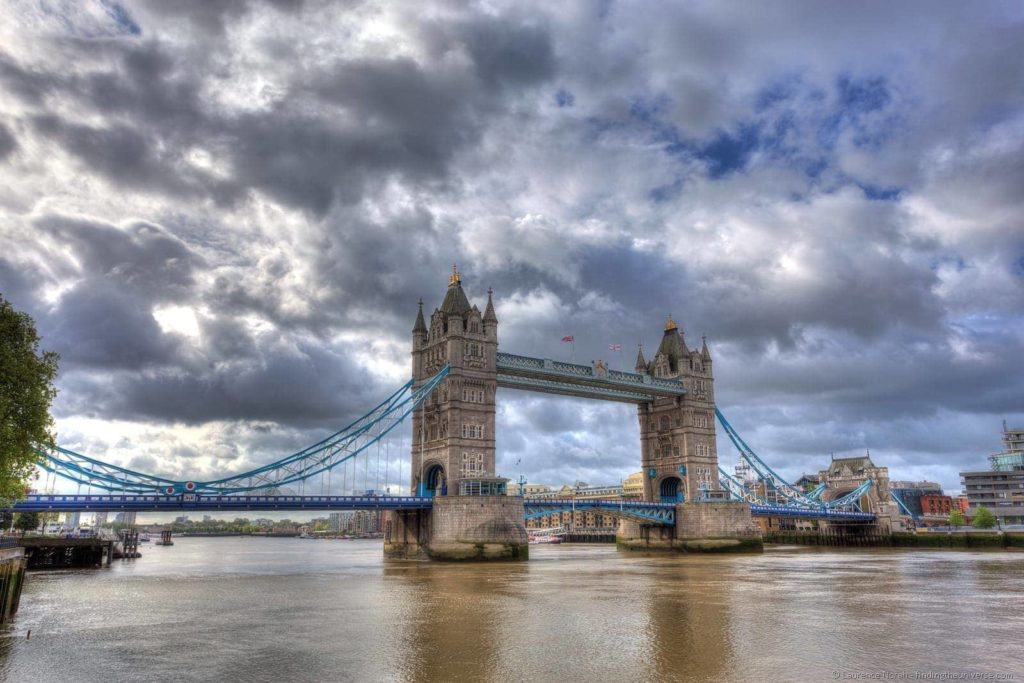
Days 3 & 4: Oxford & the Cotswolds
One of the stipulations of the original question was the wish to avoid feeling too much like a tourist. Unfortunately, this is nearly impossible in Oxford , as nearly everyone there is either a tourist or a student. I lived in and around Oxford for a number of years, and generally felt like a tourist most of that time too.
Part of the reason for that is that this tiny city is absolutely jam packed with incredible buildings, largely in the form of the Oxford Colleges. These are seriously wealthy establishments, who clearly had no problem flaunting that wealth in an architectural fashion back in the day.
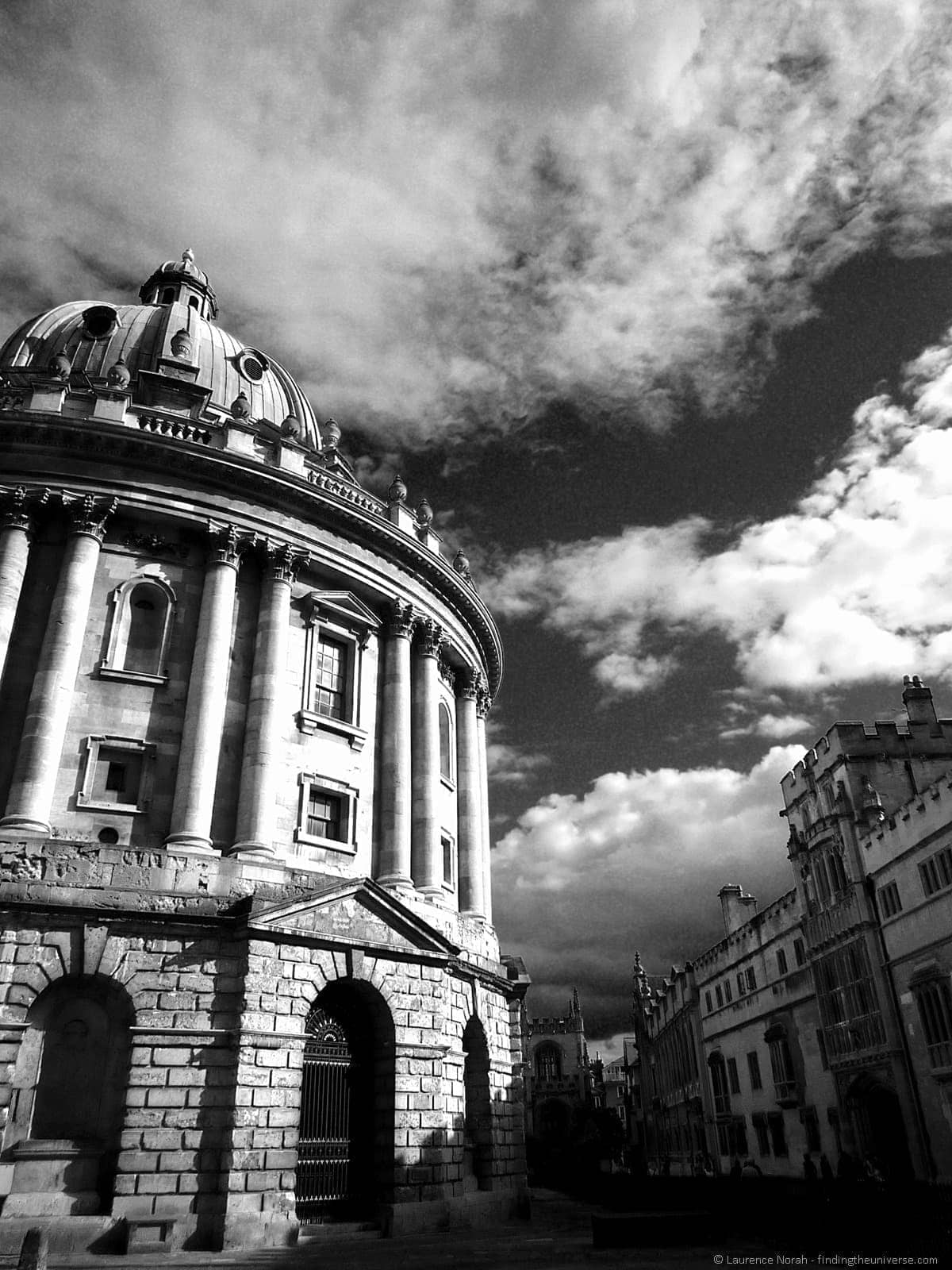
This means that yes, it is full of people wandering around, mouths agape, at quite how pretty the whole thing is. Yes, it’s jam packed with tourists. But for good reason!
So strap that camera on and snap away. Then go for a punt on the river, and enjoy some Pimms or a cream tea. Seek out the Harry Potter filming locations . Take a walking tour of the Universities . There’s no shortage of way to fill your time!
Read more tips for spending a day in Oxford, here .
From Oxford you are also well located to take in the incredibly picturesque Cotswolds area – all quaint villages and rolling countryside. The England that everyone imagines England to be like, with country pubs, village greens and cricket ovals. Lovely stuff. Check out hotel prices for Oxford here .
Days 5 & 6: Peak District and Manchester
From Oxford I’m going to suggest heading “up north”, towards the Peak District national park. Think rolling hills, quaint villages, and beautiful walks.
There are also some fabulous stately homes to visit , not to mention that on the way from Oxford you can stop off at Warwick Castle – one of the UK’s best-preserved castles.
If you’re interested in the industrial revolution in the UK I can highly recommend a visit to the city of Manchester.
Of course, if the industrial revolution isn’t your thing there are plenty of other reasons to visit Manchester, including excellent retail therapy, an awesome food scene, and a variety of architectural highlights. Not to mention the music scene!
You can see my guide to things to do in Manchester for lots more ideas, and you can see hotel prices for Manchester here .
One other thing you might consider as you pass through the Peak District and Manchester is a visit to Alton Towers . This is arguably the UK’s best known theme park, and would make for a great thrilling day out for those of you who like that sort of thing.
Day 7: York
Not that far from Manchester (England is so quaintly explorable!), the city of York is another of my favourite UK cities.
From the incredible Gothic York Minster (a climb to the top is highly recommended) to the winding, tumbled down alleyways of the shambles, to the Viking history – this is a city that just cries out for exploration.

It’s also an awesome place if you’re into ghost stories. There are a whole number of ghost walks that take in the spooky past of York, so if you want an evening of entertainment and intrigue, likely accompanied with a number of fine drinking establishments, an evening ghost walk is a great bit of fun.
I’m not a great believer in this sort of thing usually, but I took a tour and thoroughly enjoyed it!
If you do plan on seeing a few things in York, you might save money with a York City Pass , which includes most of the attractions in the city as well as access to the York Sightseeing bus or York City Cruises. You can buy that in advance here .
For more York ideas, see our guide to spending two days in York , which has a comprehensive itinerary as well as tips on where to stay and how to get around.
For accommodation, you can check out and book the best York hotels here .
Days 8 & 9: Edinburgh via Northumberland
From York we’re going to wave farewell to England, and head up to Scotland’s capital city, Edinburgh. On the way though, you’ll be passing through some of England’s least travelled, yet stunningly beautiful, landscapes.
I am of course talking about Northumbria. From miles of deserted beach, to crumbling castles, to the Roman equivalent of the great wall of China, Northumbria really has a lot to offer someone looking for a slightly off the beaten track England experience. The rolling landscapes are breath-taking and you’ll find yourself alone much of the time. Worth taking a bit of time to explore, in my opinion.

Then of course, it’s up to Edinburgh , where you’ll not be short of amazing things to look at. From Edinburgh castle, to Arthurs Seat, from fine whiskys, to Princes Street, there really is enough here for a number of days of entertainment. And if you visit during the Fringe festival… well… plan on being entertained for a good many weeks!
See more ideas on spending some time in Edinburgh in this detailed two day Edinburgh itinerary that I put together, as well as our guide to things to do in Edinburgh , our tips on visiting Edinburgh in winter , and our guide to finding Harry Potter in Edinburgh .
Then check and book your Edinburgh hotels here.
Days 10 – 12: Ireland
Because the UK is an easily explorable place with decent roads and relatively short distances to drive, it is totally possible to include another country – Ireland! – in a trip like this if you’re up for it.
Do be aware that if you are renting a car, some car rental companies have restrictions on taking cars on ferries, or into other countries – so make sure you check before you go as there may be an additional fee to pay.
Of course, you could also fly to Ireland (Edinburgh to Belfast or Dublin for example), and use different rentals for different parts of your adventure!
If all that sounds like too much hard work, you could extend your time in Scotland, or alternatively, you could take in the west coast of the UK, including Glasgow , the Lake District, and Liverpool, as well as popping into Wales for the stunning Snowdonia national park, and rejoin this itinerary in South Wales or Bristol . The choice is yours!
If it is Ireland you want though, it’s a short ferry ride from Scotland (Cairnryan to be precise, which is 2-3 hour drive from Edinburgh) across to Belfast in Northern Ireland, from where you can spend a few days exploring the Emerald Isle.
We have travelled from Cairnryan with both Stena Line and P&O Ferries, both of which have been a fast, comfortable and efficient service. We normally use Direct Ferries for ferry booking as they compare prices across all the providers and support payment in multple currencies. You can book your ferry tickets here .
This part of the world has a lot to offer, and three days is quite a short amount of time. We can recommend spending some time in Belfast and driving north along the causeway coastal route to see such highlights as the Giant’s Causeway, ruined castles and spectacular coastline. Then, head south into Ireland, and see fabulous Dublin.

I’ve explored Dublin and her surroundings, taken a trip down to the Dingle Peninsula , kissed the Blarney Stone at Blarney Castle, gazed at the Cliffs of Moher , and visited the Dark Hedges of Game of Thrones fame – to name but a few of our wonderful experience on the Irish Isle.
In Dublin there’s the Guinness Factory, of course, as a popular highlight, but also oodles of Gaelic history and culture to get excited about.
There are also of course the Irish people, well known for their love of a good time! Personally, I’d head on down the coast from Belfast, through Dublin and down to the port of Rosslare, where after three exciting days in Ireland another ferry service will whisk you across to the last of the four countries to make up the UK: Wales!
Day 13: South Wales and Cardiff
In Wales you will arrive either at Fishguard or Pembroke – both excellent places to explore the Pembrokeshire Coast national park . Here you will find beautiful beaches, rugged cliffs, and fabulous opportunities for walking.
You’re also not too far a drive from Cardiff, the Welsh capital. Four capitals in a fortnight – not bad going! Here you’ll find castles, sporting venues and more Welsh based culture than you can shake a stick at. Plus, arrive at the right time of year and you’ll find the Great British Cheese festival in full swing. What’s not to be excited about? For more about travelling in Wales and highlights along this route, see our detailed Wales road trip itinerary .
Find and book your Cardiff hotels here .
Day 14: Bristol & Bath
From Cardiff you’ll cross the enormous Severn estuary over the impress Severn road bridge and be back in the UK, or Bristol to be precise. Here you’ll find all sorts of interesting items of historical interest, largely running on a nautical theme, as well as some of the best street art in Britain .
For over a thousand years Bristol has been an important English port. From early explorers and traders, to the dark years of the African slave vessels, to filling Australia with immigrants, it is hard to understate the role that Bristol has played in Britain’s sea faring history. There is, after all, a reason for the expression “ship-shape and Bristol fashion” having a place in the English language.
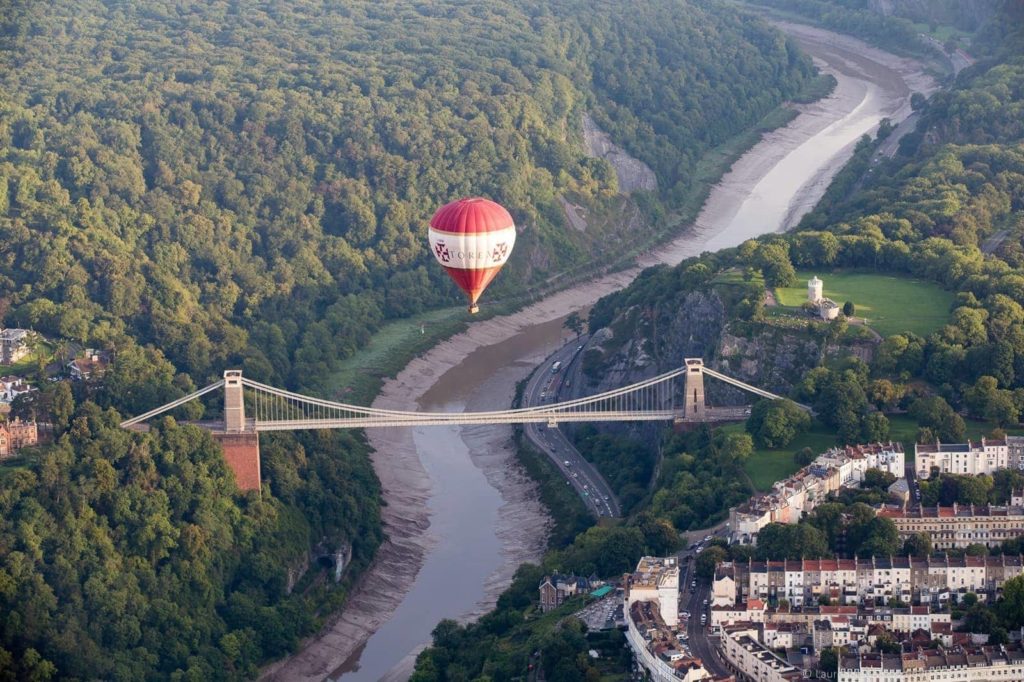
I can highly recommend taking a trip round the SS Great Britain when you’re in Bristol. Built in 1843, and designed by the engineering genius who was Isambard Kingdom Brunel – the man who almost single-handedly revolutionised both engineering and public transport in the UK.
The SS Great Britain is notable as being the first steamer to cross the Atlantic – setting a record pace for the time of 14 days. An amazing bit of history. Note that tickets are slightly cheaper if you book them online, which you can do online here .
For more ideas in Bristol, check out our guide to things to do in Bristol , which should give you plenty of ideas to fill your time. Find the best prices on Bristol hotels and book here .
From Bristol it’s on to the Roman spa city of Bath, a world heritage site. Like Oxford , this is a difficult place to be anything other than a tourist, but it is so worth it all the same!
Day 15: Back to London, via Stonehenge!
Our last day of our just over two week UK itinerary takes us back to London. No trip to the UK though would really be complete without taking in perhaps our most famous monument – the circle of rocks known as Stonehenge.
There is just something about the place that makes you wonder. A circle of rocks, built by a people who had nothing but their hands and some bits of wood to help them out, in the middle of the Wiltshire countryside, hundreds of miles from an actual quarry, is just mind blowing.
Add in the pagan ritualism, the relationship between the rocks and the sun, and the sheer mystery of the place, and you have somewhere that is capable of really capturing the imagination. Worth your time to visit (see more thoughts from a trip to Stonehenge here ).
Plus, while you’re there you can pop into Salisbury and enjoy the cathedral, which boasts the highest cathedral spire of any church in the UK.
And then… back to London, where this tour finishes!
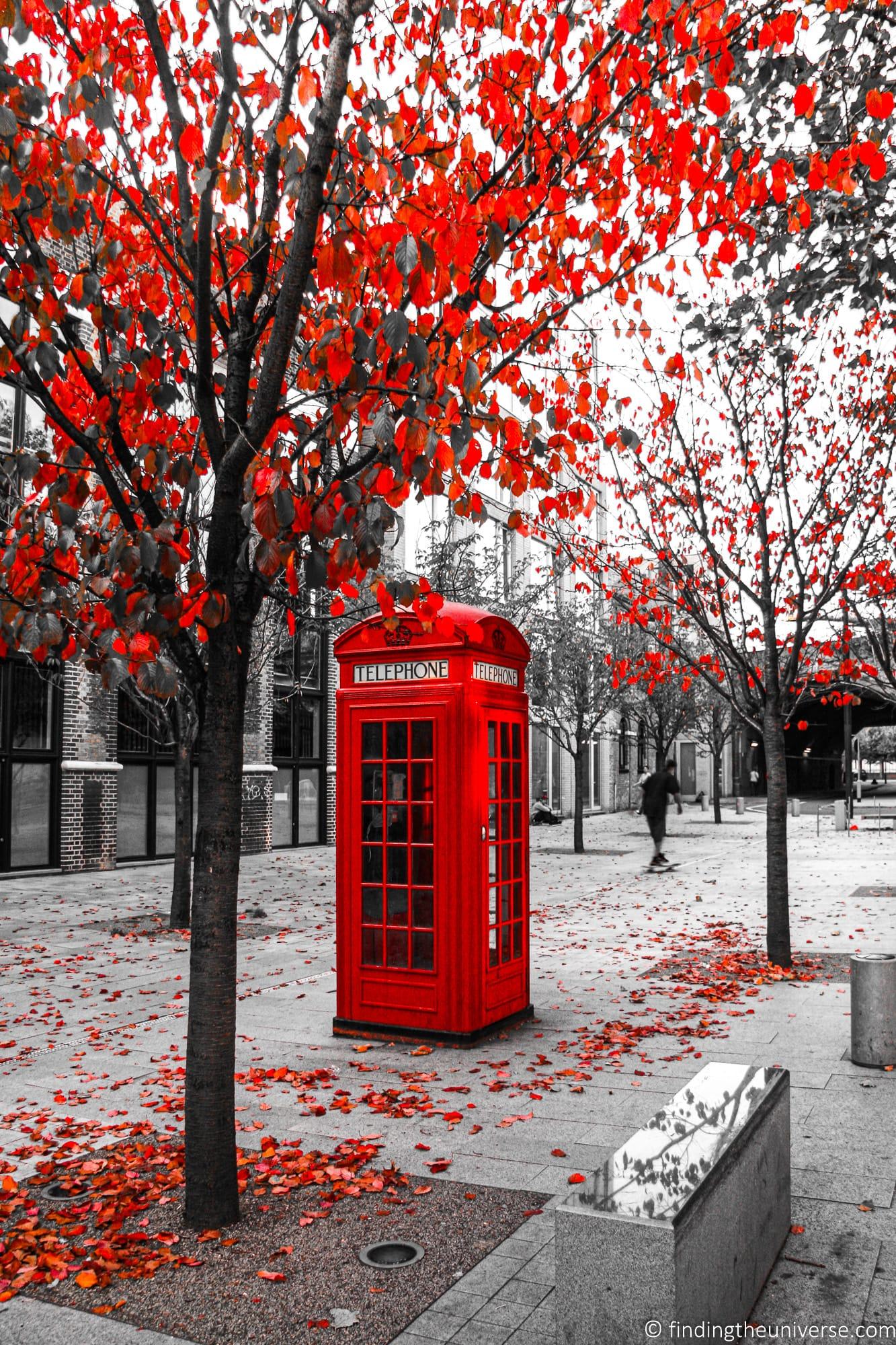
2 Weeks in the UK: Road Trip Map
Here’s a map of the route , for your reference.

2 Week UK Itinerary Summary
- Days 1 & 2 : London
- Days 3 & 4 : Oxford & the Cotswolds
- Days 5 & 6 : Peak District and Manchester
- Day 7 : York
- Days 8 & 9 : Edinburgh via Northumberland
- Days 10 – 12 : Ireland
- Day 13 : South Wales and Cardiff
- Day 14 : Bristol & Bath
- Day 15 : Back to London, via Stonehenge!
Can you do this 2 Week UK itinerary by public transport?
A popular question from readers is whether or not this itinerary can be done by public transport. I appreciate that of course not everyone wants to drive in the UK, and the answer, for the most part, is yes.
Certainly, between the major cities on the itinerary there are good rail and/or bus links, with the train usually being a little faster. The main challenge is the rural sections of the route – for example, exploring the Cotswolds, Northumbria or the Peak District. This is possible using local buses of course, but it can definitely slow you down a fair bit, and so you would need to adjust the itinerary a little to fit the schedule.
Another option is to add in some days in London or Edinburgh, and doing some specific day trips from these cities to take in the out of town attractions.
For example, there is this day trip from London that takes in highlights such as Bath and Stonehenge. Then, for Northumbria and the Scottish Borders, including beautiful Alnwick Castle, consider this tour from Edinburgh .
If you are interested in doing this itinerary by public transport, check out my guide to taking a 10 day UK trip by public transport, which as well as a route, has lots of ideas for how to book different forms of transport in the most effective and cost-efficient way.
What About Touring the UK With A Tour Company?
Another popular question is whether or not this sort of trip can be done with a tour company, and if we have any companies we would recommend for this.
So you have a few options for doing this which I have outlined below.
The first option is to take a group tour of the UK. There are a number of companies offering small group tours – we’d recommend finding a service which operates tours of 15 people or less. We usually use and recommend Rabbie’s Trail Burners , who operate trips around the UK and Ireland, and have a number of tour options to choose from.
We haven’t found a tour that exactly matches our UK wide itinerary, but we still have a solution for those of you wanting the do a similar trip as part of a guided tour.
First, we recommend you spend two or three days in London, following our suggested London itinerary .
Next, we recommend you take something similar to this small group tour , which takes eight days to take you from London to Edinburgh.
In Edinburgh, you can spend a couple of days following our Edinburgh itinerary , after which you can easily fly to either Belfast or Dublin direct from Edinburgh.
Here you can either explore these lovely cities, or take a tour to explore more of the country, we’d recommend either this three day tour of Northern Ireland or this three day tour of the southern and western coast .
Alternatively, if you’d prefer to skip Ireland, you could take something like this five day tour of the Scottish Highlands and Skye .
Finally, you can either return to London, or have your flights home depart from Dublin or Edinburgh, depending on your tour choice.
The other option is a bespoke tour company and/or a private tour guide, who will be able to put a tour together for you, including guiding, transport and accommodation.
Of all the options, this will generally be the most expensive way to travel, but it will also give you total flexibility in terms of your trip and schedule, plus you’ll have a guide with you every step of the way, taking all the hassle out of your trip.
For this sort of tour, we recommend the services of Robina Brown, who is a blue-badge guide offering tours across the UK. See her website here .
When to Visit the UK
You can visit the UK at any time of year, although for the best weather and longer daylight hours, we’d definitely suggest visiting in the warmer months – from May to September. May is probably our favourite time of year, the weather is usually quite reasonable but the tourist crowds are not too intense.
Christmas, and the period leading up to Christmas, can also be a wonderful time to visit, when the streets and shops are all brightly lit and decorated for the festive season. For a good example of this, check out our guide to visiting Edinburgh at Christmas .
Where to Stay in the UK:
For accommodation , there are a great many options to choose from, ranging from cosy B&B’s through to upmarket hotels, and everything in between. Finding the best deal on your accommodation is an important part of trip planning – helping you to get the most from your budget, as well as find the property that is right for you.
- We’ve tried a lot of booking sites, and nearly always find ourselves using Booking.com. They have an extensive selection of properties, many with no-fee cancellation policies, and often run discounts and special offers. Click on each city title to see their listings: London , Oxford , Manchester , York , Edinburgh , Dublin , Cardiff and Bristol .
- If you prefer an apartment or more of a hosted stay, then we recommend Plum Guide . We’ve tried all the others, and in our experience Plum Guide consistently has the highest quality options for the locations they are available.
- If you can’t find what you want on Plum Guide, or you want some new options to try out, we wrote a whole post on the best alternatives to AirBnB , as well as a guide to our favourite holiday cottage accommodation in the UK , which you should check out!
Between these options, you should find the best prices and places to stay for your trip, as well as a good selection of reviews and feedback to help you make an informed decision.
How to Get Around the UK
For this kind of trip I also obviously recommend that you look into renting a car. We have used and can recommend Enterprise Car Rental , they usually have great rates, especially for one way rentals. We also recommend comparing car prices using a service like Discover Cars , which compares prices across a range of providers to help you find the best deal.
A hire car will give you a lot more flexibility than public transport, and prices are generally fairly reasonable. However, if you would prefer to do a trip like this by public transport instead of driving yourself, check out our UK itinerary by public transport for ideas.
Another option for travelling in the UK is to hire a motorhome. Whilst this might not be practical for a city focused trip, you might prefer it if you are planning on visiting more rural locations.
For campervan rental we suggest checking out Motorhome Republic . They offer a campervans from a range of companies at different price points, so you can find the right one for you. You can see their UK listings here .
Further reading for your UK Trip
We’ve got lots of resources to help you plan your trip to the UK, from posts we’ve written ourselves to third party content we’re happy to recommend. Here it is:
- If you want a shorter trip, taking in some more off the beaten path destinations, check out this one week itinerary of the UK that I put together. If you’d prefer not to drive yourself, we also have a 10 day UK itinerary by public transport .
- To prepare for your trip to the UK, we’ve put together a detailed UK packing list which covers both London and the wider UK at any time of year
- This is a self-drive trip, so you should definitely check out our guide to driving in the UK for helpful tips.
- We also have a guide to how much it costs to travel in the UK which will help you cost out a trip like this.
- A guide to driving Scotland’s epic North Coast 500 , as well as accommodation options on the North Coast 500
- When you’re near Glasgow, you should check out the beautiful Devil’s Pulpit in Finnich Glen
- A two day Edinburgh itinerary & 21 Highlights in Edinburgh
- Edinburgh: Getting off the beaten path
- A Two Day Glasgow and Loch Lomond itinerary
- A guide to 10 of the best Stately Homes in England , to give you some ideas as you plan your itinerary
- For London, we have some detailed itineraries to help you plan your visit. These include a 1 Day London Itinerary , a Two Day London itinerary and a Six Day London itinerary
- The top Harry Potter sites in London
- The Best Photography Locations in London
- Tips on Buying and Using the London Pass
- Eight Things to Do in Kensington
- The Highlights of Oxford
- Our guide to things to do in Cambridge
- Visiting Blenheim Palace and the Cotswolds
- 20 Things To Do in Dublin , a 2 day Dublin itinerary and a 3 day Dublin itinerary
- A Guide to Touring the Scottish Borders
- Getting online when travelling in a foreign country can be daunting – check out our guide to getting online when travelling to help you figure out the best options for your trip
- If you’re interested in getting better photos when you travel, take a look at my online photography course , where I’ll teach you everything you need to know about getting better photos – whatever camera you have!
- If you want a physical (or digital!) book to accompany your travels, then Amazon do a good line in UK Travel Guides , and there is naturally a Lonely Planet and a Rough Guide to the UK available.
If you’re planning on visiting a number of historical properties, there are a couple of options you have for saving money as a visitor to the UK. Two main organisations exist to preserve these properties, the National Trust, and English Heritage.
Both of these organisations offer specific passes for visitors to the UK, which represent great value for money for visitors.
For the National Trust you can pick up a National Trust touring pass . This is valid for 7 or 14 days, and gives you access to every National Trust property in the England, Wales and Northern Ireland.
For English Heritage , you can get an English Heritage Overseas Visitor Pass . This is valid for 9 or 16 days, and gives you access to every English Heritage property in the UK.
Alternatively, you can also buy a full membership to these organisations, which will last a full year. You can buy an English Heritage Membership here and a National Trust membership here .
So those were my thoughts for taking in a slightly longer than two week trip in the UK. I’ve obviously missed out a great number of places, as no two week trip can possibly hope to see everything, but I’d like to think I covered a great many highlights of this truly fascinating country.
As always, if you’ve got any thoughts on this post, do hit up the comments below!
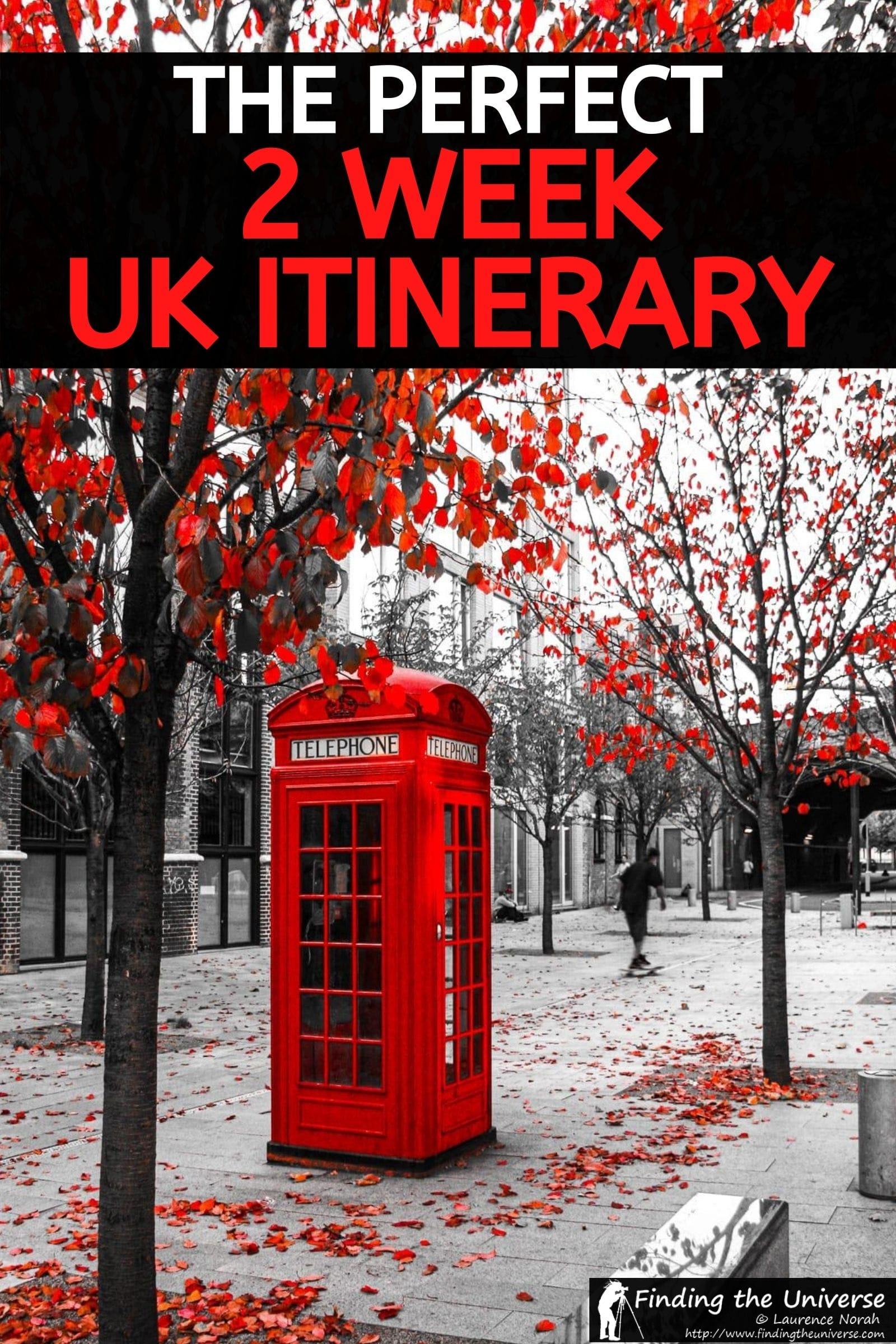
Enjoyed this post? Why not share it!
There are 219 comments on this post
Please scroll to the end to leave a comment
25th February 2024 at 6:30 pm
Hello, we are planning a trip this summer. On my list is scotch tasting in Islay. How many days should we add? Do you have any recommendations?
Laurence Norah says
25th February 2024 at 9:28 pm
Sure thing. Islay is beautiful and very much worth a visit. I’d suggest spending a couple of day at least if you can spare it as it takes a bit of time to get to and from the island and there is plenty to see and do there. I have a guide to things to do on Islay which might help. In terms of whisky distilleries, if you have a favourite whisky that I’d obviously recommend going to that distillery. My favourite whisky is Laphroaig, so I enjoyed visiting that distillery particularly. However my guide to Islay lists all the currently active ones so you can make a choice as to which one you prefer.
Have a great trip!
Marcelo Gurgel says
18th January 2024 at 11:52 pm
Hello ! Your post is very good ! I would like to do a similar tour, but on a motorcycle. Including Isle of Man where the TT Isle of Man race will take place. Please for I leave the bike on the London side and take the Ferry by foot and the best option? Cheaper in this case? How much do ferries generally cost? Where do I search for tickets and itineraries? Thanks a lot for the help !
19th January 2024 at 12:02 am
Hi Marcelo,
Thank you! So the only company which operates ferries to the Isle of Man is the Isle of Man Steam Packet Company, and the best way to book a ferry is directly on their website here . They operate services from Heysham, Liverpool, Belfast and Dublin.
If you plan on visiting during the TT race then you should book as soon as you can as this is a very popular event.
The price will vary depennding on when you go but it is definitely less expensive to go as a foot passenger. Looking at a route, it’s around £40 – £50 one way for a foot passenger, and £120 – £140 for a passenger with a bike. However, remember that you will need to pay to park your bike somewhere secure, and you will also need to have transport on the Isle of Man. Also, at more popular times, such as during the TT races, prices can be higher.
I hope this helps, let me know if you have any more questions! Safe travels!
PAUL BASILE says
10th December 2023 at 10:20 pm
stumbled across your blog and was pleasantly surprised! my wife and I will arrive in London on 6/19/24 in advance of Wimbledon where we’ll be staying from 7/5 though 7/10. we want to sorta do your route in reverse, heading out of London straight away renting a car, and heading out. we have around 2 weeks and want to start heading to Ireleand, then Scotland, then visiting cousins in Durham in northern GB, returning car in London before wimbeldon.
would love to get some advice on that reverse route, forgoing the London stuff until later, but wanting your insights on anything else! thanks in advance!
13th December 2023 at 12:19 am
It’s great to hear from you. So you can do the route either way without any issue. The main thing if you do decide to include Ireland is to be sure to check if the car rental company you choose allows you to take the car on a ferry to Ireland. Some will and some won’t, you’ll just want to confirm before booking. Otherwise I think you have the structure of a good itinerary. You can follow my route and just adjust it to suit your interests and available time. I’d definitely recommend booking in advance for places to stay and the ferries as you are coming at a popular time for travel so things will start to book up. Otherwise, just have a great time and let me know if you have any questions!
13th December 2023 at 2:38 am
Lawrence….thanks so much…great info on the ferry and booking places….do you have a fav booking site for places to stay?
13th December 2023 at 3:37 am
It’s my pleasure! We primarily use Booking.com when we travel because we like the filters. We usually filter by rating (8+) and then depending on the trip things like having free parking (handy for a road trip). Then things like WiFi, laundry, free breakfast, free cancellation, depending on what we are doing. Also like that you can apply the filters to the map view (again, handy for road trips). You can also book apartments. We also use various other sites depending on where we are going, some places have more AirBnB options. In the UK we also book holiday cottages but for a trip like yours which will likely have more shorter stops I’d say hotels or B&Bs are likely to be an easier option as apartments often have the extra overhead of needing to arrange check in and check out times.
Let me know if I can help any further 🙂
Linda Haddock says
2nd December 2023 at 7:38 am
Hello, thank you for this helpful blog! Do you have any recommendations on when, where and what to include for sites for a JRR Tolkien fan?
2nd December 2023 at 8:46 pm
It’s my pleasure. So Oxford would be my main recommendation as it was here that Tolkien studied and worked. Fun side story, a dear friend of mine was Tolkien’s Doctor and knew him well, although he has now passed. Anyway, Tolkien studied at Exeter Collge in Oxford and was also a fellow at Pembroke College and Merton College, so many of the sights in Oxford like the Radcliffe Camera and Ashmolean museum would be of interest. The Bodeleian Library in Oxford (the Radcliffe Camera is part of this) does have the originals of many of his works but these are not usually on display unfortunately.
I hope this helps a bit! Have a lovely time in the UK and do let me know if you need any more input 🙂
Ingrid Ermanovics says
24th May 2022 at 3:45 pm
Hi, Love your blog. I hear that the traffic in July can be daunting and cause very long delays. As such, would you still recommend a private car hire (car rental)? Or have other suggestions to avoid the issue? Thanks!!
24th May 2022 at 4:33 pm
Thanks very much! So in my experience, the main factors that contribute to traffic in the UK are road works, which can happen at any time, and travelling at specific times. For example, when there is a public holiday on a Monday or Friday, this tends to lead to a lot of holiday traffic. So avoiding those dates makes a lot of sense. July is not particularly worse in my experience, it can be a bit heavier, but it’s not normally awful unless you are unlucky and encounter an accident, or there are road works. I would advise against trips on Friday or Sunday afternoons, as this is when the traffic can be quite bad at any time of year as people go away for or come back from the weekends.
I’d also advise using an app like Google maps with real time traffic, and trying to plan your travel times so they don’t align with the busier times of day. In general though, i would still recommend using a car rental even in July 🙂
I hope this helps!
Debbie Hebert says
16th May 2022 at 12:16 am
Hi Laurence and Jessica, this trip looks super fun and we are looking to visit July-Aug of this year starting in Dublin (as the airfare is best to there from our home in New Orleans). Just a few questions. Would you suggest going North or South from Dublin? How many miles is the entire itinerary? Is there is a stretch where we could ditch the rental car and take the train and then pick up another car? And/or if we drop off the car before and after London and train in which cities would be best to do that? Thank you so much!
16th May 2022 at 3:11 pm
Thanks Debbie!
So I’d probably recommend dropping the rental car in Belfast or Dublin and then flying across to Cardiff or Edinburgh, depending which way you go. Many car rental firms don’t allow for rentals to be taken on the ferry, plus you have to pay more to transport a car, so this would likely save you money.
Direction wise in Ireland, it really depends what you want to see. In the Republic of Ireland you have lovely landscapes and places like the Dingle peninsula and Ring of Kerry. If you head north to Belfast (also a lovely city), then you can visit places like the Giant’s Causeway and the Coastal Causeway route.
Putting a mileage total on the entire itinerary is tricky as there are likely to be many detours but I’d say a ballpark of 1500 – 2000 miles seems about right. In terms of areas where you can drop the car and take public transport, a lot of this will depend on what you want to see. If you are happy with primarily cities, then you can easily get around between cities with a train instead of a car. So for example, Edinburgh to York, York to Manchester, Manchester to Bath and Bath to Oxford would all work. Then if there were specific day trips you wanted to do there’s the option to either rent a car for that day, or take a day tour. But if you are thinking of spending more time in the countryside and smaller towns, then a car would be a lot less useful. I’d definitely recommend against taking a car into London, and dropping it off somewhere like Oxford or Reading before taking the train into London.
Farooq Ghouri says
6th May 2022 at 2:56 am
Hi Laurence and Jessica We are visiting UK this summer for two weeks. Your two weeks itinerary is great resource for us. I wonder how we can squeeze Wales in it . Any suggestions will be much appreciated We will be using rental car Sincerely Farooq Ghouri from Chicago USA
6th May 2022 at 9:44 am
Thanks very much! So the southern part of Wales is included in this trip on the return from Ireland. However, if you wanted to add Wales your main option would be to do it as you drive north, or to consider skipping Ireland and to drive back down through Wales to Bath. The second option might be easier as it cuts down having to think about a ferry / flight across to Ireland, but it’s up to you. This itinerary is already very busy, so adding more to it as it exists would be a bit of a challenge in my opinion.
Let me know if I can offer any further advice, and have a great time in the UK!
6th May 2022 at 5:06 pm
Thank you much Laurence I will keep your suggestion in mind when finalizing the itinerary
Heather says
28th April 2022 at 2:35 am
I noticed your recommended the The Resident Victoria and I was wondering if I could ask you a few questions. I will be travelling with 3 people, one of which is a full time wheelchair user. Do you think the room size is adequate for a 5 day visit? Did you happen to notice if the showers were roll in or a wet room with chair? I realize most hotels only have accessible showers and whatnot in certain rooms so will understand if you don’t know. I found your travel blog a month ago and love it. Thanks from Canada
28th April 2022 at 12:01 pm
Hi Heather,
Sure thing. So, the first thing to be aware of is that rooms in central London tend to be quite small, especially if you are used to the size of hotel rooms in North America. Another thing to be aware of is that baths are quite common, and having a shower over the bath rather than a separate stall is also fairly common. So if looking for an accessible room it’s really important to specify that, and it’s always worth checking with the hotel what that actually means.
I would say that none of the rooms in the Resident Victoria would really be suitable for three adults to share for a longer stay, if that was what you were thinking. The superior rooms do have the option for three single beds, but these are not accessible rooms. In general, the rooms are fairly compact and I think a wheelchair user in particular would struggle in their standard rooms.
If you were thinking of separate rooms, some of their King Rooms are accessible so that would be an option. I called the hotel this morning and they confirmed that it is their King rooms which are accessible and the showers in these rooms are fully roll in. The toilets and sinks are also accessible. They can also provide a chair in the shower if you want. However these are definitely rooms for two people.
I hope this answers your question! The property is very well located for sure. Let me know if I can offer any further advice. I also have a full guide to where to stay in London which has a lot more options 🙂
13th April 2022 at 11:47 pm
Hi Laurence,
Was very interesting to read this trip. But it’s more suitable for adults without kids to travell to Ireland within two weeks. Can you please look for following trip plan: We are 2 adults + 2 kids (12 and 10) for 14 days. My daughter likes Harry Potter, so preference on these kind of attractions. So i wanted to divided for following parts: 1. London 5 days –>>> museums, parks and so on. 2. Warner Bros. Studio Tour London 1 day 3. Oxford or Cambridge .. yet not decided… for one day + Windsor Castle 4. Rent a car(or by train) and drive to the north >> York 1 day Manchester + Alton Towers – 1 day 5. Drive to south Birmingham (Cadbury world + other attractions) – 1 day Costwolds area – 1 day Bath + Stonehenge – 1 day Total 12 + 2 days (driving + bufffer for other changes during the trip)
Do you think is it good? What to add or remove? Or continue to Edinburgh and cancel some places in current trip? Thanks in advance Sam
14th April 2022 at 11:23 am
Great to hear from you. I agree, trying to include Ireland on the trip would be challenging with family. I think your itinerary sounds good, spending more time focusing on a smaller number of areas is a good choice. For your options, I think I might suggest Oxford over Cambridge if your daughter likes Harry Potter as there are quite a few filming locations in Oxford (see the Oxford section of our Harry Potter guide here ). I would also probably allocate a whole day to Oxford and maybe do Windsor Castle on one of your days in London. Oxford is very easy to reach by train from London so makes an easy day trip, but the day might feel rushed if you include Windsor as well.
I think otherwise your itinerary sounds good. A car will make things easier for sure, especially for things like exploring the Cotswolds and getting to Alton Towers. These are doable by public transport but it will take up valuable time. I also think focusing on England is a good idea. Depending on how much of a Harry Potter fan your daughter is you might consider stopping at Gloucester as well to see Gloucester Cathedral, which was used for various Hogwarts scenes .It’s a spectacular cathedral and lovely city in its own right as well, easy to see in 2-3 hours between Birmingham and Bath before dipping into the Cotswolds.
Have a great trip – let me know if you have any questions!
Vincent Choo says
12th April 2022 at 11:04 am
Laurence, My family and I ( 4 of us intend to tour Great Britain for 2 weeks before joining our friends in Belfast to continue another 10 days covering the island of Ireland. We intend to travel with a combination of car, train , ferry and air and hope to have your recommendation on which sectors should I use the above modes of transport. The intineary is roughly the same as your 2 weeks ( loop from London and ends there ) Thank You
12th April 2022 at 2:43 pm
Hi Vincent!
This is a great question, and the answer will come down to both budget and your interests.
If you are primarily interested in cities and larger towns, then travelling by rail might be easier for the majority of your trip. You can get between most cities and towns quite easily by train, and if you book well in advance you can also get cheap fares. You can also use a Friends & Family railcard to save even more. Travelling by train has the advantage that you don’t have to worry about car rental costs, fuel costs and finding car parking, the latter of which can be a challenge in many cities. I’d definitely advise against a car in London at the very least.
If you prefer a mix of city sightseeing and countryside, then a car is going to be more useful as most countryside sights and places like the Lake District are going to be a lot easier to get to and around with your own vehicle. I’d just suggest leaving the car out of the London part of the trip, and remembering to think about parking and fuel prices as part of your budget. I think a car might end up being slightly more expensive than public transport, but honestly the car rental market is so turbulent these days it’s hard to know without doing the math.
My recommendation would be to fly to Ireland – low cost flights with budget airlines will likely be the best option, and most car rental companies actually don’t allow for their vehicles to go on a ferry. Then you could pick up a hire car in Ireland on arrival.
It sounds like you have a great trip planned – let me know if I can offer any more input!
Sanchay says
7th April 2022 at 8:05 pm
Hello, Im planning a 2 week trip which shall include England, Wales, Ireland and Scotland during the month of October 2022. Is it feasible to cover all the places in 2 weeks considering that we are a group of 6 adults and 2 children ( 11 and 12 yrs) or shall we skip any of the destinations. We shall use Public transport in London and prefer Self drive cars / Trains / Ferries elsewhere. I also want to know if you could share some ranch stays where in we can stay and enjoy the country side instead of hotels. Awaiting your kind suggestion
Thanks and Regards 🙂
8th April 2022 at 11:04 am
Hi Sanchay,
Thanks for your comment. So I would probably recommend that you focus on maybe a couple of countries so you can enjoy yourself a bit more. I would probably recommend perhaps the mainland UK, as the extra effort required to get across to Ireland will eat into your time with two weeks. So perhaps a trip which includes London and Edinburgh, and then areas like the Lake District and / or Wales. One thing to be aware of is that the weather in October can be a bit variable, so spending more time in the cities might be more appealing rather than the country side where the weather might not be suitable for a lot of outdoor activities. Of course, you might be lucky and get good weather, but this is not guaranteed.
For ranch stays, probably the closest in the UK would be countryside B&Bs. Some farms do have accommodation option, and there are some lovely self catering options in the country as well.
Have a great trip and let me know if you have any further questions!
Derek Bowen says
2nd June 2021 at 5:16 pm
A really good trip, but I would skip Manchester and head right up through Rawtenstall, up through Burnley and Nelson. This would be a really good look at the cotton industry as well a real feel of northern England, as well as the best fish and chips. Then carry on up through Skipton, trying to time market day, and over to York, which is a must.
3rd June 2021 at 12:53 pm
Thank you Derek! For sure, there are so many ways to change this route depending on interests, and your suggestion is a good one 😀
Patrick Russell says
22nd March 2021 at 5:18 pm
This is absolutely amazing itinerary. What would a rough cost be for a trip like this? Minus airfare, and passports.
Thank you, Patrick
22nd March 2021 at 5:23 pm
Thanks Patrick! So it will vary quite a bit depending on your travel style. The main costs on a trip like this are transport, accommodation, food and attraction entry. Accommodation will obviously depend on how comfortable you like to travel, and food will also vary a lot depending on if you prefer fine dining or simpler fare.
To help cost a trip like this I put a guide to the costs of travelling in the UK in a post, which should give you some guidance 🙂
https://www.findingtheuniverse.com/cost-travel-uk/
Hope this helps!
Matthew says
8th December 2020 at 2:51 pm
Interesting itinerary. As a British person, rather than a traveller, my comment would be it doesn’t have much of the coast in, though I understand the time constraints. But a trip to the UK with no seaside towns! At least add Brighton, easy to reach from London. Dorset isn’t too far either, and has a fantastic coast. Also, Chester is beautiful and well worth inclusion.
8th December 2020 at 2:52 pm
Hey Matthew,
Great feedback. When I wrote this guide initially it was in response to a specific request, but of course there is so much of the UK that it doesn’t cover for various reasons (including time restraints!). I always encourage folks to use it as a rough guide, but to modify it for their own interests 🙂
Thanks for stopping by!
Tammy Howard says
25th February 2020 at 11:07 pm
Dear Laurence,
Thank you so much for this itinerary. It is fabulous!! We would like to sleep in a castle while on our trip. Are there any that you know of that allow this along this route?
26th February 2020 at 11:20 am
Dear Tammy,
My pleasure! So yes, there are quite a few options along the route, depending on your budget. Some options to consider:
Thornbury Castle – just north of Bristol
Glenapp Castle – just south of the Scotland – Ireland ferry crossing. We’ve stayed here and it’s wonderful
Kilkea Castle Hotel – south of Dublin. We’ve also stayed here.
Cringletie Castle Hotel – about a 40 minute drive south of Edinburgh. Another of our favourites.
Of course, this is just a small selection – there are many more across the UK to choose from, at a range of budgets. One tip when staying in a castle hotel – some of them have built more rooms outside the castle itself. So make sure when booking that you get a room that inside the castle (I think otherwise it sort of defeats the point!).
Have a great trip, let me know if you have any more questions!
Abdiaziz says
29th February 2020 at 8:27 am
How much will I pay if I want to travel next month
29th February 2020 at 10:14 am
Hi Abdiaziz,
March is not too busy a month for travel in the UK, so prices should be reasonable. To figure out your costs for this trip, see our guide to how much it costs to travel in the UK 🙂
Dhaval says
3rd February 2020 at 9:17 am
Hi Laurence, Thanks a lot for this amazing itinerary. We are a group of 4 adults + 4 kids (1Y,3Y,5Y,7Y) and are planning a 15 days trip to the UK. This will be our first time. Can you please assist us with the below queries:-
1. Considering we have small kids, what is the best mode of transport to travel from London to Edinburgh to Dublin? Should we keep one separate day for travelling in our itinerary? We will also have Kids Strollers everywhere we travel. 2. We want to do Day tours from London to Oxford, Cotswold, Stonehenge, Bath etc keeping our base in London. But few of my friends suggested that the Local operators don’t include kids below 5Years and we will be forced to take a rent a car. Any suggestions? 3. Also if we follow your above itinerary, can you guide us the exact cities in which we need to book our apartments/hotels to avoid hassle-free travelling.
Thanks a lot in Advance. Cheers 🙂
3rd February 2020 at 2:45 pm
My pleasure 🙂 I will do my best to help of course. To answer your questions:
1 – From London to Edinburgh I would recommend the train. This takes around 4.5 hours and will be a lot quicker than driving / taking a bus, plus you will have more space for your stroller / bags etc. You could fly too, but as it will take time to check everything in, go through security etc, I think the train will be easier. Just be sure to book your train well in advance to get a good price, and be aware that if you book a ticket in advance, you must take the booked train, the ticket will not work on a different train, even on the same day.
For Edinburgh to Dublin, your only option is realistically to fly.
2 – This is correct, for safety reasons most group tours do not accept children under a certain age, which is often 5. However, you can instead book a private tour. For a group of eight of you this should not work out much more expensive than a normal tour, plus you will be able to customise the itinerary. So I would advise reaching out to private tour operators who should be able to assist.
3 – All the cities are in the itinerary, you would need to stay in whichever ones you want to visit that don’t fall within the day tours you wish to take from London.
I hope this helps – have a great trip and let me know if I can help any further,
Serafina Macdonald says
11th January 2020 at 9:09 pm
Hi there, we are planning a trip to England, Scotland, and Ireland at the beginning of July. We are thinking about 16-18 days. I looked at your itinerary and love your suggestions! My husband does want to spend a half-day in Liverpool and I think we can tweak your itinerary to fit it in and try to do Isle of Skye as well. Since we do have the few extra days at the end of the trip, do you think it would be worthwhile to travel over to the other coast of Ireland to explore that side? (Galway, Aran Islands). Would love some suggestions.
11th January 2020 at 9:18 pm
Hi Serafina!
So Liverpool would definitely be an easy addition to the itinerary. The Isle of Skye is a bit more of a trek, as it’s a five hour drive each way from Edinburgh, so I’d suggest allocating at least 3 days for that, one day each for the drive and one day to actually explore. So do keep that in mind.
For Ireland, absolutely. The west coast is stunning, and if you can find time to head over there I would definitely suggest doing so. There’s a lot to see over there, so the hardest part will be choosing, but certainly the Cliffs of Moher, Dingle Peninsula and Ring of Kerry are some good candidates for your shortlist 🙂
Have a great time, and let me know if you have any more questions!
12th January 2020 at 2:15 pm
Thanks so much! Looking forward to this trip!
3rd December 2019 at 9:40 am
Dear Laurence, This is the first time I visit UK so could you help give a good advice to have plan visit UK during time 24th Dec- 08th Jan
Thanks Duong
3rd December 2019 at 6:11 pm
Thanks for your message. The majority of the information you need should be available on the site, both in this post and in the posts I link to. I am happy to try and help answer any specific questions you might have – is there anything in particular you are worried about?
The main things I would suggest, depending on where you are travelling from, are to plan what you want to see, to plan your accommodation and transport, and to pack properly for winter. Obviously you are visiting over Christmas and New Year, which is a busy time of year, so if you have not booked your accommodation yet you will definitely want to look into that, especially over New Year as that can be a busy time for both travel and accommodation.
Let me know if I can offer any more specific help for your trip,
Hang Tran says
26th November 2019 at 3:59 pm
Hi Laurence, Thank you for your advice and emails. I was able to put together our 2-week itinerary in England. I changed our lodging to London instead of Heathrow and booked different places when we travel around with our Britrail passes. I can’t say thank you enough. It’s very helpful for us. We will stay in London (3 days), Edinburgh (3 days:Edinburgh and York), Bristol for 5 days, Bath for 2 days and travel to other nearby cities (Stonehenge, Oxford, Cardiff) by train to make one-day trip. Is it right time to visit Cardiff in winter? If not, do you have any other places to spend a day? We’re thinking about Liverpool but it takes about 3-hours ride. If so, what should we can see in such a short time in Liverpool? We never ride a train before so we don’t mind riding the train everyday and enjoy the view together.
26th November 2019 at 5:20 pm
I am so pleased to have been able to help you and to hopefully make your trip a memorable one. It sounds like you have a wonderful itinerary planned now.
I would say that Cardiff is fine to visit in winter. Like many cities in the UK, lots of the attractions are indoors, so you can visit at any time of year and have a good time. Obviously you’ll want to dress warmly, but this will be the same all around the UK. Cardiff will definitely be one of the easier places to visit given its proximity. Another option would be Birmingham. I think I would probably not do Liverpool from Bristol – the 3 hour trip each way would be 6 hours on a train, so I don’t think you’d really have enough time to enjoy the city.
Let me know if I can be of any further help! We actually live in Bath too, so maybe we’ll see you 😉
28th November 2019 at 5:30 am
Hi Laurence, Thank you for the suggestion. We will look into Birmingham instead of Liverpool. We might be able to meet you for breakfast or lunch in Bath on Dec 22 or 23. I was able to find a place to stay that we can walk up or down the street to get to Bath Spa. Everything is in walking distance. Thanks to you again.
Sincerely, Hang
28th November 2019 at 7:22 pm
My pleasure – have a lovely trip. Do pop a comment here or send me an e-mail if you have some free time!
Laurel says
9th October 2019 at 7:23 am
Hi, love your itinerary of the UK. It includes much of what we want to see. Howev r, we are a senior couple of nomads from Australia and we are trying to organise a four week trip of the UK and Ireland including the islands off Scotland but we are steam train buffs and have the 10 best day trips on steam trains to try to include. Do you help with itinerary planning to include as many of these as we can but in some sort of order? If not can you head us in the right direction? We don’t need London as we have a couple of days there prior to a cruise of Norway. Is it feasible to do this trip in September and will he days still be long and fairly warm? Thanks in anticipation for your advice.
9th October 2019 at 6:16 pm
Thanks very much! So we don’t offer custom itinerary planning as it’s quite a time intensive process. We’re happy to answer specific questions and help where we can of course. Steam trains aren’t really an area of expertise though!
I can definitely answer your questions about September – I’d say September is a great month to travel. If you are lucky it might still be reasonably warm (recent years have been lovely in September), but you skip the crowds of the summer months and the schools will have gone back as well. September and May are our favourite months to travel. Of course, this is the UK, so rain and cooler weather is certainly possible (although you can get this in July and August as well!), so it’s always best to be prepared with layers of clothing, but you should be fine generally. The days will still be long, light until around 8pm depending on which part of the month you visit 🙂
Have a great trip, and let me know if I can answer any more specifics!
Kevin Ortyl says
19th September 2019 at 6:51 pm
Love the website and your two-week itinerary. Very easy to follow.. So glad we found your site. Need advice please… (Coming from Boston, USA) Thinking of a two-week vacation late August 2020 (family of 4… 2 college age kids) flying into London and out of Dublin. So similar trip you outlined but not returning to Heathrow once in Ireland. Planning on rental car and driving everywhere. Can the one way car rental work in this scenario (London, Scotland, ferry to the Emerald Isle, drop rental at Dublin)? Second Q… if we were to eliminate the Wales back to London segment how would you fill in that itinerary staying in Ireland?
19th September 2019 at 7:20 pm
Thanks very much. So dropping off the car in a different country might be a challenge. Most car rental companies will let you drop the car off in a different part of the same country, but as the Republic of Ireland is separate from the UK, that would likely be a challenge. So your best option is probably to rent the car in the UK, then drop it off at Edinburgh airport and fly to Dublin, then pick up a new rental there.
For your time in Ireland, you have a lot of options! If you are looking for a road trip the Causeway Coastal Route in northern Ireland is a favourite of ours, and the Wild Atlantic Way is also a great drive. Of course there is so much to see in Ireland and Northern Ireland depending on what you are interested in, with both Dublin and Belfast being worth a visit. It would just depend if you wanted to do more city or more country 🙂
Let me know if I can be of any more help – we have quite a few posts on Ireland as well on the site with some ideas!
19th September 2019 at 9:58 pm
Thank you for the reply, and the good information regarding rental cars.
To follow up, once in Ireland probably interested in seeing some of the quaint cities/towns, visit the pubs, little urban culture, castles, etc and those types of places in lieu of say hiking and biking. Hoping of course between destinations to see beautiful countryside and such!
20th September 2019 at 9:02 am
My pleasure 🙂 So I would suggest that driving the Causeway Coastal Route ( https://www.findingtheuniverse.com/causeway-coastal-route-northern-ireland/ ) Might be a good option 🙂
4th September 2019 at 2:13 am
Hi Laurence, I really like the two week trip itenerary. We’ll will be driving and are experienced with that. We’d like to see some worthy gardens along the suggested route. Any ideas?
4th September 2019 at 7:02 pm
Certainly. The gardens at Alnwick Castle are wonderful, as are the gardens at many of the stately homes in the UK (you can see our list of good stately homes in England here ). Not all of them have gardens of course, but that’s a good starting point. Many cities also have botanic gardens, including Edinburgh and Kew Gardens in London, which are well worth the visit.
I hope this helps a little 🙂
Rachel Sales says
16th August 2019 at 5:15 am
Hi! This post gave me lots of ideas. However, can you help me out in modifying this itinerary which will make Edinburgh as the last stop? My flight booking is DXB-LHR, EDI-DXB. I thought it will be nice it it’s an onward journey and not have to go back to my starting point. Thank you in advance!
16th August 2019 at 12:12 pm
Glad to be able to help! So as this itinerary is a loop, it’s a bit challenging to modify it that easily. My suggestion would perhaps be to drop Ireland from your trip, and instead to spend more time in Scotland. So you could follow the itinerary up to Edinburgh, and then add in time exploring more of Scotland before returning to Edinburgh. Let me know your thoughts,
Robin Major says
13th August 2019 at 12:53 am
Hello Lawrence,
I just found and love this site!! I’m trying to plan a 25th wedding anniversary trip for next September (2020) to surprise my hubby.
He’s never been to Europe. I was fortunate enough to get two and half lovely days in London a couple years back courtesy of my employer.
I’m not sure if what I want to do is totally doable though… No driving.. we would do transit and rail… I’m thinking a week in Britian and a week in Scotland. Maybe fly into London, spend two full days exploring the sites.. then I’m sort of lost. We are interested in Castles, love the supernatural aspect of York so that will be a must, definitely want to see Stonehenge.. and as odd as it sounds, my parents did Sherwood Forest and Nottingham on their 25th Wedding Anniversary many years ago so wondering if that would be a recommendation? Just not sure of the logistics for a week in Britian.. where to stay etc.
For Scotland, again, Castles and we are both big Outlander fans so we’ve have to see Loch Ness, Inverness and any and all sites made famous by Outlander. I am thinking a week up there and we fly home from either Glasgow or Edinburgh.
Do you have any suggestions/recommendations on an itinerary for us? I would greatly appreciate any knowledge you wish to share with me.
Thank you so much! Robin
13th August 2019 at 10:19 am
Thanks very much! It certainly would be possible 🙂 I’ve actually written a 10 day UK itinerary by public transport. Whilst the route isn’t exactly what you want, the post does have some useful information to help you plan your trip, especially around booking the trains etc. If you’ve not seen that post yet, it’s here:
https://www.findingtheuniverse.com/10-day-uk-itinerary-public-transport-train-bus/
Regarding your specific itinerary, I would suggest you start in London as you suggest. You could then take a day tour from London out to Stonehenge. This is doable by public transport, but is way easier as a day tour, plus they usually have some extra stops like Bath. You can read our guide to doing that here:
https://www.findingtheuniverse.com/Stonehenge-bath-cotswolds-day-trip-from-london/
So Nottingham is nice (I went to university there), but with limited time I wouldn’t say it was a must do. My suggestion would be to take the train from London to Oxford, and then up to York. A day in each location would work. You are now up to five days in England. Castles are a bit tricky by public transport as many of them are out of cities. I would perhaps suggest extending your time in London and taking the extra day to visit either Windsor Castle or Hampton Court Palace. From York you could head up to Durham which is a beautiful cathedral city.
From Durham the train to Edinburgh is not too far. I’d suggest basing yourself in Edinburgh for at least three days. Two days to explore the city, and then one day to take an Outlander tour. We have specifically done 1 day tour with Rabbies , and thought it was great. We have more suggested day tours from Edinburgh here:
https://independenttravelcats.com/day-trips-from-edinburgh-scotland/
From Edinburgh our recommendation would then be to take the train up to Inverness, from where you can explore more castles, Loch Ness and the Highlands. Again, plenty to do in this area, and there are lots of great day trips to plan. You can see our guide to some of the best here:
https://www.findingtheuniverse.com/day-trips-from-inverness-scotland/
I think that should give you plenty to work with – let me know if you have any more questions!
8th August 2019 at 9:35 pm
I just found this page and so glad I did especially your “Best Stately Homes in England” We will be visiting England and Scotland for 2weeks October 16-29, 2019 and I am excited about your itinerary. We have been to Northern Ireland (once)and Republic of Ireland (4 times) so we can leave those out, so are there any other places you might suggest? My husband has driven every time we have visited Ireland so he can handle a manual transmission. We land at Gatwick Airport and I thought we could head to Edinburgh via a easterly route and return to London via a westerly route. We do not have to travel only motorways but don’t wait too many small country lanes (did plenty of those in Ireland). Any suggestions you could make would be greatly appreciated. Love Manor Houses, Castles, rolling landscape, waterfalls, quaint English market towns or villages, etc. THANKS
9th August 2019 at 8:54 am
Sounds like you have a great trip planned, and I will certainly do my best to help. It sounds like your route is pretty good already, coming down the west side of the UK gives you the chance to pop into the Lake District, explore towns like Chester, and even larger cities like Birmingham. In terms of stately homes, well, I would obviously recommend the majority of those in my post on stately homes. I’d also add Edinburgh Castle of course if you like castles, as well as the more ruined Craigmillar Castle on the outskirts of Edinburgh. Alnwick Castle on the way up through Northumberland is stunning, as are many of the other castles in Northumberland, like Bamburgh and dunstanburgh. For rolling hills and greenery, the Lake District is lovely, but I can also recommend the Hadrian’s Wall area of Northumberland, particularly the area near Housesteads.
For quaint English towns, of course the Cotswolds would be by number one pick. The counties of Kent and Dorset are also good options.
I think that should get you started, let me know if you need some more ideas!
Christine Greentaner says
5th August 2019 at 12:26 pm
Hello!! I stumbled on your site asking google if I could do the this kind of trip and wow, here you are! Unsure of the driving though since we zero experience. However, this two week itinerary gives us something to start thinking about. Thank you so much!! Christine
7th August 2019 at 2:52 pm
Hi Christine!
Driving in the UK is definitely a bit different, especially if you are coming from a country where they drive on the right hand side. Also, if you’re coming from the USA, be aware that most cars in the UK have manual transmissions, so when you rent a car if you are not used to driving a manual you should specify an auto. I have a guide to driving in the Uk which you might also find useful 🙂
https://www.findingtheuniverse.com/tips-for-driving-in-the-uk/
Let me know if you have any questions, and have a great trip!
Danie marais says
11th July 2019 at 8:54 pm
What will it cost for 2 adults
12th July 2019 at 4:17 am
Hi Danie – this really depends on your travel style – you can see a guide to how much travel in the UK costs here for some estimates: https://www.findingtheuniverse.com/cost-travel-uk/
Margaret says
9th July 2019 at 6:29 am
HI , Just wanted to ask. I am getting a little a little worried,as our trip is getting closer and closer. Your site has helped so much. Does this sound ok to do. Day 1 arrive late afternoon explore Paddinton. Day 2 & 3 follow your 2 day guide of london sites. Day 4 train to oxford, free 2 hour tour. free time to explore oxford Day 5 train back to oxford ,pick up car. Drive to Cotswold explore.. Drive on up to peak district stay over night . 1 night Day 6 explore peak district , drive to Manchester and york .explore. Now I am unsure to travel to the Lake district Or follow onto Alnwick. as some people say not to miss out on the lake district. We dont have enought time to cut back over to Alnwick unsure . We arrive in paddington on the 20th want to leave Edinburgh 31st. So take into account at least 2 night in Edinburgh and head onto Belfast. We will then explore Belfast and Dublin for 2 weeks as we have friends there. follow onto wales Bath but we do want to stay in Southampton for two days once again friends. Can you get to Heathrow airport from Southampton We have 5.5 weeks for this trip but I do want to spend time with friends in Belfast and Dublin. I am so over whelmed .
10th July 2019 at 5:43 am
Hi Margaret!
First, I’m delighted we’ve been able to help 🙂
Your comment covers a few points so I will try to help where I can. For your itinerary, the first six days look good, the only feedback I would offer is that trying to do the Peak District, Manchester and York in one day is likely going to be too much. Even Manchester and York in one day is quite a bit. York would need at least four hours to fully enjoy it, so I might suggest skipping Manchester unless you are particularly invested in it.
For your Lake District dilemma, I can’t really answer this for you. Everyone has a different idea as to what is “unmissable”, so it really depends on your priorities and interests. The Lake District is certainly very pretty, but so is much of the UK 😉
From Southampton you can definitely get to Heathrow airport. It takes around 2 hours by train. It’s not a direct train though, so you do have to change, but it shouldn’t be too difficult. If you would prefer a direct route, I believe National Express operates a coach service between the two locations.
I think for the rest of your trip you might want to reach out to your friends and ask for their advice in terms of what to see and do. I would try to relax and enjoy yourself instead of trying to see everything and becoming overwhelmed if you can. Travel is definitely a bit of work, but ultimately it is supposed to be fun. I always find that the less planned adventures are the more fun ones. So certainly come up with a framework, but don’t spend too much time worrying about it to the tiniest detail, as it will likely detract from the enjoyment.
22nd July 2019 at 4:35 am
Thank you Laurence, Your advice is so helpful. I have added days, so we can get the most out of our trip 2 days in the Peak District, Manchester and 1 day for York. Now I am on the end part of our trip and once again would like some advice. : After spending 18 days exploring Ireland. We will be catching the ferry to Wales. 20th Fishguard pick up car, early afternoon explore the country driving towards Cardiff, Bristol Question : Unsure as to time length of time needed
I was thinking, see Cardiff, then drive towards Bristol arrive around tea time. sleep overnight and have full day to explore Bristol. 21st after exploring Bristol drive towards Bath. arrive around tea time, find somewhere to sleep for 2 nights (21st and 22nd) 22nd full day to explore Bath. 23 th drive toward Stonehenge, Amesbury, drive onto southamption return Car
24th southamption .explore Southamption see family member. we need to be at Hearthrow airport on the 26th at 9:20 flight take off , My next question is , Should I return to paddington for the 25th so I can get the express train to airport , Is my flight to early to return from southamption. Once again . please guide me. Margaret
22nd July 2019 at 6:03 pm
Hi Margaret,
My pleasure! I will try to help again. Your timings for Bristol / Bath etc seem reasonable. They are very close together, my only advice is to avoid travelling at rush hour (4pm – 6pm), as it will make your journey much longer due to the traffic.
For your second question, in theory you could get from Southampton to Heathrow in time, but it’s around a 2 – 2.5 hour journey. You’d want to check train times for the day you are going, but the earliest trains are around 5am based on my research, so you would get to Heathrow around 7.30am. So yes, it’s possible, but it depends how happy you are with an early start and also the risk of any train delays. Up to you, but personally I avoid early mornings at all costs, so would personally probably just find a hotel near Heathrow 😉
Diana Cottrell says
1st July 2019 at 1:57 am
Loved seeing your site. Very helpful since I’m trying to plan a driving vacation for my husband and myself and really didn’t know were to start. I have some questions but will start with only one. We were in London last year but I could go again. Loved it. Hubby sick and had a different feeling. Would it be hard for someone from the US to land at Heathrow and rent a car…then drive to Windsor right after landing? Is it far enough out of London to get comfortable with driving on a different side of the road?
1st July 2019 at 10:18 pm
So, funny story, after passing my UK driving test the first thing I did was rent a car and drive out of Heathrow! I’m not sure I’d exactly recommend it, you’d be driving onto one of the busiest motorways in the UK (our equivalent of a freeway) which might be quite stressful. It’s possible of course, and I’m sure many people do it, but I would advise caution. Also, make sure you specify you want an automatic as most cars in the UK are manual 🙂
3rd July 2019 at 12:01 am
Thanks for the information. Think we’ll skip Heathrow. How would landing in Edinburgh, then heading up through Scotland and back down England (maybe to Bath). Then going up through York and returning back to Edinburgh to return car.
3rd July 2019 at 2:57 pm
That would likely work quite well. My only advice, if you plan on spending time in Edinburgh, is not to pick up the hire car until you leave, as you won’t need it in the city and you’ll just be paying for car rental and parking for no good reason – the city is very walkable.
6th July 2019 at 11:11 pm
Thanks so much. Will start planning.
Amanda says
23rd June 2019 at 5:59 pm
This is such a great detailed itinerary! We are planning to get a rental car in Cambridge and then driving to Scotland from there, so some of these places we will definitely have to visit! I do have one question, about renting a car. Is there a boarder crossing fee or any other type of fee the rental company could charge to go from England to Scotland? We are planning to do a one-way trip so I know there is a fee for that, but in terms of crossing between the two countries is there a fee? When I read about the boarding crossing fee it was unclear to me if that is only if we leave the UK?
Thank so much!
23rd June 2019 at 6:02 pm
Thanks very much! There’s no fee or anything like that for crossing into Scotland, it’s not really a border like that. It’s all part of the UK, so it’s one country.
Opal joiner says
18th June 2019 at 1:37 pm
Hi Do I need to purchase a London pass and a heritage pass? Or just one pass?
18th June 2019 at 7:05 pm
It depends what you want to see and where you are travelling, but for London the London Pass will cover the majority of the attractions 🙂 I definitely recommend checking what they cover before purchasing though 🙂
Chris Ryan says
17th June 2019 at 8:44 am
From an English persons point of view this is an excellent itinerary. It would be good to include the Lake District and Snowdonia but to cover all this in two weeks would be a nightmare and far too much time on the road. The average Brit would allow at least a month for the whole trip. If only two weeks available I would suggest you save Ireland for another time, it’s sacrilage not to explore more of that country, and maybe see more of the west of Scotland instead.
17th June 2019 at 11:06 am
Thanks very much 🙂 I agree, I was actually born in Snowdonia and that part of the world is wonderful. Have spent many happy weekends camping in the Lakes as well. The itinerary was in response to a specific request – we normally encourage folks to slow down where possible and spend more time seeing and less time travelling, but unfortunately many people don’t have much leave to play with and want to try and see as much as possible 🙂
Lillie says
15th June 2019 at 2:56 pm
Hi! So glad to have stumbled upon your site, as I am planning this trip to the UK in October, and I didn’t even know where to begin. I like the idea of doing all the traveling by road ourselves since we’ll be traveling with our baby who will be 9 month old at the time. I was thinking 10 days, including Ireland, but would you consider that possible? We are really interested in doing the whiskey distillery tours in Scotland and anything and everything related to Harry Potter. We’re also interested in visiting landmarks like the cliffs and stonehenge. We’re usually good at squeezing in a lot in our vacations, but this will be the first time we travel with our son, so I don’t want to set ourselves up for failure either. Any advice on what to cut out or if we need to lengthen the trip?
15th June 2019 at 8:38 pm
So, first off, I have to say that we’re not really experts on travelling with children as we don’t have any of our own. So any advice I offer you is based on what friends and other readers have shared with us about the logistics of travelling with a young person. Of course, everyone’s experience will also be different.
Generally, most folks say that you definitely need to slow down when travelling with young children, as you have to factor in things like feeding, changes and so on. This will definitely vary though depending on age and individual personalities 😉
That said, you are trying to do a great deal in 10 days. Scotland and England are around a 6 – 7 hour drive apart, and if you want to get up into the Highlands you’re looking at another few hours. To then add Ireland would make it more of a challenge for sure. It’s not impossible of course, but it would definitely be rushed. It might be that you would be best off focusing on Ireland and Scotland on this trip, perhaps five days in each, rather than trying to see everything and just having a stressful time. Alternatively, add 3 or 4 days and include some time in England 🙂
I hope this helps a bit!
Ashok Agarwal says
15th June 2019 at 6:01 am
Wow. I looked up the WWW for a 2 week itinerary for the UK and am glad I clicked on your site, from the numerous options that sprang up. The information contained here is so so exhaustive. Not only did I get a fantastic plan but ab amazing read, too. We are planning our first visit to the UK in October and are going to follow your tips to the T. You guys are fantastic. Thanks.
15th June 2019 at 11:04 am
Thanks very much Ashok! Much appreciated 🙂
9th June 2019 at 9:56 am
Dear Laurence!
Thank you SOOOOO much for your inspirational itinerary and all other articles you provide here. They’re great help!
We are going to spend 15 days in UK in August and this is cause we’ve planned to take our son to Warner Bros HP Studio as we are all massive HP fans :). We’ll start and finish in London, though initially we want to hire a car at the airport and start a trip and spend couple of days in London in the end.
Could you kindly give us some advice / decide whether it is possible, to plan a trip considering these simple priorities: 1) we’d love to see Scotland with its green hills, waterfalls etc. 2) we would really like to visit Snowdonia 3) I guess Stonehenge is sth 8-year-old traveler to England must see 4) I personally have dreamt all my life too see PUFFINS (I mean – free puffins) 5) we can skip Irelnad, no problem 😉
I must admit – reading about UK – I am getting a bit lost in huge amount if options and sites one must visit, so I’d be grateful for some advice.
10th June 2019 at 10:57 am
My pleasure 🙂
So my first tip, if you haven’t already booked the Harry Potter Studio Tour is to do it as soon as possible as it books out well in advance 🙂 I also have a guide to visiting which you might have already seen, but just in case you haven’t, it’s here:
https://www.findingtheuniverse.com/taking-a-harry-potter-studio-tour-everything-you-need-to-know/
Then, on to the question of your itinerary. Assuming two days in London, that gives you around 12 – 13 days to play with. I would suggest you spend them as follows. Given that you are Harry Potter fans I’m also including some HP filming locations you might enjoy 😉
Day 1 – head to Oxford, overnight here. Lots of awesome history, plus lots of Harry Potter filming locations to explore. Day 2 – head to Bath via Stonehenge Day 3 – head up to Snowdonia. Will be a bit of a drive, but worth it. I’d advise a couple of days in Snowdonia to do some hiking and exploring the towns, castles etc. The roads are slower here so it will take longer go get around
Day 5 – Head across to York Day 6 – Drive up to Alnwick Castle, another HP filming location. Then continue on to Edinburgh. Day 7 & 8, Edinburgh. Lots to see, lovely castle. Where Rowling wrote many of the HP books. Note the Edinburgh festival will be on so the city will be very busy. If you decide to stay in Edinburgh, you need to book now. Also, if you want to see puffins, the Isle of May just near Edinburgh is one of the best places to get up close to them. You need to book a trip, which you can do here: https://seabird-centre.seafari-edinburgh.co.uk/forth-ferry-and-isle-of-may
Day 9 – head across to Loch Lomond and the Trossachs. Overnight here or in Oban Day 10 – head up to Fort William / Glencoe. You can ride the HP train from here, or go see the viaduct at least Day 11 – head down to Glasgow, overnight Day 12 – drive down to Liverpool, overnight Day 13 – return to London.
I would say that would be a good way to do it! We have lots more info on Harry Potter sites if you are interested: https://www.findingtheuniverse.com/london-harry-potter-locations/ https://independenttravelcats.com/guide-top-harry-potter-sites-in-edinburgh-scotland-jk-rowling/ https://www.findingtheuniverse.com/harry-potter-filming-locations-uk/ https://independenttravelcats.com/harry-potter-filming-locations-in-scotland/
10th June 2019 at 8:52 pm
Thank you a lot for your advice! The plan sounds great and we are definitely going to follow it step by step :)))
with best regards!
7th June 2019 at 9:00 am
Hi, what a great article! However, do you have any tips for hire car? Are there any fees/ extra charge or need to notice the supplier that the road trip route is involve Wales, Ireland and Scotland?
7th June 2019 at 8:37 pm
Thanks very much!
For driving in Wales and Scotland it won’t matter because they are part of the united Kingdom, so it’s still the same country.
The republic of Ireland however is a separate country, plus you have to take a ferry to get there. So that would be something you would need to check with the rental agency.
S. Steinback says
26th May 2019 at 9:16 am
Hi, my daughter and I are leaving mid August to the UK for 2 weeks. We are planning to start our trip in London. Then wanted to see Brighton, Cornwall, Wales and Scotland. We also want to see Bath and Oxford too. Is this doable using the train? We are unsure of how we should book our traveling using train, car or bus. Can you provide and manageable itinerary and recommendations on how we should travel from each place on a 2 week trip?
26th May 2019 at 11:04 am
Hi Sabrina,
So you should be able to see most of what you want to see by train. As an example, I’d suggest:
2 days in London 1 day in Brighton (train to Brighton takes about an hour, so can be done as a day trip from London or overnight) 1 day in Oxford (1 hour train from London to Oxford, overnight in Oxford) 1 day in Bath (1 hr 40 minute train from Oxford to Bath, overnight in Bath) 2 days in Cornwall (around 3 hours by train from Bath to Cornwall. You might want to take a tour in Cornwall as there is less public transport to get around) 3 days in Wales (train from Cornwall to Cardiff is around 3 – 4hours, but then you will have to plan how to get around Wales. Again a tour might be easiest) 3 days in Scotland (you can either fly from Cardiff to Glasgow / Edinburgh, or take the train, but the train will take around 8 hours)
I’d also suggest looking into Rabbie’s Trail Burners . They do a number of tours from London which might suit what you want to do and save you the hassle of planning. These cover the majority of the destinations you want to visit.
I hope this helps a bit with your planning!
Ed Hyland says
17th April 2019 at 12:01 am
Thankyou for your guide it was really helpful I am living in Argentina and j am planning on bringing Argentinian tourists to Wales and central England on a tour of castles and important historical sites .I plan on bringing groups of around 10 people and using a rented mini bus to move around. Do you have any helpful tips as this will be our first tour ,we are planning on visiting early September All the best .Ed,x
17th April 2019 at 10:56 am
My pleasure. So I don’t have any experience of running this kind of trip, so it’s tricky to give very specific advice. I am sure you have considered things like insurance and liability and so on, as well as any other legal requirements involved with running a tour.
THe only tips I have would be around admission to sights – there are usually group discounts available for attractions that you might be able to take advantage of, although you might need to call in advance to arrange these. I’d also advise to definitely book your accommodation in advance as you have a larger group.
Otherwise, I hope you have a great trip!
12th April 2019 at 12:04 am
I was planning this itinerary since I saw and had 15 days in the region. After more research I am now wondering what it takes to get a rental car from London to Ireland and back? Do you use the same car the entire trip, or would you switch cars at the water crossings in order to not have to pay to ferry the car across? Also I’ve heard rental agencies in England don’t really allow their rentals (or at least coverage) in Ireland? And yet another concern is time, I keep hearing that driving over there is quite a bit slower going than say the US, or by train, would this itinerary still give enough time to enjoy the locations or would it be quick stops and rushed in order to get to the next place? Sorry a lot of questions, just trying to decide if I need to break the trip up to just one or two countries. Thanks. And love you blogs and all the information and amazing photography.
12th April 2019 at 11:46 am
So it is certainly possible to take a hire car on the ferry, it just depends on the hire car company, and some of them charge a fee for doing so. Here’s an example of the Enterprise UK policy: https://www.enterprise.co.uk/en/help/faqs/driving-across-borders.html
Obviously you also then have to pay the ferry fee for the hire car as well. So an easier option to be honest is just to fly, for example to take a flight from Edinburgh to Belfast or Dublin. You would drop off the hire car in Edinburgh and pick up a new one in Belfast.
I appreciate this might be a bit of hassle, so certainly adjusting the itinerary so you skip Ireland is another option. In this case, I’d suggest either spending more time in Scotland, or coming down the west coast of the UK, visiting the Lakes and Wales.
The roads in the UK are definitely a bit busier and can also be slower than roads in the USA. This itinerary is definitely doable, but I’m always a fan of slowing down and seeing more, so that is a good option too 🙂
Let me know if you have any more questions!
David Cameron says
11th April 2019 at 1:56 pm
“You’ve packed up every possible solution in this one blog. I’m over the moon! I really am! How much would this trip cost, approximately? And if I’m going on this trip, Ireland will definitely be included coz from the moment I saw P.S I love you and Leap Year movie, I’ve been dreaming of visiting those places. Thank you. Thank you so much, Laurence !”
11th April 2019 at 2:04 pm
Thanks very much! So it’s hard to give an exact price as it will depend on your travel style. The best option is to cross reference this post with our guide to how much it costs to travel in the UK, which will let you come up with a budget based on your travel style 🙂
Have a great trip, and let me know if you have any more questions!
Usha Gupta says
10th April 2019 at 6:02 pm
Hi, we are travelling to London for a holiday from India. My 2 sons (29 & 27) and I are planning on spending 2 weeks in London and Wales. 13th-18th in London 19th-21st in Wales 22nd-26th in London Please advice how best to spend our holidays? We do not want to visit any of the normal places as we have seen n visited them all. What are the best places in wales to see and visit? We have not been to wales. Is it safe to take a road rrip from London to wales? Are 3 days in wales enough to get around? Pl advice
10th April 2019 at 6:52 pm
Well, there’s a huge amount to do and see in London beyond all the normal tourist things that you have likely already done. I can advise visiting Greenwich for example if you have not been out there already, and perhaps some of the palaces out of the city, like Kensington or Hampton Course. Sometimes we like to pick up the London Pass and visit some of the many attractions we’ve not been to before!
Wales is lovely but it is quite big so you will want to consider visiting a region. My favourite part of Wales is the northern part, including the Snowdonia national park and towns like Caernarfon, but there are many nice regions and places to visit. If you want to see more you will likely want a few more days in Wales.
It is certainly safe to take a road trip from London to Wales, of course, I can’t guarantee your safety, but it is no less safe than travel anywhere else in the UK 🙂
I hope this helps – have a great trip!
Usha gupta says
14th April 2019 at 3:24 am
Ty for you advise. We decided to spend all our time in London and do day trips, theatre etc.
14th April 2019 at 11:46 am
My pleasure. Enjoy!
Darlene Williams says
24th March 2019 at 6:10 pm
Lovely ideas here! My Granddaughter and I did a trip last summer to the Cotswolds, London and Paris. I’m thinking of a trip with my Granddaughter (18) in 2020 and would like to base myself in the Lakes District or Wales and take in Ireland and Scotland in a 2 week trip. Since I’ve been there I’ve decided I could probably drive it myself or possibly rent cars when needed and travel via train/bus/tours between Ireland & Scotland. I’m guessing the Highlands is probably out of reach for a 2 week trip? I would welcome your knowledge and suggestions. Thank you, Darlene
25th March 2019 at 3:44 pm
Thanks very much Darlene!
I would definitely recommend hiring a car for the Lakes – it’s a more remote part of the UK, and there are fewer public transport options, both for getting there, and for getting around. I would say that it would make for a good base, but just to be aware that the roads are not very fast in either the Lake District or Wales, so it can take a bit of time to get from place to place.
The Highlands would be achievable, but it would involve a great deal of driving, and if you wanted to head up there i would suggest that as a standalone trip, perhaps flying to Inverness (or overnight train from London), and then renting a car from there 🙂
Do let me know if I can provide any more specific information to help you plan!
Deep Shah says
22nd March 2019 at 5:43 am
Hello Laurence and Jessica,
It has been a pleasure reading about all your experiences in and around UK. I am planning to visit UK between April 22 and May 1. I am planning to start my trip from Edinburg cover a bit of scotland and than move on and end my trip in London.
Here is my itinerary Inverness (23 April) –> Isle of Skye (24 April) –> Fort William (25 April) –> Edinburgh (26 April) –> Jedburgh (27 April) –> York (28 April) –> Cambridge (29 April) –> Cotsworld (30 April) –> London (1 May)
Do you think this is doable? Or any particular section is too aggressive? Your help will really help me plan this better.
22nd March 2019 at 10:00 am
This is in theory do-able, but you will be spending a lot of time driving. From Inverness to the Isle of Skye is a 2.5 hour drive for example, and then there’s a lot to see and do on the island which will also require driving. If you are ok with lots of time driving then yes, this is doable, I just wanted to be sure you knew 🙂
24th March 2019 at 12:35 pm
Thanks for the reply. Yes, I am aware that we will have a lot of driving. But thats ok with me. Thanks again for your time. I have made the reservations to follow this itinerary. Will let you know how it goes.
Thanks for sharing all the information on your website.
24th March 2019 at 12:38 pm
My pleasure – have a great time and do let us know how it goes! You can drop in here or in our facebook group 🙂 https://www.facebook.com/groups/travelloversandphotography/
Omker Mahalanobish says
21st March 2019 at 5:22 pm
Thanks for your detailed itinerary. Looks exciting. By the way, could you please let me know, what should be the expected cost for the said trip? Further : I dont want to drive. Me and my wife would be travelling, and we would rather prefer a chauffer driven cab.
Thanks, Omker
21st March 2019 at 5:27 pm
I have a guide to how much it costs to travel in the UK here: https://www.findingtheuniverse.com/cost-travel-uk/
However, if you want to travel with a private guide, this will generally cost in the region of £500 – £800 per day for the car / driver guide, and then you would need to add accommodation expenses and so on on top of that. We recommend Robina Brown for this sort of trip: http://driverguidetours.com/
Heather Reid says
20th March 2019 at 5:20 am
This site is the most perfect one for my needs. I am a solo traveler female aged 74 and I wish my 75th Birthday be spent on the next trip. If there be another solo person I would be happy to meet up before departure….male or female.
20th March 2019 at 12:49 pm
Thanks Heather – have a great trip, and we hope you find someone to travel with!
Phillip Armanas says
5th March 2019 at 12:20 am
Stumbled over your website while looking for ideas for a two week trip to the UK, glad I did. You’ve got a fantastic itinerary which includes a number of destinations my wife and I had in mind already. We are a retired couple, living in Australia six months of the year, and Atlanta, Georgia the other six months. This gives us great flexibility in travel terms, both in SE Asia and from the USA to many places including UK/Europe. A question I have is whether you have done any family history work on any of your travels? My ancestry is Scottish in the mid-1800s when my great-great-grandfather arrived into Port Adelaide, Australia. As yet we have been unable to track him accurately back into Scotland, but his surname is from a very ancient clan that can be traced back to the 13th century in Fife county. Have you any tips on places I might visit to pursue my elusive ghosts? Phill & Patti
5th March 2019 at 1:35 pm
Hi Phill & Patti!
We’re delighted you have found our content useful : ) So this isn’t something we have personally done, however I have some resources that might be helpful:
http://www.scottishgenealogyresearch.com/ https://www.visitscotland.com/see-do/research-your-ancestry/steps/ https://www.nrscotland.gov.uk/research/family-history https://www.nrscotland.gov.uk/research/local-family-history-centres
It helps if you know the person’s name you are researching and where they lived before leaving Scotland. If you know this, you can look for a local research center or records office or clan center. The Visit Scotland link above is a good place to start. The Scottish Genealogy Research is a professional service that will do research for you for a fee.
Good luck, and have a great trip!
Ronald Rieder says
15th February 2019 at 1:22 am
My wife and I would like to take your “ideal itinerary” beginning Sept. 30, 2019. Is there anyone or any group that we could join?
17th February 2019 at 3:56 pm
So this itinerary is a self guided tour for those wanting to drive themselves. However, we appreciate not everyone wants to do that, and we’ve put some suggested tours that will allow you to do a similar trip but in a group tour format. My suggestion for that would be to focus on England and Scotland, and to take this small group tour followed by this five day tour of the Scottish Highlands and Skye .
I hope this helps – let me know if I can offer any more advice!
Cass Baron says
11th February 2019 at 2:19 am
Laurence and Jessica, We are from Utah, United States and have never traveled abroad (except a short trip to Canada and a Western Caribbean cruise). It has been our dream to come to England and retrace our family history roots. We were looking for trip ideas that covered the areas for both a historical trip as well as a family roots trip. We found your site and loved everything that you have written about. We like the 2 week itinerary but don’t want to do the Ireland and Wales portion. We would like to include Nottingham and Hastings areas, do you have any suggestions to add these in for the same amount of time. We are planning on this May. Thanks!
11th February 2019 at 7:40 am
Certainly. I’d recommend Hastings first, then heading from there along to Stonehenge and Bath, then the Cotswolds and Oxford. From there, start heading north, with Nottingham your next stop, before continuing with the itinerary. You could even drop the car off in Edinburgh and fly out from there if you didn’t want to drive back down to London 🙂
I hope this helps – let me know if you have any more questions!
Lashaun says
5th February 2019 at 11:42 pm
Hello. If we skip the Ireland portion where should we extend our time or add another destination for the 2 week adventure? Also we’d like to see a football game, suggestions for city (Manchester, Liverpool?), tickets etc? thank you!
6th February 2019 at 10:36 am
I’d say you could extend by visiting the Lake District and northern Wales, or by heading further north into Scotland, where there’s lots to see. You definitely won’t have trouble finding places to see!
For football, if you don’t have a particular affiliate with a team, then Manchester will likely be a good option as they have the largest stadium. Tickets can be bought online in advance for any of the teams from their official websites, just be aware that they can sell out so you’ll want to book well in advance to be sure of getting a spot.
I hope this helps! have a great trip 🙂
Steve Geller says
2nd February 2019 at 3:10 am
Hi there, Curious if this itinerary, or part of it, could be done in a motorhome (midsize RV) for a family of 2 adults and 2 kids. I’ve never been to most of these places, outside of some brief time in London and Dublin. For itineraries like these where there is a lot of moving around, I like the idea of a motorhome vs going from hotel to hotel (or apt to apt). Thanks!
3rd February 2019 at 11:45 am
So yes, it would be possible to do this is a motorhome. However, I’d probably advise modifying the itinerary fairly substantially, especially the city parts. Most UK cities don’t have centrally located motorhome camping locations, and the streets tend to be fairly narrow, which can make driving and parking a motorhome very challenging. I would instead suggest, if you wanted to do a motorhome holiday in the UK, to look at a driving route like the NC500 (see our camping itinerary for the NC500 here ), or adjusting this route so it visits more of the countryside parts, like the Cotswolds, Peak District, Lake District and Northumberland.
Let me know if we can answer any more questions!
Iskandar Zulkifly Bin Ali says
29th January 2019 at 10:05 pm
Hello there ! finding this website was such a blessing for me! i am a student who wishes to travel around UK for 2 weeks before i go outside UK ( around Europe for a month ). my only problem is, i am studying in london therefore i’m gonna skip london from this amazing itinerary, and am also skipping Scotland cuz i went there last Dec already. which will give me extra days to fill in to make it 2 weeks. would you please help me to suggest places to fill in between the itinerary ? ps; i really really want to see Jurassic coast and cambridge and watergate bay. where should i put these places in terms of best route wise?
thank you in advance for your time !! you got a follower on your ig !
30th January 2019 at 7:33 pm
Hi Iskandar!
Thanks for your lovely comment and following on IG! We’ve actually just recently visited Cambridge and written a detailed guide to the city, which will be live on the blog in the next few weeks 🙂
To answer your question, first I have to assume you are driving. If not, this might have to change a bit to accommodate public transport. But I would say I would go from London to Cambridge, then up to the Peak District, Manchester and York. You could then go across to the Lake District if you wanted, then across to Holyhead and to Ireland (if you wanted to visit Ireland). Then south wales, Oxford and the Jurassic coast.
I hope that works for you 🙂 Have a great trip!
HANNAH JOHNSON says
29th January 2019 at 3:07 pm
This has been an amazing help! If possible, I did want to ask about more recommendations as far as castles/history goes. This is a very close itinerary for what I think we want to do, but I was wondering if you had any more info on what I could add/take away from this list in order to do more of that. Also, we will be departing from the atlanta, GA airport, and returning back to (or starting from) england isnt entirely necessarily. I definitely agree and would take your advice of ending in dublin and returning from there or wales, but im basically trying to avoid flying/ferrying more than need be. What would be your recommendation for doing everything in the UK in one vehicle and then only crossing into ireland once? if that makes sense
30th January 2019 at 7:38 pm
So there are a lot of great castles in the UK, and it’s hard to travel anywhere without finding history! Some of my favourite castles are in Scotland and the Northumberland area, and you’ve also got Hadrian’s wall up there. But York has all the Viking history too, and then cities like Oxford or Cambridge have more from the middles ages, Bath has the Roman empire.. So there’s really no shortage of history to find.
If it was me though, I’d spend a bit more time exploring some of the castles in Northumberland like Alnwick, Bamburgh and Dunstanburgh, as well as some in Scotland.
If you want to do everything in the UK that would be possible, just continue from Oxford to Bath and Cardiff, and then head north from there to York. You might want to bypass Manchester in order to get more of the history you are interested in as it’s more of a town that had it’s heyday with the industrial revolution, which might be a bit too recent history for your interests. You could instead add Warwick, which has a popular castle and a lovely town centre.
Have a great trip and let me know if I can be of any more help!
Hannah says
30th January 2019 at 8:25 pm
For sure! Thank you so much.
Maribel says
17th January 2019 at 4:13 am
Hi, I am planning a 2-week trip to Great Britain flying from Mexico City to London. Your post is very helpful. My trip HAS to include the Isle of Man but I do want to go to Edinburgh and Ireland. What do you think would be the best route? Thanks for your amazing post!
17th January 2019 at 6:37 pm
Hi Maribel!
Great question, and the first time anyone has asked me about the Isle of Man, which I have to admit, I haven’t been to!
There are direct ferry connections to the Isle of Man from Belfast, Dublin, Lancaster and Liverpool.
So assuming you want to do a fairly similar route, mug suggestion would be to follow the general outline of this trip, but take the ferry from Dublin to the Isle of Man, and then on to Liverpool, instead of from the southern end of Ireland to Fishguard. I think that’s the most logical option.
There are other option too – you could go London -> Oxford -> Liverpool -> Isle of Man -> Dublin -> Belfast -> Cairyan -> Edinburgh -> London.
So up to you really! Have a great trip, and let us know if you have any more questions!
Maribel Felix says
17th January 2019 at 6:40 pm
Muchas Gracias! I appreciate you advice very much. I will send you an update of my trip on my way back to Mexico.
17th January 2019 at 9:50 pm
Please do Maribel – we love to hear back from people on how their trips go, and incorporate feedback into our content to help everyone!
16th December 2018 at 12:15 am
Hello! I am planning a 28 day trip in in May 2019. What would you recommend to fill in the extra days? Thank you so much! And thank you for sharing such a lovely itinerary!
16th December 2018 at 11:49 am
Hi Sara! It’s hard to give a precise answer without knowing your interests, but if it was me I would extend my trip up into the northern half of Scotland, perhaps spending 7-10 days driving the North Coast 500, visiting the Isle of Skye and seeing the highlands. You could also head out to the some of the other islands, like Lewis. May is a great time to head up into that part of Scotland.
Other options include Wales or Cornwall, or extending your time in Ireland. There’s so much to see and do, even 28 days will be filled easily!
Nathaniel says
14th December 2018 at 7:57 pm
Could I use this itinerary for a school project. You will be credited and cited, obviously. Thank you if yes and thanks anyway if no. This was fun to read, regardless of your reply Thank you again, Nathaniel
14th December 2018 at 11:43 pm
Hi Nathaniel,
Thanks for asking! Could you e-mail me about this so I get more of an idea of the use? It’s [email protected] 🙂
9th December 2018 at 8:26 am
We are planning a 3 week trip to UK (2 weeks) and Amsterdam (1 week).. We will fly to Amsterdam from London. We were looking at your 2 week itinerary and wanted to ask what would you suggest instead of Ireland, We only want to visit London, Wales and Scotland start at London and return to London. Family with kids who like a bit of adventure, culture so interested in castles, nature etc. Also would like to visit Whisky distilleries preferably Glenfiddich and Aberlour. Also we will be hiring a car in London and return there. Would really appreciate your suggestions.
9th December 2018 at 10:37 am
So my suggestion would be to do a loop from London, similar to that I’ve described here, but instead of going across to Ireland, to head down the west coast of the UK, and then visit the Lake District and Wales on your way down.
In terms of distilleries, certainly, Aberlour and Glenfiddich are achievable from Edinburgh, but you are looking at a three hour drive each way. So you might prefer to visit a closer distillery like Deanston, which is also right next to Doune Castle, which I’m sure your kids will also enjoy 🙂
Hope this helps a bit!
Navtej says
22nd October 2018 at 11:18 am
Hi, a very helpful article. As I plan my next year travel to Europe after a gap of 15 years…it’s a god send. I propose to spend a few days in Amsterdam-Bruges and then fly to London. Here I catch up with another couple and there 12 year old daughter and plan to drive to Scotland and Ireland. We have a total of 10 / 11 days for this.
Am thinking will cut Wales from my itinerary and which other place would u recommend I skip ?
Many thanks
Navtej from New Delhi, India
PS another slighlty unrelates question : If I fly into London should I take a flight into Amsterdam and the train back from Bruges or is this complicated and expensive?
22nd October 2018 at 8:22 pm
It’s hard to give specific recommendations as to what to skip as I’m not sure as to your personal interests. If you are more interested in culture / museums etc, then you will want to include more of the cities, and less of the countryside. Conversely, if you are less interested in the outdoors, perhaps leaving out some of the countryside attractions would be a good idea 🙂
Generally my advice would be just to stick to flights as it’s likely going to be easier and probably less expensive. The train though can be a good option if you book far enough in advance, it will just take a little bit longer.
Hope this helps – have a great trip!
Leslie says
21st July 2018 at 11:12 pm
Four women from Texas will be traveling to the UK in September and wanted to drive (one of us is brave enough to drive on the wrong side of the road). We spend 8 days in London last September with side trips to Bath and a tour to Oxford and Cotswolds and Warwick Castle. We have relatives in Glasgow, so plan to see that area of Scotland. Your information is a Godsend and thank you so much for all your planning. We will let you know how it goes!
22nd July 2018 at 9:36 pm
Thanks Leslie – please do! We always love to hear feedback as to how our posts help people (or if they need changing, we love to hear about that too!)
Have an awesome trip!
Ruth Deane says
11th July 2018 at 6:24 am
A good travel guide to the UK. I know it is difficult to provided a balanced approach due to limited wordage but the emphasis should be on the UK. N. Ireland and its capital Belfast have been sadly neglected in this article and the focus was Dublin which is not part of the UK. Surely something coulf have been added about Belfast and N. Ireland in general. It is a beautiful place. The author did make a reference to the Dark Hedges but associates them with Dublin. Last time I checked they are quite definitely in N. IRELAND. Hope this criticism is constructive. N. Ireland continues to get a bad press but it is a beautiful place and the majority of the people are that bad either.
11th July 2018 at 9:44 am
Constructive feedback is always welcome! We’re actually visiting Northern Ireland next week for a week to fully explore Belfast and the Coastal Causeway, and will be updating our content (and creating new content!) to have more information on this part of the UK 🙂 Stay tuned!
Craig Grimston says
26th June 2018 at 2:47 am
Thank you!!
September is a perfect month to come to Texas – the weather is perfect then! I’d be happy to answer any questions you have to the best of my ability (I’m not a native Texan – originally from Australia), but there is a lot of great things to do here. Austin and San Antonio are great too.
Thank you for offering to answer any questions! We are going in a group, so I’m sure a lot of questions will come up! I’ll try not to bombard you with them, but I may just hit you with a few! We are planning for somewhere in June to August next year (I plan ahead big time!) and couldn’t be more excited to see your beautiful country!
But please, definitely hit me up with any questions you have about Dallas or Texas. If I can’t answer them, I can track someone down who can!
Thanks!! Craig
22nd June 2018 at 8:02 pm
Hi Laurence and Jessica,
I just wanted to say thank you for posting this itinerary. I really wanted to plan a road trip in the UK and after googling about it all I got was a bunch of blogs pointing out all of the negative things and basically saying “don’t bother”!
As I was about to give up and go the typical tourist route, I came across your website. It was exactly what I was looking for! It is inspirational, and put the joy and adventure back into my travel plans.
I’m pretty much going to stick to your itinerary with the exception of Ireland (I wanted to check out the Lake District and Liverpool), so Ireland may have to be a separate road trip!
I have a million questions, but I’m going to spare you of that! LOL. I really just wanted to say a big thank you for sharing your experience and knowledge!
Kindest Regards, Craig – Dallas Texas
25th June 2018 at 9:28 pm
Thank you so much, it always means a lot to hear that people are finding our content useful. I think you are making a sensible choice – there is a lot to see on the mainland of the UK, and it’s also less hassle to worry about rental cars and ferries if you leave Ireland for another trip 🙂
We’re happy to answer any questions you have. We’re actually planning a trip to Texas for late September, and will be swinging by Dallas, so may have some questions for you in return!
Vanessa says
14th May 2018 at 9:38 pm
I’ve googled “hire car” and it says “rental car.” But on your site here it seems that a rental care and a hire car are different things. What exactly is the difference? Thank you! And also thank you for this post – it’s amazing and I think I will definitely base my trip -whenever that may be… – around it. Bookmarking this page!!
15th May 2018 at 5:57 pm
Thanks Vanessa! I think in the UK we use the term hire car, wheras in the USA it’s more likely to be called a rental car. But yes, they are the same thing in my mind, you can use the terms interchangeably as far as I know 🙂 Have a great trip, and don’t hesitate to let us know if you have any questions at all 😀
Saurabh says
7th May 2018 at 7:55 am
Hi Lawrence, This is a great post! I think I can use some help. We are planning a 2 week trip to UK in August with a 1 year old toddler. What from above or otherwise will be a good itinerary for us. How realistic is it for me to cover what you have listed here? Appreciate any help. Thanks!
7th May 2018 at 10:03 pm
Thanks Saurabh! First, I should say that not having kids ourselves this isn’t an area of expertise for us 🙂 However, based on experiences of friends who travel with family, my suggestion would be to probably cut the itinerary in half, and focus on some of the major cities. As it is, it’s quite a busy itinerary, and I think you will have a better time doing a bit less and having the time to really explore some of the cities on the itinerary. So for example, maybe just do England and Scotland, and skip Ireland and Wales. This will reduce your travel, and let you spend a bit longer in each city. I’d also advise finding accommodation close to the city centres and attractions, so at least one of you can go out sight-seeing if one of you needs to stay behind for naps etc. I hope this helps – have a wonderful trip!
3rd May 2018 at 12:38 am
My husband and I are following this itinerary this summer, flying round trip into Gatwick from Canada. I was looking at the cost of the ferry from Scotland to Ireland and than Ireland to Wales and was shocked at the cost. Do you know of any Ferry discounts?
3rd May 2018 at 7:12 pm
Hi Sarah – you can try the various ferry search companies like directferries or a1ferries I think they are called. Unfortunately that time of year is school holidays, and there aren’t many companies operating the routes, so the prices go up. You might consider instead flying from Edinburgh to Belfast or Dublin instead, and hiring a car in Ireland rather than taking the ferry, if that is a cheaper option!
Badariah says
21st March 2018 at 8:24 am
Awesome I am planning for a 2 week get away to UK. Your article helpsss a lot. Planning to go in mid sept till end of sept
21st March 2018 at 11:25 am
Thanks very much – have a wonderful trip!
11th March 2018 at 9:06 am
hi lawrence me n my wife middle aged planning to do england and scotland in 15 days in july which would be ideal places to cover by public transport. i am open to hire a car for 2 to 3 days if required. please suggest us best possible train route for this trip we are flying in n out of london thanks waiting for ur reply
11th March 2018 at 10:02 am
My advice would be to follow my 10 day UK itinerary, which is designed for public transport: https://www.findingtheuniverse.com/10-day-uk-itinerary-public-transport-train-bus/
You could spend a little extra time in each location, or you could add a couple of stops. My advice would be to add 1 day in Bath near Bristol, stop in Manchester between Liverpool and York, and think about stopping in Newcastle on the way to Edinburgh. If you wanted to see the Cotswolds, you could do that with a hire car from Bath, or on a tour from London.
I hope this helps! That post also has lots of information on using public transport in the UK. Have a great trip!
Christine says
19th February 2018 at 4:57 am
Hello and Thank You!! I was just wondering, I’m not the best with timelines haha, but exactly how many hotel stays are there in total in each location? I’m just trying to determine if you actually spent the night in each location for both nights or if you spent the day touring then drove to the next location and got a room, especially for the 1 day places… if that makes sense? My husband and are are arriving March 10th and fly back out the 24th so just trying to sort out the timelines… Also it was suggested to me to go to Cornwall or Leeds, what are your thoughts? Thanks!
19th February 2018 at 6:11 pm
Hi! And my pleasure 😀
So you’d be looking at:
2 nights in London 1 night in Oxford 1 night in the Cotswolds 1 night in the Peak District 1 night in Manchester (could do Leeds here instead) 1 night in York 2 nights in Edinburgh (could do one night in Northumberland on the way up) 3 nights in Ireland / Northern Ireland 1 night in Cardiff 1 night in Bristol or Bath
You could of course spend more or less time in each destination, and leave say London after two full days but only one night, and overnight in Oxford. So really it’s up to you 🙂
Leeds you could easily fit into this itinerary. Cornwall would be a bit harder as it’s a bit further away. If you wanted to do Cornwall, you might need to leave Ireland out for example to give yourself enough time. Hope this helps!
15th February 2018 at 10:57 pm
Awesome Itinerary, I would add Canterbury to this list 🙂
17th February 2018 at 8:35 pm
I’ve only briefly visited Canterbury, must return!
22nd January 2018 at 4:52 pm
This came a blessing in disguise after searching for a week almost and making all shit loads of itineraries. I am thinking of blindly following this as it looks great to me. Need your help on a few points here if it doe snot bother you much, it would serve a great deal of planning for me in addition to what it already has, 1. Was this too hectic considering the number of places you covered? 2. Was driving time included in the time spent at each place you mentioned? 3. Is driving safe in and around England? 4. Is driving a cheaper option than using rail/bus transport? 5. How much did this two week trip cost you? 6. How much does the drive part of the trip cost?
22nd January 2018 at 5:44 pm
HI Saurabh!
Pleased to hear you found the itinerary 🙂 I’m happy to answer your questions of course.
1. This is definitely a busy itinerary, although as you can see from the other comments, many people have enjoyed it. So it really depends on your own personal style of travel and your preferences, as well as who you are travelling with. If you want a less hectic schedule, I’d suggest perhaps leaving the Irish part of the trip out, and maybe focusing on England and Scotland, and perhaps extending your time in cities like London and Edinburgh.
2. Yes, driving time is included. Driving time is not too great in the UK as distances are not large and the motorways are good, however, be aware that traffic can be bad around rush hour in the morning and evenings.
3. Yes, driving is very safe. Of course, accidents happen like anywhere in the world, but for the most part you shouldn’t have any trouble.
4. It depends on a few factors – mostly how many of you there are. For one person, it might be more cost-effective to take public transport. Also, if you book public transport well in advance, especially trains, this can be much cheaper than buying tickets on the day. Car hire also depends on the size of the car, but you can get pretty good value car hire. Fuel is quite expensive, but most modern hire cars are very fuel efficient. I am shortly going to publish a post with a similar itinerary that focuses on travelling in the UK by public transport, so stay tuned for that 🙂
5. Cost is really up to you, as it depends so much on what you want to see! I’d say you can hire a car for around £180 – £250 a week, fuel costs will be in the region of £50-£70 a week, and accommodation is likely to be in the range of £80 – £150 a night for two people sharing. You can of course get cheaper and more expensive accommodation options, it really depends on your style of travel.
6. The main costs for the car are the car hire, fuel, and any insurance you buy. I’d say between £200 and £300 a week, plus any parking fees. I’d definitely advise always booking a hotel that includes free parking.
I hope this helps with your planning – have a wonderful trip, and don’t miss my one week itinerary post for more ideas 🙂
https://www.findingtheuniverse.com/UK-Itinerary-One-Week-Road-Trip/
Steve and Cheryl Bales says
26th February 2018 at 9:09 pm
Thank you for the wealth of information! We are planning to take a trip to visit our daughter who is in the Air Force in the UK this May. I’ve read your itinerary and the questions and answers that followed. There were a couple of questions that popped up for me and I was hoping you could answer them. You mentioned taking a car over on the ferry to Ireland. We will be driving our daughter’s car, but I was wondering if we needed special insurance on the car to have it ferried. My husband are both disabled to a degree; neither of us are capable of walking long distances or sitting for any duration. Is there a need for concern over these issues? And, what is the cost of a London Pass and how many people does it cover, there will be four in our group? Any information would be much appreciated, thank you in advance. Steve and Cheryl
26th February 2018 at 9:19 pm
Hi Steve and Cheryl,
Thanks for reaching out, and I’m happy to hear you have found the content useful. You don’t normally need special insurance on a car to have it ferried, but you will likely need to check with your daughter’s insurer to make sure it is covered in Ireland. As far as I am aware it should be covered in Northern Ireland with the full coverage, and most UK insurers do provide at least some level cover for the EU, which Ireland is a part of, but worth checking.
For the itinerary I’ve put together, it’s really up to you how much you do. All the major cities have good public transport if you choose not to drive, as well as sight-seeing buses and things like that.
The London Pass prices vary – you have to buy one price per person, so that would be four passes total. Again, the value is up to you and how much you can get out of them. My only concern would be to get real value out of them you do need to try and pack quite a lot in – if you aren’t sure if that’s going to be possible you might end up being better off not getting them and just paying the ticket prices. Also, I’m not sure of your ages, but many attractions have senior concessions, which might also save you money rather than getting a pass. Worth checking the individual websites for the different attractions you want to visit to see what those might be.
You can see the London Pass prices here; https://prf.hn/click/camref:1011lbTW/pubref:FTU2WeekQuestion/destination:https%3A%2F%2Fwww.londonpass.com%2Flondon-pass-prices.php
Derian Quek says
4th September 2017 at 1:10 pm
This trip seems a bit rushed when driving over to Ireland..I am also planning a 2 weeks this December to January. Any tips on this? Am planning London/Manchester/Lake district/Edinburgh/Cotswolds/bath/Stonehenge/Paris
Laurence says
4th September 2017 at 4:05 pm
Hey Darian,
This trip is definitely quite fast – unfortunately folks don’t have too much time sometimes, and are keen to see as much as possible, which is what I try to achieve on this itinerary.
Regarding your itinerary – at that time of year do be aware that the weather obviously won’t be great and it will be getting dark around 4pm – just something to bear in mind. Certainly your plan is possible but will also be quite packed. Perhaps focusing on a few less locations and seeing more. From your list I’d suggest London, with a day trip to bath, the Cotswolds and Stonehenge, then Edinburgh and Paris. You could add in Manchester as well of course. It would also depend on if you have visited any of the locations before and how you plan to travel. I’d suggest train from London to Edinburgh, and a cheap flight from Edinburgh to Paris.
4th September 2017 at 4:15 pm
Hi Laurence. It would actually be my first time to the UK. I’m visiting Manchester because I would wanna catch a game at old Trafford and that’s probably the only reason why. Flight from Edinburgh to Paris sounds like a good option though I would most likely be self driving from London up north. I’m thinking 3 days in London, 1 day in manchester, 2 days in lake district, 3 days in Edinburgh, 1 day to cotswolds and then 3 days in Paris via eurostar before heading back to London for my return flight
Mital Khona says
9th August 2017 at 2:43 pm
Hi Lawrence, Thanks a bunch for this wonderful itinerary… 1. We are travelling this September with 2 Kids ( 2 years old and 8 years old) and2 parents ( senior citizens).. Is this still doable.. I was thinking of picking up train for journey from London to Edinburgh 2. We would like to spend 3 days on the alternative route to Ireland suggested by you above. Can you help on the route/ time we should allot to Snowdonia, etc(west coast of the UK, including Glasgow, the Lake District, and Liverpool, as well as popping into Wales for the stunning Snowdonia national park)
7th January 2018 at 1:26 pm
Hi Mital! It really depends on your kids and grandparents and their stamina. I think this trip might be a bit much for some, and you might find it easier to go a bit slower and take things in a bit more. So perhaps a trip focusing on Edinburgh / London, with a hire car for the return journey down the west coast of the UK. I’d say three – four days in London, two to three days in Edinburgh, and then the rest of the time on the drive down the west coast would work!
Sussex Bloggers says
30th May 2017 at 12:56 pm
Can’t believe you’ve completely skipped Cornwall and the rest of the south coast. Such beautiful scenery all along the southern coastline and some wonderful towns and villages. Here’s a little teaser!
ipsita bhattacharya says
3rd May 2017 at 12:19 am
Hi guys, We are planning a trip to the UK in August/September 2017 and this 2-week itinerary is proving to be of great help! But if we plan to take public transport instead of driving, how much of this is doable? We are also looking at two weeks and while I understand taking trains/buses will eat into our travelling time, we are not sure we want to drive. Please advise. And thanks for this wonderful travel plan!
8th August 2017 at 8:56 am
Our pleasure. Much of this is doable, certainly between the major cities by train at least. We’d advice flying from the UK, likely Edinburgh to Dublin, and then back from Dublin to Cardiff or London. It’s definitely achievable in part though 🙂
Jessica says
2nd April 2017 at 1:15 am
I am so glad that I found your itinerary as we will be visiting the UK for a little over two weeks this coming summer. I do have question for a part of the trip when you have to ferry from Scotland to Ireland, is it easy to find ferries that will take your car across? Also do you recommend a car for the entire trip or to break it up with trains? Such as from London to Edinburgh? Thank you and I hope to hear back from you soon.
7th January 2018 at 1:24 pm
Hi Jessica! Sorry for the slow response. Most of the ferries take cars, but the question is as to whether or not your rental car company will let you take the car on the ferry. So you would need to check with them. If not, you might find it easier to say fly from Edinburgh to Belfast or Dublin to continue to journey, and perhaps pick up a hire car in Ireland instead.
Nishant says
19th March 2017 at 10:59 am
My family of 4 is planning in Aug’17 for 2 week and i like your write up here. we would be staying with our friend’s family (4 member) in LONDON and then accompany them to this tour plan. we wish to know approx budget in INR apart from AIR Ticket required for this kind of tour. Consider AIR BnB stay, Home cooking where ever possible, car drive and budgeted expense suitable for family.
แอโรคอม บริษัทจำกัด says
13th March 2017 at 8:24 am
Your 2 weeks itinerary seems very good. I am concerned with parking space in tourist attractions especially in big cities. Is it not so difficult to find parking area in all these recommended places (except London)? How much is a typical parking fee?
Thanks in advance! Pairoj S.
13th March 2017 at 2:24 pm
Thanks very much! Parking fees really vary depending on where you want to park. On road meter parking is usually the most expensive, around £3 an hour. I’d suggest finding a larger car park, like a multistorey operated by a company like NCP. These are more reasonable, and you would pay on a sliding scale where it is better value for staying for longer. I wouldn’t worry though, there is usually plenty of parking available, and sometimes if you don’t mind walking a little bit, if you don’t park centrally you can park for free. Have a great trip!
Mittal Shah says
10th March 2017 at 11:44 am
Hi Lawrence and Norah. I have been trying to plan a road trip in UK around July end for approximately 12days and have found a lot of helpful information.There are certain things i would like to know from you: For road trip should i consider hiring a caravan or a car( 4 of us travelling)? Is it better to book a hotel or bnb? Please help. Awaiting your reply
12th March 2017 at 9:47 pm
Thanks for your comment. A car would definitely be the best option, for four of you it would likely be the most cost effective option. I’d also suggest bed and breakfasts are a nice option, although there are lots of great hotels as well, it really depends on your budget,
Enjoy your trip!
rajul parikh says
19th February 2017 at 11:46 am
Hi Lawrence and Norah just been browsing through your site and taking in the information about the 2 week holiday in the UK. We find your information relevant and useful. We live in India and are considering a trip sometime mid June 2017. This would be our first trip to the UK. Lots of questions: would the weather be ok around that time? To cover your suggested itinerary (including ireland) how much driving would one end up doing everyday? Would your stops which are marked alphabetically on the map suggest overnight stay? Since we would like to spend at least 5 days in London we would need to extend our trip to about 21 days. Look forward to hearing from you.
19th February 2017 at 11:49 am
Happy that you found it useful! Yes, the main stopping points suggest an overnight stay. The weather is likely to be good in June, however, the weather in the UK can be very unpredictable. Coming from India, you’ll probably find it fairly cool 😉 I’d say between 15 and 25C would be the norm, and you should plan for rain whenever you visit the UK.
In terms of driving, the UK is quite small so not too much, probably not more than 2 – 3 hours a day.
Myn Wong says
14th February 2017 at 1:18 am
Hi. May I know the estimated cost of this trip?
George Monaghan says
30th January 2017 at 8:51 pm
Finding this site most interesting !
30th January 2017 at 8:52 pm
Thanks George, appreciated!
Dave_Toni says
18th January 2017 at 2:17 am
Hi guys, I’m staying in London for a short time (4 days) and I’m now thinking I should have booked a longer stay, but I’m on route to another destination. What would you recommend for a four day tour to get the best out of “must see” locations in in short amount of time? Really enjoying the site, keep up the great information. Thanks Dave.
18th January 2017 at 6:52 pm
Four days is a good time to see lots of London 🙂 My advice, if you’ve not been before, would be to focus on the highlights, plus allocate some time just to wander a bit. I have a two day Itinerary here: https://www.findingtheuniverse.com/2016/06/two-day-london-itinerary-essential-sight-seeing.html That should help a bit, and then an itinerary that focuses on the region of Kensington: https://www.findingtheuniverse.com/2015/07/top-8-things-to-do-in-kensington.html I also have a guide for getting around London: https://www.findingtheuniverse.com/2016/08/guide-public-transport-london.html Some tips for the best photo spots in London: https://www.findingtheuniverse.com/2015/12/best-photography-locations-london.html And finally, we always recommend the London Pass to save money if you’re planning on visiting a lot of attractions. Here’s a great breakdown to find out if that’s worth it for you or not: independenttravelcats.com/2016/05/21/tips-using-buying-london-pass-worth/ Enjoy!
13th January 2017 at 10:19 am
So so perfect! Planning a 2 week UK holiday in June. This was God-sent!
13th January 2017 at 10:21 am
Wonderful, pleased you found it useful
Ashton says
5th November 2016 at 5:24 am
This is perfect! Exactly what I was looking for to start planning my honeymoon!! Thank you for taking the time to put this together
13th November 2016 at 7:58 pm
My pleasure – let us know how it goes and if there’s anything missing we can add to the post!
shiva bhavini says
16th July 2016 at 2:34 pm
Hi Laurence & Jessica, My husband and I are planning to have a 10 days UK trip , reaching London on September 16 and have return flight from london on september 26 , can you please suggest should we take some travel agent to take us around in UK ? Thanks much in advance
Ellana McNulty says
3rd July 2016 at 1:39 am
Hi Laurence & Jessica, My husband and I are planning on following your itinerary when we go over in August. When we first looked at your blog, there was a map at the end that you could zoom in on, but cannot find it now? Is the link still available.
3rd July 2016 at 11:24 am
Hi Ellana! Sorry about that, the map was causing issues for mobile users so I removed it. See comment below with a better answer!
Paul McNulty says
7th July 2016 at 12:09 am
Thanks for this Laurence!
Is it possible to have the whole route on the map like you had it before?
4th November 2016 at 11:13 pm
Hi Paul, I’ve been battling with google maps over this and gave up as it wouldn’t let me have enough waypoints. So I’ve switched to Bing Maps with the embedded image, and there’s a link to the route here: https://binged.it/2fDQGD2
Sorry for the delay!
5th November 2016 at 12:02 am
Thanks Laurence… we toured the UK in the last half of August using your itinerary. We modified it a bit to suit our personal tastes, but the basis of our trip was thanks to you. And it was even better than we expected!! Cheers.
5th November 2016 at 9:49 am
Brilliant! Delighted you had a good trip 😀
Alicia says
7th June 2017 at 3:22 am
The above link does not have a driving route in it. Is it no longer working (or I am doing it wrong)?
Unfortunately Google wouldn’t let me put together a driving route with this many stops, so this was the best I could do!
Seyne Tee says
27th June 2016 at 4:03 am
Hi Laurence & Jessica, I plan to visit UK for 2 weeks and rent a car to travel around places outside UK. Your perfect itinerary is exactly what I’m looking for, thanks! I have a problem here, I can only travel with my husband and son in the middle of November, will the weather be friendly enough to carry out activities as per your recommendation?
27th June 2016 at 9:23 am
Well, the weather in the UK can be quite varied, with sun even in November! However it will more likely be cold and grey, temperatures in the range of 3 – 10 degrees C. It will also be dark fairly early. However, that shouldn’t put you off, a lot of this itinerary is focused on the cities, and indoors activities, so you should be fine, although you might want to edit the itinerary a bit to focus more on indoor activities than outdoor ones 🙂
Stephen Mason says
9th May 2016 at 3:58 am
This trip is incredible! Can you give a price of what the final trip costed?
28th June 2016 at 11:55 am
Hi Stephen – it really depends on many factors, including your budget for accommodation / food. You can find places for £50 / night in most of the locations I’ve mentioned, food per person you could get away with £15 a day, then there’s fuel and car hire, not to mention attraction entry. I’d probably look to budgeting around £700 – £1500 per person, as a guideline, but a lot of variables to take into account 🙂
SharronJ says
8th March 2016 at 6:33 pm
This is just what I was looking for. I am planning on visiting your wonderful country for a month next year and just started doing research. Your article is just what I was looking for Thanks so much!
8th March 2016 at 6:35 pm
My pleasure! Have a wonderful trip 🙂
Edward says
17th January 2016 at 11:32 pm
Thank you for this. I will be going in UK late Spetember to October (one month) and this is a nice itnerary and I can do it in a slower pace. Would you say September and October is a good time to do this? How is the weather usually in those months?
2nd February 2016 at 2:47 am
It’s the Autum time so you might fair pretty well, considering. It starts to cool down in September and the trees start changing. There will be rain, especially in the West of England and Wales but there always is.
The best time to visit England is May – August, but if you don’t mind getting caught in the rain now and then, you shouldn’t have a problem
Joanne says
12th October 2015 at 2:18 pm
Is it possible to do this itinerary relying only on public transportation since I don’t drive? Thank you in advance.
12th October 2015 at 2:21 pm
Good parts of it are certainly possible, as the major cities are linked by public transport, and the trains in particular are an excellent and fast way to get around. One tip – book well in advance on specific trains to get the best prices in the UK, the fares you pay on the day are much higher. I’d also suggest flying from Edinburgh to Dublin if you wanted to include the Irish part of the trip.
You might have a bit more difficulty visiting places like the Cotswolds or other “country” parts on your own, however there are plenty of tour operators who can give you a day trip out from London to say the Cotswolds and Stonehenge.
On the whole though, yes, the majority of this itinerary would be more than do-able by public transport!
Nina Tchernova says
7th October 2015 at 2:43 pm
Hi Laurence, thank you so much for sharing this! We are planning to go in April, and this is exactly what we were hoping to do. And here it all is, so wonderfully explored and illustrated! One question though – what would you recommend about car rentals -one, or three? when we cross on a ferry to Ireland, do we bring the car, or is it better to rent another one there, and then another when we get back?
10th October 2015 at 1:14 pm
My pleasure 🙂 The answer to your question isn’t as simple as it sounds. One way rentals, as you’d need if you were to change cars, are generally more expensive than returning the car to the same place. On the other hand, a ferry ticket without a car is cheaper! So you might want to just check the math and see, depending on your budget. Personally, I’d not bother with the hassle of changing cars and just stick with the same one, you just need to check that it’s ok to drive the car in Ireland as well 🙂
10th October 2015 at 1:28 pm
Thank you very much, we will have to make a few enquiries.
Darryl Chan says
24th August 2015 at 6:03 pm
Hey! Love your itinerary! Is there anyway I can contact you to get more personalised advices from you? Looking forward to your reply!
27th August 2015 at 5:28 pm
Sure, you can just drop me an e-mail via the contact page on the site, or just fire away in the comments and I’ll see what I can do,
17th August 2015 at 4:58 am
Where’s the castle in your first picture?
25th September 2015 at 8:51 pm
The castle in the first picture (with the daffodils) is Alnwick castle in Northumberland. Home to Harry Potter or at least the was some filming taken place there and also some of Downtown Abbey. Alnwick is also home to Barter Books where the original ‘keep calm and carry on’ poster was discovered. Northumberland has one of the largest number of castles in the uk. Some of the most impressive I think are Bamburgh Castle, Lindisfarne Castle (on holy island – which needs a visit itself) and Chillingham Castle (known for being pretty spooky). Contact Wooler Tourist Infomation Office on +44 1668 282123 to learn about accommodation as Wooler is a fantastic base for the best of Northumberland.
25th September 2015 at 9:02 pm
Can I also say there is an awesome place for Brits and tourists alike; Beamish, the living museum. It is an outdoor village fashioned perfectly on olden days northern England complete with coal mine, dentis, working sweet shop and more
Monica says
11th August 2015 at 8:16 pm
I loved you itinerary and pictures. I’m definitely using your steps to trace some of my own. Thanks for sharing. I’m excited to read through more of your posts.
15th August 2015 at 8:32 pm
Thanks Monica, have a great trip!
3rd August 2015 at 9:50 pm
Great review of a nice trip through GB. My wife and I are trying to plan one for May, and we were thinking of spending more time in Scottland. Do you have any suggestions for moving from Endinburgh and into the northern part of Scotland and skipping Ireland. I thinking about Aberdeen and stopping by Ben Nevis, but it’s our first time traveling abroad and I’d love more information. Thanks!
3rd August 2015 at 11:49 pm
Hi Andy! To be honest I’ve not spent a lot of time in Scotland recently, but I can very much recommend taking the time to visit Glencoe. It’s a couple of hours from Edinburgh, and is an absolutely stunning valley in the highlands. I’ve also heard nothing but good things about the isle of Skye! Sorry I can’t be of much more help right now 🙁
Leave a Reply Cancel reply
Your email address will not be published. Required fields are marked *
Let me know when there's a reply to my comment (just replies to your comment, no other e-mails, we promise!)
Subscribe to our monthly Newsletter where we share our latest travel news and tips. This also makes you eligible to enter our monthly giveaways!
We only ask for your e-mail so we can verify you are human and if requested notify you of a reply. To do this, we store your data as outlined in our privacy policy . Your e-mail will not be published or used for any other reason other than those outlined above.
The best ways to travel around in England

Jul 19, 2023 • 7 min read

Find your way around England with this guide to the country's transporation network © Justin Lambert / Getty Images
Despite its myriad attractions , England is a fairly compact country with decent roads and a wide rail network so getting around isn't difficult, no matter what the season .
The first big decision when visiting England is whether to travel by private car or use the extensive public transportation system. Having your own car means you can make the best use of time and reach remote places, but rental, fuel costs, tolls and charges can be expensive, and there are always traffic delays to contend with. Public transportation, which includes a somewhat reliable system of trains and coaches (buses), is often the better choice for getting around in the UK. Aside from London , England’s city centers are very walkable too.
From the cheapest travel passes to the best forms of transportation to get you where you're headed, here's our guide to getting around England.

Choose the train for fast long-distance travel
For long-distance travel around England, trains are generally faster and more comfortable than buses, but are usually much more expensive. The English like to moan about their trains, but around 85% run on time (and the 15% that see delays mostly impact commuters) and major stations are well-equipped, with helpful staff, a range of food outlets and decent amenities.
The main headache for train enthusiasts these days is the cost . If you leave booking your ticket to the last minute, fares can be extortionately high, so it's always worth booking as far in advance as you can – tickets tend to come available 12 weeks in advance of travel. Sometimes buying two single tickets can be cheaper than buying a return.
About 20 different companies operate train services in England, while Network Rail operates tracks and stations. For some passengers, the range of different train operators can be confusing at first, but information and ticket-buying services are mostly centralized.
If you have to change trains, or use two or more train operators, you can still buy one ticket, valid for the whole journey. The main railcards and passes are also accepted by all train operators – and can offer good savings .
Your first stop for planning journeys should be National Rail Enquiries , the country's nationwide timetable and fare information service. The website advertises special offers and has real-time links to station departure boards and downloadable maps of the rail network.
You can also buy tickets from the rail companies directly, or through other ticket retailers, who often have easy-to-navigate websites and apps; options include Rail Easy and The Trainline . The ticket-splitting service Tickety Split is a great way of saving money on fares, particularly on one-way journeys.

Buses are usually the cheaper long-distance option
Long-distance buses are known as coaches in the UK, and services run between most major towns and cities. If you're on a tight budget, coaches are nearly always the cheapest way to get around England, although they're also the slowest – sometimes by a considerable margin.
If you book early or travel at off-peak periods – ideally both – coach tickets can be very cheap, although if you’re going to the airport then take a faster train or taxi for peace of mind that you'll make it in time for your flight. The two major coach companies are National Express and Megabus .
Tip for taking a coach: Many towns have separate stations for local buses and long-distance coaches; make sure you go to the right one!
Hire a car if you’re heading to remote locations
Traveling by car or motorcycle around England means you have more independence and flexibility, and you can reach more remote parts of the country. Downsides for drivers include regular traffic jams (even on motorways), the high price of fuel, the cost of insurance, congestion charges and parking fees in cities and tourist towns.
Compared with many countries (especially the USA), car-hire is expensive in England and fuel costs can be eye-watering. The smallest cars start from about £130 per week, while entry-level motorcycles cost from £215 per week. If you have time, using a mix of train, bus, taxi, walking and occasionally hiring a bike, you can get almost anywhere in England without having to drive.
Tip for renting a car: There are several major car-hire providers, but you may get a cheaper deal using a smaller company local to your starting point, or go through a comparison site. Rental companies at airports can be good for deals, and they're easy to access via public transport, even if you're not flying into a city.
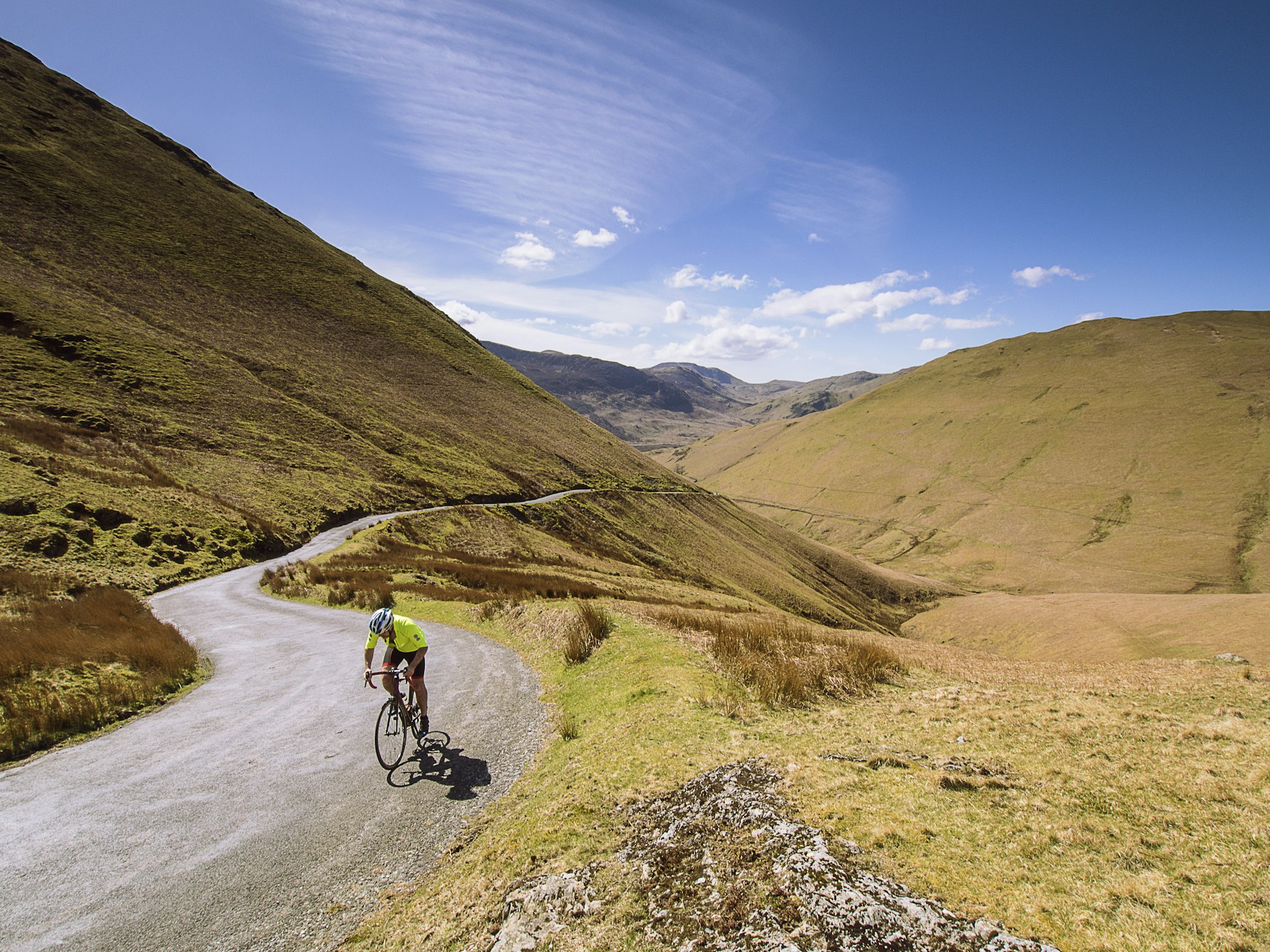
Save cycling for exploring the great outdoors
Hiring a bike – for an afternoon, a day, or a week or longer – is a great way to really explore a small region or see England’s great outdoors. Some cities have bike-share schemes (as well as e-scooters), while others have longer-term bike-rental shops. England also has a growing network of signposted long-distance cycling routes that may inspire you to explore more of the country by bicycle.
Bikes are often available for hire in national parks or forestry sites, particularly at locations used for leisure activities such as Kielder Water in Northumberland and Grizedale Forest in the Lake District . In some areas, disused railway lines are now bike routes , most notably routes in the Peak District in Derbyshire and the Bristol and Bath Railway Path in Somerset .
England is still a notoriously car-centric country however, and most cities are not very cyclist-friendly. Only a handful of cities have an adequate system of dedicated bike lanes, so it’s best to enjoy cycling in more rural locations, particularly during the summer.

There are a few domestic airlines
England doesn’t have a big network of domestic flights due to its small size, but there are some long cross-country routes that are awkward, costly and time-consuming if you travel by train (eg the trip from Exeter or Southampton to Newcastle ).
However, you’ll still pay at least £100 for one of these flights, and the time saved becomes less beneficial once transit times and the journey to and from the airport are factored in. England's domestic airline companies include British Airways , Loganair , easyJet and Ryanair , but considering the short distances and high carbon cost, many prefer not to fly.
Take a boat ride to the Isle of Wight or Scilly Isles
The only major ferry routes within England are from Portsmouth or Southampton to the Isle of Wight , and from Penzance to the Scilly Isles . If time isn't an issue, you could see some of England by canal boat; narrowboat hire companies are concentrated around the Oxford Canal and the Grand Union Canal near Rugby.

Local buses and trains get you around and between towns and cities
English cities usually have good public-transit systems – provided by a combination of buses, trains and sometimes trams – although these services can be run by a confusing number of separate companies. There's usually good information at each stop or station, including route maps and ticketing information, and staff in tourist offices are always happy to help.
Local bus services year-round in cities and towns except on Christmas Day and sometimes also Boxing Day, when services either stop or run on limited timetables. Sundays also see fewer services. CityMapper is a handy app for planning the quickest journey between points, especially if you're combining transport options.
Buses run in rural areas year-round, although timetables are designed to serve schools and businesses, so there are fewer services in the middle of the day and at weekends. Services may stop running during summer school holidays, or buses may link local villages to a market town only one day each week. It pays to do your research before traveling around rural England relying on bus transport alone.
In tourist areas (especially national parks ) there are usually more frequent services from Easter to September. However, it's always worth double-checking at a tourist office before planning your day's activities around a bus that may not actually be running.
How to catch a taxi in England
There are two kinds of taxis in England – licensed cabs with meters that can be hailed in the street, and "minicabs," which are cheaper but can only be booked by phone. In London and some other large cities, official taxi services are provided by the famous black cabs, which charge by distance and time. Ridesharing apps such as Uber are also an option in cities and most major towns.
In rural areas, licensed taxis usually need to be booked by phone; look up the numbers for local taxi companies online as you plan your journey, or ask at a local pub or your accommodation. You'll often find taxis waiting for fares at country train stations, or a cab office nearby.
Tip for taking a taxi: The Traintaxi website is a database that pairs up minicab providers with train stations, helping you "bridge the gap" between the station and your final destination.
This article was first published Mar 31, 2021 and updated Jul 19, 2023.
Explore related stories

May 27, 2023 • 10 min read
Scotland isn't big but the scale of its mountains, valleys and lochs mean small distances equate to long journeys. Read our top tips for getting around.

Aug 23, 2022 • 8 min read

Sep 18, 2019 • 2 min read

May 14, 2024 • 7 min read

May 13, 2024 • 7 min read

Apr 19, 2024 • 8 min read

Mar 22, 2024 • 9 min read

Mar 21, 2024 • 10 min read

Mar 17, 2024 • 10 min read

Mar 12, 2024 • 11 min read

UK Trip Itinerary: Travel Around the UK in 10 Days
We’ve both lived in the UK for pretty much our whole lives and there’s a very good reason why we’ve stayed all these years. It’s because it’s such a beautiful country!
Over the years, we’ve seen nearly every corner of the UK together and now we’re here to share this UK trip itinerary with you.
In order to see more than just London, we’d recommend you travel around the UK in 10 days or longer by car. This itinerary will focus on some incredible places you should make an effort to see during your road trip .
Are you ready? Let’s go!
Days 1 & 2: London
No trip to the UK would be complete without a visit to the capital, London. Plus, the chances are very high that this is the city you’re going to be flying in to.
Although you could easily spend the full ten days of this itinerary wandering around London and still not see it all, we’re on a mission to prove that there’s a whole country to explore outside of the capital city, so we recommend you spend your first 48 hours in London, followed by a fun UK road trip.
If it’s your first visit to London, you should make an effort to see all the top spots and attractions such as Buckingham Palace , the Houses of Parliament , Westminster Abbey , Tower Bridge , the Tower of London , the London Eye and Trafalgar Square , as well as popular shopping districts, Oxford Street , Regent Street , Camden Market and Portobello Road Market , all of which look stunning at Christmas time .
READ MORE: 17 FAMOUS STREETS IN LONDON YOU MUST SEE!
For those of you who have already seen all of these top spots, you can start venturing off the beaten path a little bit in order to see places like the pretty Mews Streets , Sky Garden , Belgravia (including the Peggy Porschen cafe ), the Prime Meridian Line , Holland Park , Little Venice , Mayfield Lavender Field , the Cutter & Squidge tea room , and loads more.
For lots more off the beaten path places to visit in London, you should definitely make it your mission to read Pretty City London: Discovering London’s Beautiful Places by Siobhan Ferguson.
It’s full of inspiration and run by the same woman behind the hugely successful Pretty City London and The Pretty Cities Instagram accounts. Get the book here >>>
Discover even more recommendations (from a London local) in this blog post! >>>
Day 3: Oxford
Taking less than 90 minutes to drive to Oxford, a truly iconic UK city , this is usually a popular day trip idea from London.
In this particular itinerary, it serves as the perfect halfway point between London and the South West, plus it’s a beautiful city so rightly deserves its place among the best here.
You can easily see the best of Oxford within one day, such as the Radcliffe Camera , Oxford Castle , Bridge of Sighs , University of Oxford Botanic Garden , Port Meadow , and a long walk along the canal before making your way across to the Cotswolds area for the next few days of this itinerary.
Day 4: Cheltenham
Found in the north of the Cotswolds, Cheltenham is one of the most historic towns in the UK as it’s the most complete Regency town .
Cheltenham was once the place to be in the 18th century after its spa waters were discovered and commercialised. Wealthy Londoners saw it as the perfect place to escape the hustle and bustle (and smog!) of the capital.
Nowadays, the stunning stucco facades and ripe history are blended with the modern including a newly established street art scene.
As Cheltenham is quite a small town, you only need to spend one day here in order to see the best of it, including the town’s many beautiful parks and gardens , Pittville Pump Room , historic Regency architecture and the Promenade .
For more fun things to do in Cheltenham, take a look at this blog post >>>
Day 5: The Cotswolds
Thatched-roof cottages, rolling green hills, stone buildings and farmlands evoke the ultimate vision of the quintessential English countryside.
And often, it’s the villages found in the stunning Cotswolds that evoke these thoughts and inspire travellers to visit the UK, which is why there should be no surprise for the Cotswolds to make it onto this UK trip itinerary.
It’s recommended that you spend a full day exploring some of the best Cotswolds villages such as Bourton-on-the-Water , Chipping Campden and Stow-on-the-Wold , which are all fairly close to one another, oh so beautiful and just what you imagine when thinking of a Cotswold village.
Read more about these Cotswolds villages and what to see and do in each one here >>>
Day 6: Bristol
Considered to be one of the most fun, vibrant and relaxed cities in the UK, there are lots of very good reasons why you should make an effort to see Bristol during your trip.
It’s a fairly small city so is really walkable, and offers so much beauty, intrigue, colour and fun along the way.
Some of the city’s most iconic landmarks include the Clifton Suspension Bridge , SS Great Britain , the Matthew , the Harbourside and the old part of the city centre, while there’s also plenty of more unusual places to visit for those of you after something a little more unique during your trip as well.
For more Bristol inspiration, take a look at our one day in Bristol itinerary >>> Or check out all of our Bristol blogs here >>>
Day 7: Brecon Beacons

While you’re in this neck of the woods, it makes sense to see some of the Brecon Beacons in Wales… especially if you’re an outdoors adventure lover like us.
The Brecon Beacons are an iconic image when thinking about the UK and easily one of the most beautiful places owned by the National Trust .
There are so many different kinds of walk you can take – from hiking across the grassy plains , to walking behind waterfalls , to rambling near reservoirs .
In order to see all of the best parts of the Brecon Beacons, it would easily take you the full ten days of this itinerary. So with only one day devoted to it, your best bet would be to drive through some of it and do an easy day hike as well.
Two of our favourite walks (ever) have been in the Brecon Beacons.
The first is the Four Waterfalls Walk near Ystradfellte , which involves woodland walks and the opportunity to walk behind a large waterfall (for free)! This is a lot of fun … and very wet, obviously!
Our second favourite walk in the Brecon Beacons is around Pontsticill Reservoir .
The water is a stunning shade of blue, and there are little secluded areas by the waters edge, perfect for picnicking in. You can also walk across the bridge in the middle of the reservoir to get perfect 360 degree views of the reservoir.
Good luck picking just one of these walks to do!
For more Brecon Beacons inspiration, check out our hiking guides:
- Pontsticill Reservoir
- Four Waterfalls Walk
Day 8: Bath

With the whole city declared a World Heritage Site in 1987 and depicting the very essence of English idyll, Bath is one of our most favourite of European cities.
The entire vibe is like something out of a Jane Austen novel. From the Bath buildings, to the stunning abbey, to the Ancient Roman baths, this entire city is a cultural and historical wonder.
As a walkable city, it’s easy to see the highlights of Bath in just one day (without rushing). Some of the top attractions to see are the Roman Baths , Bath Abbey , Royal Crescent , The Jane Austen Centre , Assembly Rooms , as well as The Botanical Gardens in Victoria Park.
To find out how to spend a perfect one day in Bath, click here >>>
Day 9: Stonehenge & Salisbury

Stonehenge is possibly one of the most iconic landmarks in all of the UK.
Thought to have been constructed from 3000 BC to 2000 BC, archaeologists believe it could have once been a burial ground.
T oday, it’s a marvel to walk around as you wonder how our Neolithic ancestors were able to construct such an incredible monument without modern machinery.
From Bath, it’ll take you just short of an hour to drive to Stonehenge, and you’d want to spend around 1-2 hours at Stonehenge itself. From there, it takes just 20 minutes to drive to Salisbury, which we highly recommend doing to make a day of it .
Salisbury is another of the UK’s historic cities, albeit a slightly less popular one with global tourists.
Inside Salisbury Cathedral , you’ll find one of four original Magna Carta documents, while the city of Salisbury offers so many other historic landmarks including a pub ( The Haunch of Venison ), which dates back as far as 700 years ago. Plus, their food is pretty damn delicious!
For more interesting things to do in Salisbury, take a look at this blog post >>>
Day 10: London

Your final day is probably going to be spent making your way back to London to catch your flight.
If you’ve followed this itinerary, then you’re looking at a two hour drive from Salisbury to the centre of London.
You may want to spend a few final hours continuing to explore London (depending on what time your flight is)… for anything you didn’t have time to do during your first two days in the UK.
ALTERNATIVELY…
Popular with UK locals and tourists alike the world over, the pretty counties of Devon and Cornwall are also well worth a visit.

If you’ve got an extra few days to spend in the UK in order to make this a 2 week UK trip itinerary instead, then you should definitely take a slight detour through Devon and onto Cornwall to see places like Exmoor National Park , Dartmoor National Park , the Eden Project , the Lost Gardens of Heligan , Lands End and some of the best Cornwall beaches .
You could easily do this detour after visiting Bristol or Bath if you’re following the above itinerary.
Get some tips and inspiration in our Cornwall road trip itinerary post >>>
Alternatively, you could also skip Oxford, Cheltenham, the Cotswolds and Bristol in order to head straight to Devon and Cornwall from London if preferred. If you do this, you should set aside around 3 or 4 days to see the best of these two counties.
Is this UK itinerary not quite what you were after? We also offer custom travel planning services !
Where to Stay in the UK for this 10 Day Itinerary
As you’ll be spending a couple of days in London as part of this itinerary, it makes sense to spend your first few nights here.
Generally speaking, London can be quite expensive compared to the rest of the UK, however, you can still get a decent night’s sleep within a mid-range budget if you stay in and around North London, such as Hampstead or Islington.
Here are a few of our hotel recommendations in London:
- Langorf Hotel : Housed within a traditional townhouse, Langorf can be found in Hampstead Borough, and has easy connections to London’s city centre via a 10 minute tube ride. The rooms are spacious with en-suites, while the communal areas are traditional, yet stylish.
- Haverstock Hotel : Haverstock Hotel can be found a 4 minute walk from Belsize Park Tube Station, which has direct connections to the centre of London, taking just 12 minutes. The rooms are all lavishly decorated, while the communal areas are understated, yet useful.
- Best Western Swiss Cottage Hotel : Best Western Swiss Cottage Hotel is also housed in a traditional townhouse, and is just metres away from the local tube station, which is on the Jubilee line, ensuring a trip into London’s centre takes less than 15 minutes. The rooms have all been traditionally decorated, while the communal areas look just as elegant.
The picturesque Cotswolds is a great area to stay in as it’s close to Cheltenham and Bristol, while it also only takes around 90 minutes to drive to the Brecon Beacons, making this area a perfect base for days 4 to 7 of this itinerary.
Covering over 800 square miles, the Cotswolds is a big area, so we would recommend you stay near Stroud in order to be as central as you can and close to the M5 motorway.
Here are a few of our hotel recommendations near Stroud:
- The Bear Of Rodborough Hotel : Found just a few minutes south of Stroud, The Bear Of Rodborough is housed within a former 17th century coaching inn, which means the communal areas have plenty of character. The rooms themselves have been elegantly renovated, while maintaining as much of the inn’s character as possible.
- Burleigh Court Hotel : Also found a few minutes south of Stroud, Burleigh Court Hotel is also steeped in history and character; this time inspired by its 18th century manor house roots. The rooms are all incredibly spacious and full of period charm.
- Wild Garlic Bistro & Rooms : For a more modern stay near Stroud, the Wild Garlic Bistro & Rooms is a great place to stay as a couple. The restaurant beneath the rooms is superb and the rooms themselves are all clean, bright and airy.
Bath is such an important part of UK history, and ridiculously pretty, so it’s highly recommended you spend a night in Bath if you can.
Your best bet would be to stay within the city’s historic centre. You may pay a little bit more, but you’ll definitely increase your chances of staying within a stunning period property.
Here are a few of our hotel recommendations in Bath:
- No.15 Great Pulteney : Found right in the middle of all of Bath’s action (just a 3 minute walk from the Roman Baths and Abbey), No.15 Great Pulteney is so luxurious. If you’ve ever wondered what it may have been like to live in an old Georgian manor house, then this is your chance!
- The Gainsborough Bath Spa : Housed above a lavish spa, The Gainsborough Bath Spa is able to offer the epitome in luxury and relaxation. In fact, it’s the only UK hotel with access to naturally heated thermal waters within its Spa Village. The rooms are charming and spacious, while access to the spa is well worth the money by itself.
- Abbey Hotel : Just two minutes from Bath Abbey, the Abbey Hotel is a large hotel, housed within a typical Georgian building. The rooms are all traditionally decorated, while the communal areas are lavish and elegant. This hotel is sure to give you a flavour of just what Bath is really about.
We hope you find this itinerary useful! Are you excited to travel around the UK for 10 days? We’d love to know what you’re most excited to see…
Don’t forget your UK packing list! Here’s what you should wear in the UK >>>
Need help planning your trip to the UK? Check out our UK travel planning guide now!
Did you like this? Why not share it around?!

Justine Jenkins
Justine is one half of the married couple behind the Wanderers of the World travel blog. She lives in Bristol, UK and has travelled extensively within Europe and beyond since 2013. After her trips, she shares detailed travel itineraries, helpful travel guides and inspiring blog posts about the places she's been to. When she's not travelling overseas, you'll find her joining her husband, Scott on various day trips, weekend getaways and walks within the UK, which she also writes about on Wanderers of the World. Aside from travelling and writing, she also loves reading, crafting and learning about nature.
Leave a reply Cancel reply
Your email address will not be published. Required fields are marked *
SUCH a good itinerary! Been to a couple of these places, London being a highlight since we lived there. Need to see some more of these beautiful places!
Thank you! We’re pleased to hear you like our itinerary so much! 100% agreed – there’s far too many incredible places to visit here, I hope you get to see more of them one day 🙂
You mean 10 days in England! The U.K is comprised of 4 countries, not just one.
Hi Mable, Thanks for taking the time to comment! Although this blog post does focus on England a lot, I do have to point out that we included a day in the Brecon Beacons in Wales on the seventh day, which is why we labelled this as a UK trip itinerary. I appreciate that being able to see more of the UK would be tricky in just 10 days though 🙂 Best, Justine
Why do you suggest visiting Bristol on Day 6 and Brecon Beacons Day 7? Doesn’t it make more sense inverted?
Thanks for commenting! We suggested visiting Bristol before the Brecon Beacons as we thought it would help to break up the driving on the first leg into Wales as Bristol is closer to Bath. However, we agree that you could do this part of the itinerary either way around as there isn’t that much to change up should you wish to 🙂
Driving in the U.K.
Power Adapters
Tipping Etiquette
Top Things to Do
Free Things to Do
Family-Friendly Attractions
Outdoor Adventure Destinations
National Parks
Must-Try Food in the U.K.
Best Time to Visit
Weather & Climate
Top Cities to Visit
Best U.K. Destinations
Traveling by Train
Getting Around Britain - A Guide to Transportation Options
:max_bytes(150000):strip_icc():format(webp)/FerneArfin-5b6f00c446e0fb0050324e74.jpg)
If you need to get around the United Kingdom without a private car, there are several options to choose from. Will it be trains, buses or long-distance coaches? Time, cost and environmental concerns are all part of the mix. This guide will help you find the travel choices that best fit your plans, time, budget and conscience.
Using British Trains to Get Around
British trains have been around, in one form or another, since the early 1800s. The network is well established and extensive, making train travel the easiest and, usually, the fastest way of getting around England, Scotland and Wales. It is also acknowledged to be the most eco-friendly way to travel in Britain. Most major towns are connected to London and to each other by either direct trains or by links through stations that are regional hubs. Smaller communities may have less frequent service or may require changing trains a few times but chances are there's a train station nearby.
How to Plan a Train Trip
Government-owned Network Rail is responsible for the tracks and the 20 largest train stations, managing timetables and regulating fares. Many different private companies own and operate the trains themselves. Figuring out which train company goes where can seem confusing but it's easier than you think.
The private companies belong to the Rail Delivery Group (RDG ) and one of the great services they provide together is National Rail Enquiries. This is a website and an app that enables you to find trains and fares and directs you, by link, to the train companies to buy tickets. It has tools to find the cheapest fares and service alerts.
The good news is that any UK train company can take your booking and payment for any other train company on the system. The British train fares are nationally regulated so the fare for a given journey will be the same regardless of which train company sells you the ticket or operates the trip.
Find out more about National Rail Enquiries and how to use it.
Types of British Train Tickets
Tickets are 1st or 2nd class or classless. Unless you are taking one of the few overnight train journeys, there is little point in spending extra on first-class service.
Most trains have open seating; once you have a ticket, you can sit wherever you like within the class of service you've bought. An exception is for particularly busy routes when you may have to book a seat along with your travel ticket. Usually this is free or costs a nominal fee.
Do pay attention to the difference between advance fares and anytime fares, single (one-way) or return (round trip) tickets, because the savings can be considerable.
Main Categories of Train Fares and Ticket Prices
What you pay for a British train ticket usually depends on when you buy it and when you plan to travel. Here are the main categories of ticket prices:
- Anytime - The most expensive tickets are "buy anytime-travel anytime". They have no restrictions on the date or time of travel. For some trips, they can cost ten times more than an advance purchase or "off-peak" ticket.
- Off-peak - Buy off-peak tickets at any time but only use them to travel on off-peak services. They are cheaper than Anytime tickets though not the cheapest. One confusing aspect is that "off-peak" time is not standard but varies from one train company to another and from one service to another. Trip planning tools such as National Rail Enquiries can find you the off-peak services for the trip you want to take.
- Advance - Advance fares are the cheapest. They are one-way tickets purchased and booked in advance for specific trains. How far in advance depends on the popularity of the journey. For some trips, you can book the cheapest fare as little as the day before while for others you need to book your train at least 14 days in advance. These tickets commit you to a specific train at a specific time. If you miss that train, there may be another one coming right along but catching it will cost you the full fare for the trip. And the difference can be gobsmackingly huge. For example, in January 2020, a one-way ticket from London to Lincoln at 8 p.m, purchased a week in advance would cost thirty-two pounds and 50pence. Show up at the last minute and the same trip would cost eighty-eight pounds and 50 pence.
Where to Buy Tickets and How to Pay
At the station: Most of the big mainline train stations have ticket offices where agents sell tickets. But, unless you are buying advance tickets, you won't be offered any discounts or savings.
By Phone: The train companies that National Rail Enquiries directs you to usually have phone numbers on their websites but you may be left hanging on for quite a long time.
Online: Choose journey and fare and let the National Rail Enquiry tool guide you to a train company to buy your ticket, using a debit card or (for international customers) a credit card. You'll get an email with a confirmation number. Print and save it. Then get your ticket:
- By mail, if purchased four or five days in advance from a UK address.
- At a fastTicket machine at the station. Bring the credit card you used to pay for the ticket, along with the confirmation number you've printed out. Follow the directions on the machine. Arrive early enough for the queue at the automatic machine. Any fastTicket machine can dispense booked tickets for any departure station as long as you have your booking number and credit card. So as soon as you are at a station, save time and pick up all your tickets at once.
- At a manned ticket booth . Present credit card and confirmation number at a manned ticket window.
- When the station is unmanned Smaller stations may not be manned. If you board at an unmanned station, you can buy a ticket on the train. But make sure the station really is unmanned because if staff is available and you board without a ticket, you may be fined or have to pay the highest available round-trip fare.
Using Rail Passes
BritRail Passes are prepaid tickets valid for unlimited travel during specified periods. They are sold as:
- Consecutive Passes , good for a fixed number of days of unlimited British rail travel.
- Flexipasses , for a specified number of days (4, 8 or 15) - not necessarily consecutive - during a longer period, currently two months.
BritRail passes are available for UK, Scotland-only or England-only travel; and as Senior, Youth, Party or Family passes. They are not sold in the UK and must be purchased online or through a travel agent before you arrive.
Because the tickets are prepaid, most of the time all you have to do is show up on time and hop on the train. If you want to book a seat or sleeper accommodation, you need to do that at a manned railway station. Seats are usually free, as are reclining seats in overnight trains, but there is a charge for sleeper births.
Are they worth it? - So many cheap rail fares are now available when purchased online in advance, you may not save anything by buying a BritRail Pass . It is worth comparing the cost of the pass with the fares listed on National Rail Enquiries before buying one. If, however, you like to travel spontaneously, you probably should buy a pass because last-minute train tickets bought any other way are much more expensive.
Public Transportation in Northern Ireland
Unlike the rest of the United Kingdom, all public transportation in Northern Ireland is operated and coordinated by one umbrella organization, Translink . They provide coach, bus and train services connecting at a province-wide network. That includes urban mass transit in Belfast, airport transfers from Dublin or Belfast airports to Belfast city center and, in partnership with Irish Rail, cross border routes into the Irish Republic. Buy tickets online because they are much cheaper. A mid-day train from Belfast to Dublin (February 2020) cost ten pounds and 99 pence online but 30 pounds for cash at the station.
Use the integrated travel planner on their website. It gives a choice of searching for bus, train or combined services and an easy link with to buy tickets.
Other Ways of Getting Around Britain
Coach Travel- Long-distance buses are known as coaches in the UK. Several intercity bus companies provide some of the cheapest ways to get around. Fares vary with operators, generally ranging from five-pound promotional fares to upwards of 35 pounds for longer trips. Coach tickets are usually offered as one-way or "singles."
These are the main coach operators in the UK:
- National Express- Intercity travel in England and Wales, tickets online or at main coach terminals
- Megabus - A stripped-down service offered to some destinations with tickets only available online
- Scottish Citylink - Intercity services across Scotland
- TrawsCymru - Medium and long-distance express buses in Wales
- Ulsterbus - Part of Northern Ireland's Translink service described above.
Regional Bus Services - Different bus operators run networks of regional buses. Tickets for some of these buses can be purchased online but usually you just buy them on the bus. Finding out fares for these services is pretty hit and miss but you can get a general idea from the operator's website. Some of the main companies for regional buses are:
- The Oxford Tube One of the most popular long-distance bus routes, this is an express service between several stops in Oxford and several stops in London. It runs 24-hours a day, with peak time buses leaving every 12 to 15 minutes. Tickets can be booked online or from the driver using contactless credit or debit cards, or via mobile payment apps. Single adult fare is nine pounds.
- Stagecoach A major operator of regional bus services all over the country. They use a variety of local names but their website has a very good journey planner that integrates all the information with maps, timetables and a ticket-buying widget.
- Arriva - Another major operator of regional bus services in London and the home counties, England's northwest and northeast, and Wales. Their website has maps, journey planners and ticket buying options.
Travel Tips
- Check a map - Sometimes a better (cheaper, more direct, faster) train may be scheduled for a station just a short taxi ride from your chosen destination.
- Compare prices Two singles can be cheaper than return tickets.
- Buy before boarding . You can be fined for boarding without a ticket or be made to pay the highest price for the tickets.
- Keep your train ticket even after it has been checked on board. You may be asked to show your ticket or put it through a machine to leave the platform.
- Use online information sites to plan coordinated journeys using different modes of transportation. The two most useful are:
- Traveline - a partnership of transport companies, local governments and passenger groups. With its journey planner, you can plot door-to-door journeys that include trains, buses, walking and local taxis.
- Trainline - An international organization of 270 train and coach companies across the UK and Europe that helps you combine train and coach travel and book tickets.
National Rail Enquiries - How to Find the Best UK Train Times & Fares
Britrail Passes for Unlimited UK Train Travel and Cheap Touring Options
How to Travel From London to Birmingham by Train, Bus, and Car
Eurostar High Speed Trains Through the Channel Tunnel
About Single Europe Train Tickets
10 Questions to Ask Yourself Before You Plan Your UK Trip
5 Ways to Find the Cheapest Train Travel
Getting Around Paris: Guide to Public Transportation
How to Travel From Cape Town to Johannesburg by Plane, Train, Bus and Car
Getting Around Belfast: Guide to Public Transportation
Train Travel in Morocco
Ride the Nilgiri Mountain Railway Toy Train to Ooty
Getting Around Seattle: Guide to Public Transportation
Which BritRail Pass Should I Buy?
Megabus: Very Cheap UK Bus Travel - Or is it?
Getting Around Frankfurt: Guide to Public Transportation
- Travel Guides
- Top Destinations
- Inspiration & Ideas
- Booking Tips
- Packing Guide
- Where to stay
- At The Airport
- How-to Guides
- First Times
- Travel Community
- World Flavours
- Travel Products
3 best ways to travel around the UK
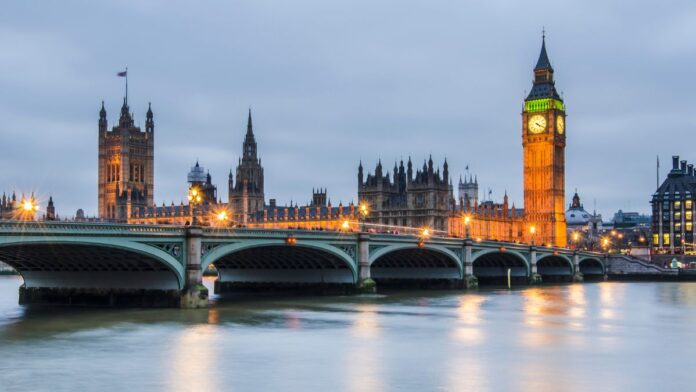
For the last few years, the staycation has enjoyed a sustained surge in popularity . More and more Brits are choosing to spend their holiday time domestically. In the process, they’re saving money, reducing their emissions, avoiding the hassle, and discovering parts of the country that they might otherwise have overlooked.
If you’re considering a domestic holiday, then you’ll be faced with a choice of several different modes of transport. Let’s look at some of the best ways to travel around the UK.
READ MORE : Here’s our list of the 5 best places to visit in the south of England
Taking the train
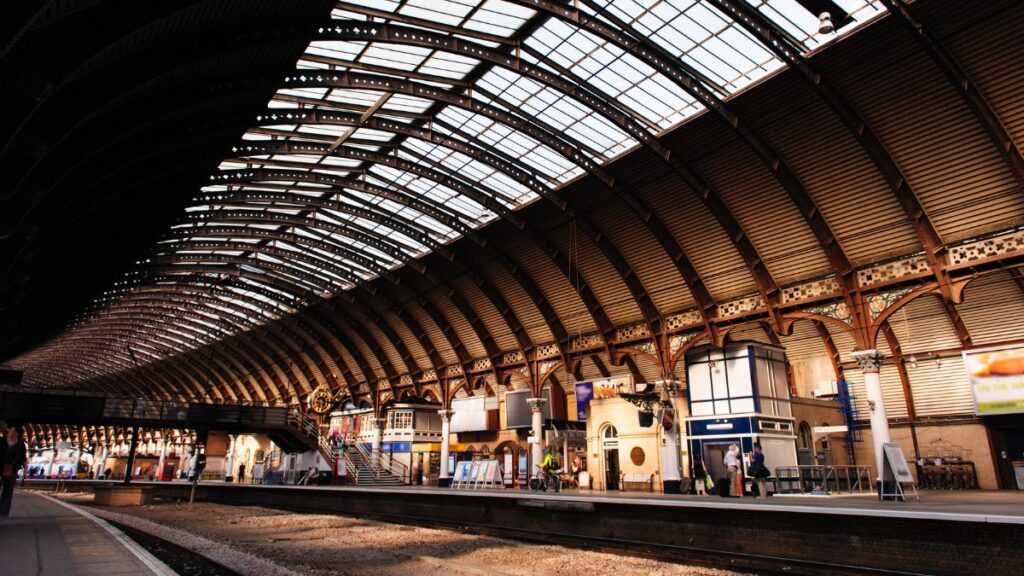
Britain boasts an extensive train network that stretches to just about every corner of the country. Wherever you are, you can be just about anywhere else in the country within a matter of hours. If you’re travelling from one major city to another, then you can expect regular trains and respectable journey times.
One of the major advantages of this form of transport, as far as holidaymaking is concerned, is that you’ll be able to divert your attention toward the view outside, and you won’t have to worry about parking, rest breaks, or driving. The downside is that you won’t be able to take the short trips that will take you from one countryside attraction to the next, which might mean hiring a car or a taxi at the other end.

The current train strikes occurring throughout the nation are something to keep an eye on. South-eastern and West Midlands Trains were among the lines where Aslef union members embarked on a 24-hour strike. The Commonwealth Fixtures in Birmingham and fans travelling to English Football League clubs’ opening-week games were among those impacted. After several walkouts, it made passengers’ miserable summer even worse.
Driving is one of the best ways to travel around the UK

For most of us, bundling everything into a car and going on a lengthy road trip is the only sensible option. This way, you’ll be able to take far more in the way of possessions, and you’ll have the flexibility that comes with choosing your own timetable.
Before you set out, make sure that your car has undergone some basic maintenance, and that it’s fit for the journey. Top up all your oil and screen wash reservoirs, and make sure that your tyre tread is deep enough. If you need high-quality replacements, you can find Bridgestone tyres from reputable online vendors . Better to buy quality than buy repeatedly!
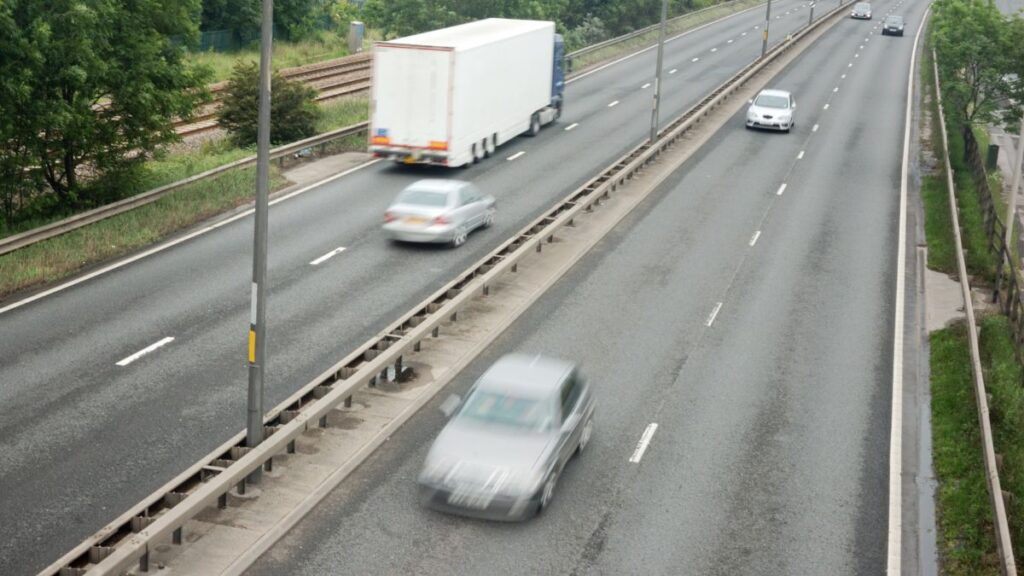
However, as living expenses rise, driving may not always be the most cost-effective alternative, particularly since the UK hasn’t done as much as other nations to reduce the burden of high gas prices, according to the RAC. According to data, only Luxembourg performed worse than other European governments who have reduced their fuel taxes, with 11 other nations providing more generous assistance. The fuel tax cuts that motorists in nations like Germany (25.1p per litre), Italy (21.2p per litre), Portugal (16.2p per litre), the Netherlands (14.7p per litre), and Ireland are enjoying dwarf the 5p per litre drop that the UK imposed in March (14.5p per litre). With the exception of Denmark (also 186p) and Finland, expenses are significantly higher in the UK than in the rest of the EU, at 186p per litre (190p).
READ MORE : Here are the 5 most visited tourist attractions around the world
Hopping on a coach or bus

When it comes to the economy, it’s difficult to beat a coach. The major coach tour operators will run regular routes between cities, and you’ll get discounts if you’re a student, or if you’re over 50. Look for coach tours that might take you through sightseeing locations and beaches.
On the other hand, there are the regular bus services, which provide a convenient way of getting around the country, even when you can’t find a tour coach operating.
If you’re travelling by bus around a major city, then make sure that you research ahead of time and find out how much you’re going to be spending. Look at timetables and make doubly sure that you aren’t going to be stranded before you board.
A huge advantage of bus travel is the environmental benefits it provides. By car, more fuel is burned, and more gases are released when traffic is backed up on congested highways, pollution results. The ability to carry more passengers in a smaller place without creating claustrophobic conditions results in more room being made available for other cars to manoeuvre. Up to 50 cars can typically be removed from the road by one coach per journey. Although taking a bus or coach offers advantages for the environment, it also has other advantages. You save time and money by not having to park.
RELATED ARTICLES
Can you travel while taking weight loss medication, 10 travel hacks you have to know in 2024, embracing sustainable travel: a guide to eco-friendly journeys and green tourism, latest articles, discover the best cities in spain to visit in 2024, most popular, the 5 most visited tourist attractions around the world, what are the seven wonders of the world, 10 places to visit before you die, the 5 best islands in thailand.
- Privacy Policy
- Terms Of Use
Copyright © 2024 Travel Wanderlust - All Rights Reserved.
How to Travel the UK on the Cheap
Adventurous Kate contains affiliate links. If you make a purchase through these links, I will earn a commission at no extra cost to you. Thanks!
The UK is one of the most expensive countries in Europe — and if you’re planning a trip, you might be daunted by the cost of transportation within the UK.
But it is very possible to travel the UK for cheap!
Since settling in Chester, I’ve found a host of ways to save money on transportation. And all of them have one thing in common:
BOOK EARLY.
It doesn’t matter whether you’re traveling by train, bus, or air — booking early will nearly always save you money, and booking last minute will always be exponentially more expensive.
Now that that’s out of the way, here are some ways to save money on different kinds of UK transportation:

Cheap UK Train Travel
Train travel in the UK is incredibly romantic, and you can easily watch the scenery go by for hours — bright green hills, sheep, newly plowed fields, tiny villages…it’s my favorite way to travel the UK.
Most of the time, it’s also the easiest and fastest way to travel — though not the cheapest.
If you’re not a UK resident and planning on traveling lots of long distances in the UK by train, look into a Britrail Pass . If you’re just booking occasional journeys, read on.
Check the Megatrain and Virgin Train sites first for absurdly cheap train routes. These two sites tend to promote the same routes.
Next, no matter which destination you choose, check out The Trainline’s Fare Finder — it will show you the cheapest tickets for various dates and times. Either way, booking on The Trainline is usually cheaper than other sites.
On all the aforementioned sites, you buy tickets online, then use the same credit card to retrieve your tickets at the station.
What to know: Be flexible on stations. I was looking for Chester-Edinburgh round-trip fares and couldn’t find anything for less than an astounding £150. Then I found out that there are cheap fares on Megatrain from Warrington Bank Quay to Glasgow, a short trip from Edinburgh. I had never heard of Warrington Bank Quay, but it’s only a few stops away from Chester!
I paid normal fares from Chester to Warrington and from Glasgow to Edinburgh — but from Warrington to Glasgow, the longest part of the journey, I found a super-cheap £9 fare.

Cheap UK Coach Travel
The thing about bus (or coach) travel is that you need to evaluate the positives and negatives. Yes, bus travel can be much cheaper than the train, but it can also take a lot longer, and most find it less pleasant (though all the coaches I’ve seen have been immaculate).
I usually book a coach when traveling from Chester to London. The fastest trip is five hours (while the train takes 2.5 hours and costs at least three times as much). To me, five hours on a bus is definitely doable, while 11 hours to Scotland is not worth it. I may have managed a 32-hour bus journey in Southeast Asia , but I have no intentions of repeating that here!
First, check out Megabus for the cheapest fares of the bunch, then check out National Express for cheap fares but more convenient times.
What to know: Again, book as early as possible, especially on Megabus — they even have £1 fares! Also, keep in mind that you must wear a seatbelt at all times — it’s UK law.


Cheap UK Air Travel
I wouldn’t recommend air travel in the UK most of the time — the sheer act of flying requires so much more time and effort, that it’s not worth it. But it can be useful for exceptionally large distances, like London to Aberdeen or Inverness.
My go-to flight search engine is Kayak because it’s the best. Be sure to check airline sites as well for unpublished fares. Budget airline Easyjet has several domestic routes in the UK.
What to know: Budget airlines usually fly at inconvenient times from out-of-the-way airports. Take this into account and make sure you have someone to drive you, or your Uber might be more expensive.

Creative UK Travel Options
None of these float your fancy? There are a few other options. Rideshare sites are growing more popular in the UK. My friend Dylan swears by hitchhiking. And you could also do Britain’s most intimidating walk: Land’s End to John O’Groats (also known as walking from Great Britain’s lower left corner to its upper right corner.)
One thing that I’d love to do: rent a narrow boat in Chester and travel by the canals in the northwest, going through canal locks and everything!
The one thing you should NOT skip to save money in the UK? Travel insurance ! I never travel with it and it will save you a lot of money if something happens on your trip. I use and recommend World Nomads.
Any more tips for cheap transportation in the UK? Share in the comments!

Britain by train: Five great one-week UK rail trip routes
Posted on Last updated: December 11, 2023
Explore Britain by train with five of the best British rail trip itinerary ideas you can do in just one week, covering historic England, scenic Scotland, the Cornish coast, UK cities, and Wales and the Borders.
* This site contains affiliate links , where I get a small commission from purchases at no extra cost to you.

I love a good rail trip and have travelled by train across Europe and beyond. But there are plenty of fantastic rail adventures close to home in the UK too – from Cornish coastal trains to the journeys across the wild Scottish highlands. And the country’s relatively small size means you can pack a lot into a short time, with rail passes available to keep costs down.
Whether you’re looking for history and culture, coast and countryside scenery or the UK’s coolest cities, there’s the perfect British rail trip for you. So here are five great itineraries for exploring Britain by train. It’s possible to do each of the routes in a week, but if you’ve got more time you can take it slower and spend more time in each place.
And if you’re ready to go, check out my detailed one-week itinerary posts – linked to after each route description below – for full details of which trains to take, how much they cost, how to book tickets, what to see and where to stay along the way.
5 itineraries for exploring Britain by train
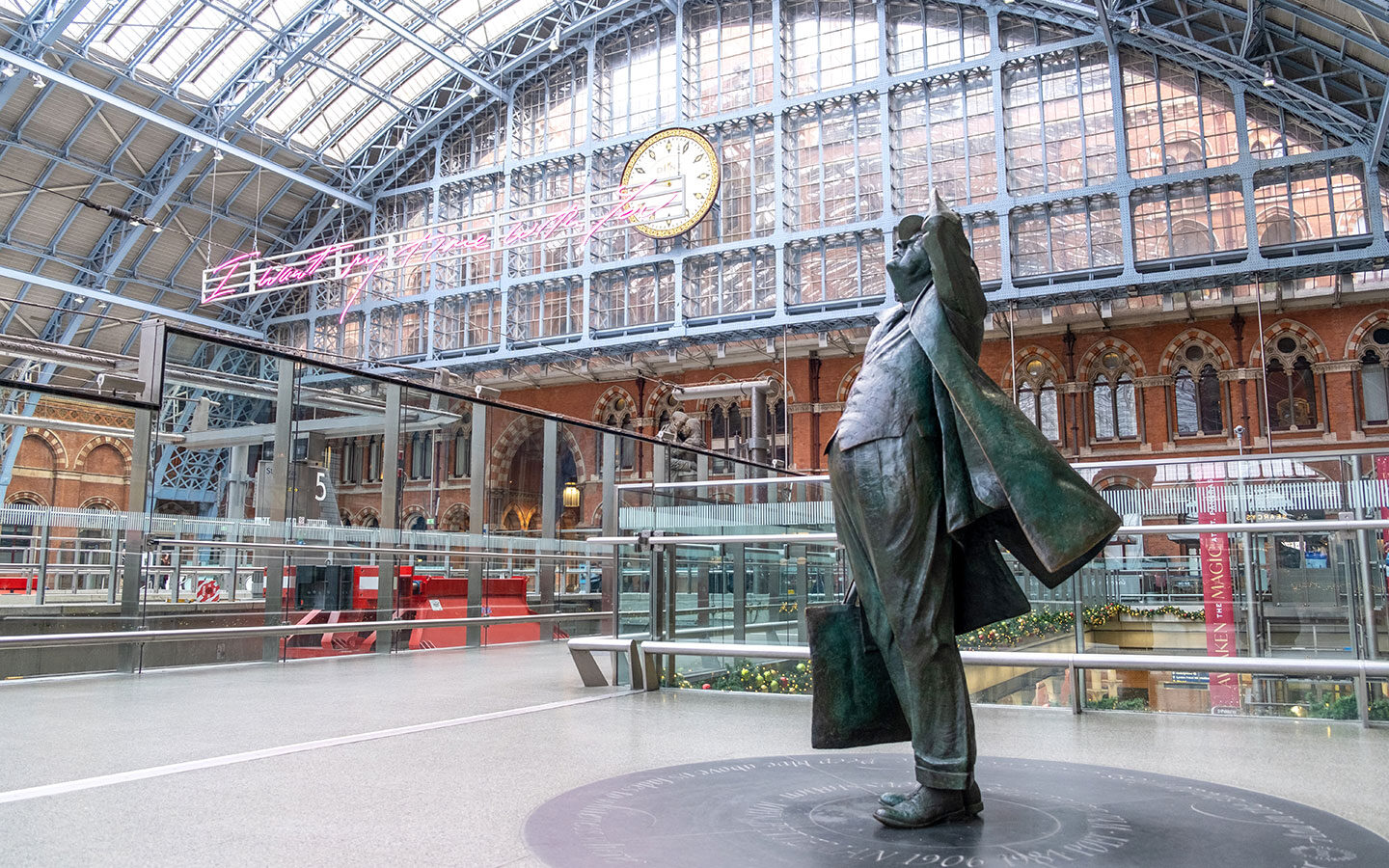
Historic England
London > Salisbury > Bath Spa > Oxford > Stratford-upon-Avon > York
This rail trip takes you across England and back through time, featuring some of the country’s most impressive castles, cathedrals and colleges. Start with a full day in London , choosing from its selection of historic buildings, museums and monuments, including the Tower of London, Westminster Abbey, British Museum and Shakespeare’s Globe.
Then catch a morning train to Salisbury (1.5 hours). This riverside city is known for its 13th-century cathedral, where you can see one of the surviving copies of the Magna Carta and take a tour of the tower. Or travel back 2000 years to Roman times at Old Sarum.

Next travel to Bath Spa (1 hour). Bath is known for its Roman history, so don’t miss the Roman Baths – and you can soak yourself in the modern version at the Thermae Spa with its rooftop pool. There’s also the beautiful Georgian architecture of the Royal Crescent and Circle, and whole festival dedicated to Jane Austen who lived in the city in the 1800s.
Then take the train to Oxford (1 hour 10 mins), one of the UK’s most famous university cities. Take a tour of the college quads – Harry Potter filming location Christ Church is the star, but Magdalen, New College, Trinity and All Souls are also well worth visiting.
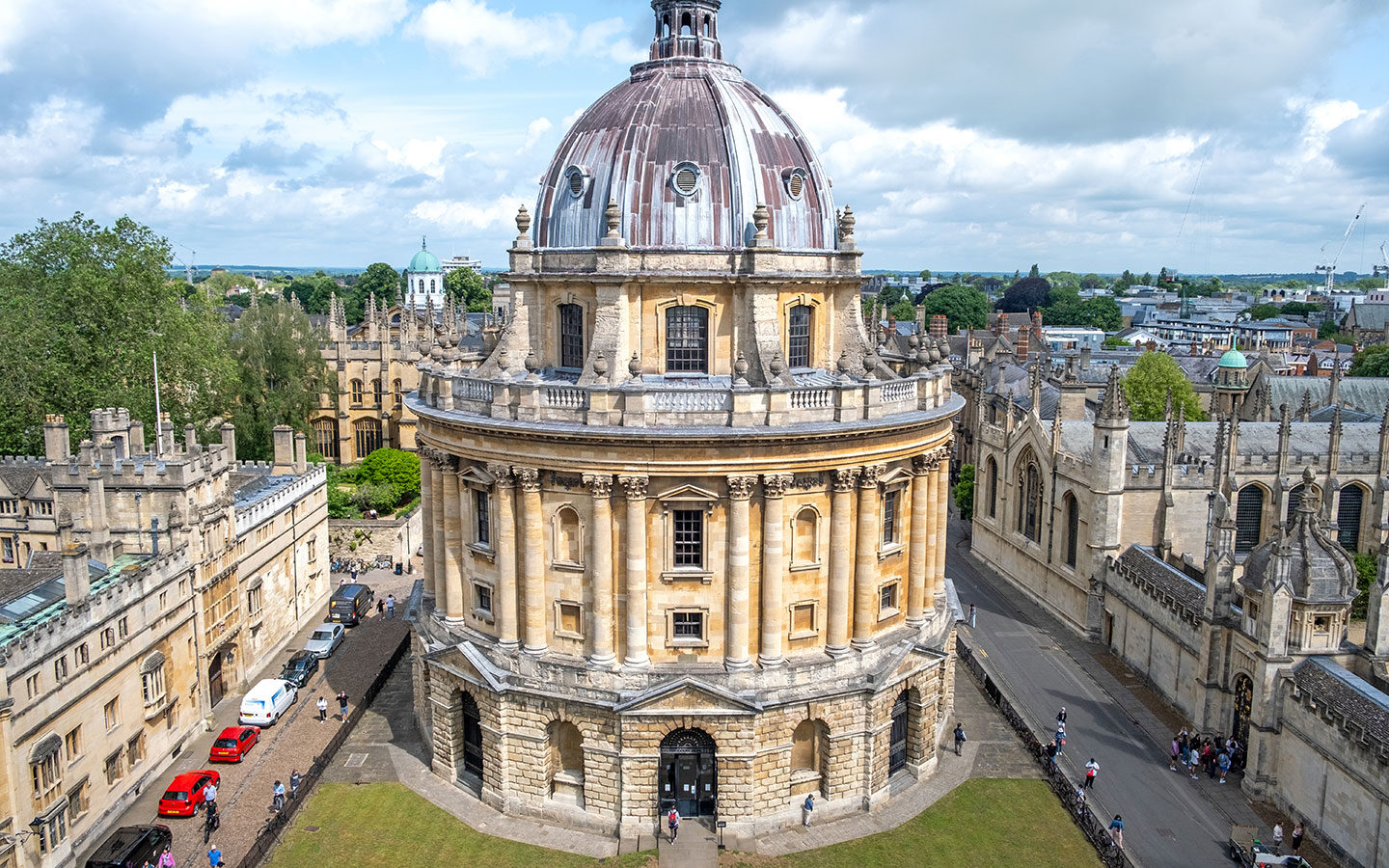
Call in to the quirky Pitt Rivers Museum to see its anthropology exhibits or explore art and antiquities at the Ashmolean Museum. Then catch a morning train to Stratford-upon-Avon (1.5 hours). Spent the afternoon in Shakespeare’s home town – you can visit his birthplace, school and houses his wife and mother lived in, and see his plays at the RSC theatre.
Then finish your trip by travelling north to York (4 hours), where you’ll have the afternoon and the next morning to walk the Roman city walls, visit the Minster, explore the cobbled lanes and half-timbered buildings of the Shambles and have afternoon tea at Betty’s.
Read the full Historic England by train itinerary
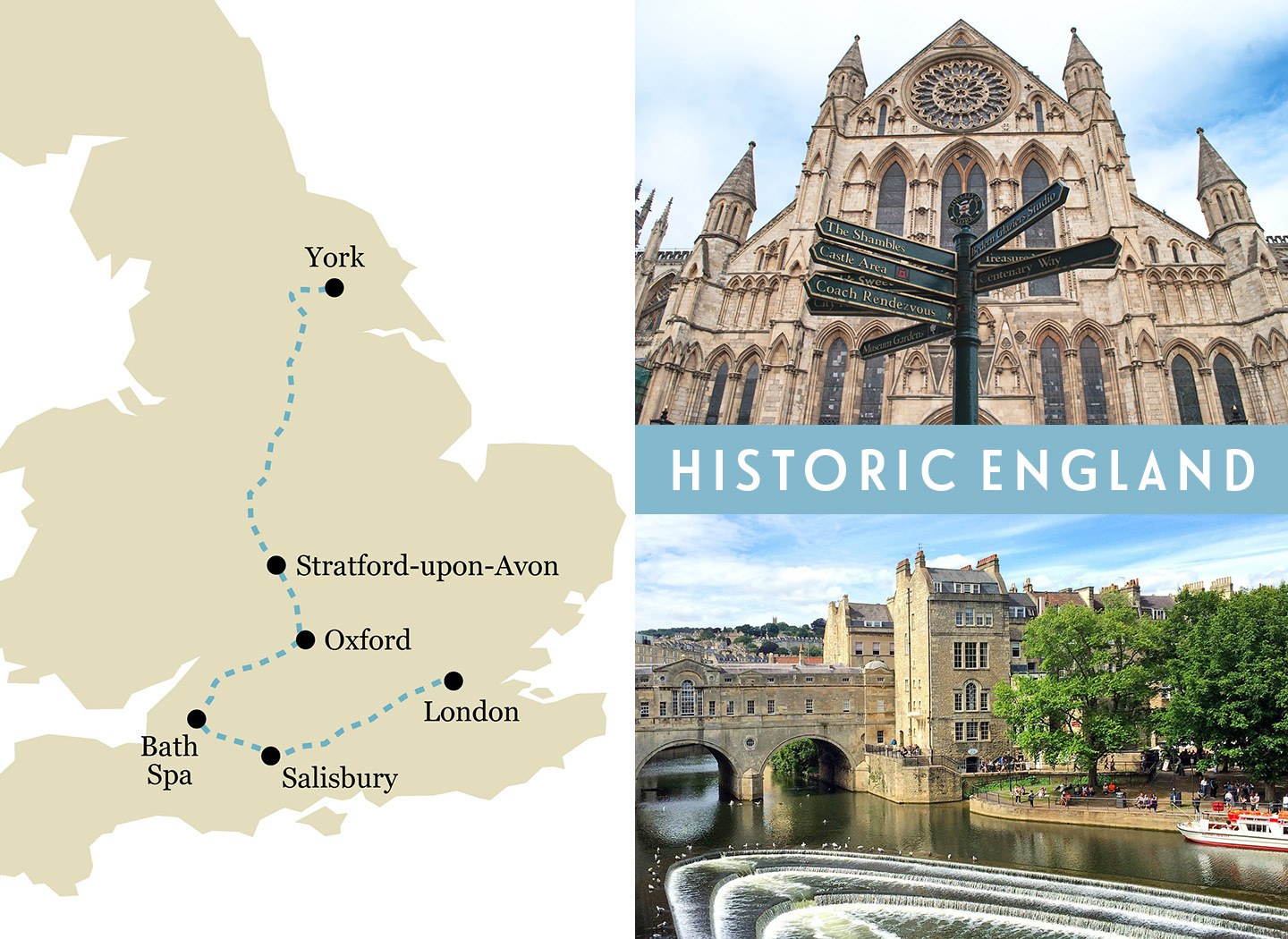
Scenic Scotland
Edinburgh > Glasgow > Fort William > Mallaig > Isle of Skye > Inverness
This Scottish rail itinerary takes you from the lowlands to the highlands via rugged coastlines, lakes, moors and castles. Start in Edinburgh and spend the day discovering the city’s highlights, from Edinburgh Castle and the Royal Mile to the Palace of Holyroodhouse and views from Calton Hill. Or discover hidden gems like underground Mary King’s Close .
Then catch the train on to Glasgow (1 hour), where the focus is on art, design and culture – from street art trails and the eye-catching modern Riverside transport museum along the redeveloped waterside to the Art Nouveau buildings of Charles Rennie Mackintosh.

Next head north to Fort William (3 hours 45 mins), a lochside town that’s a hub for adventure sports in the nearby Nevis Range. The journey takes you into the Scottish Highlands along the West Highland Line, rated as one of the most scenic rail trips in the world. Go hiking or biking, or taste whisky with a view at the Ben Nevis Distillery.
Rejoin the West Highland Line to travel across the Glenfinnan Viaduct to Mallaig (1.5 hours) – or from April to October you could upgrade to a ride on the Jacobite steam train , also known as the Hogwarts Express from the Harry Potter films. Then leave the train behind and cross over to the Isle of Skye on the ferry from Mallaig to Armadale.

Spend a day exploring the Isle of Skye by bus or tour, with the pretty harbour town of Portree, the waterfalls of the Fairy Pools and the dramatic rock formations of the Quiraing. Then the following morning, cross the bridge to Kyle of Lochalsh by bus (1 hour) where you can catch the train to Inverness (2 hours 40 mins), capital of the highlands.
The Kyle Line is another of the UK’s top scenic train routes, passing lochs, mountains and herds of deer. Spend the evening and next morning in Inverness. Explore the castle and riverside, take a monster-spotting trip on Loch Ness or visit historic Culloden battlefield.
Read the full Scenic Scotland by train itinerary
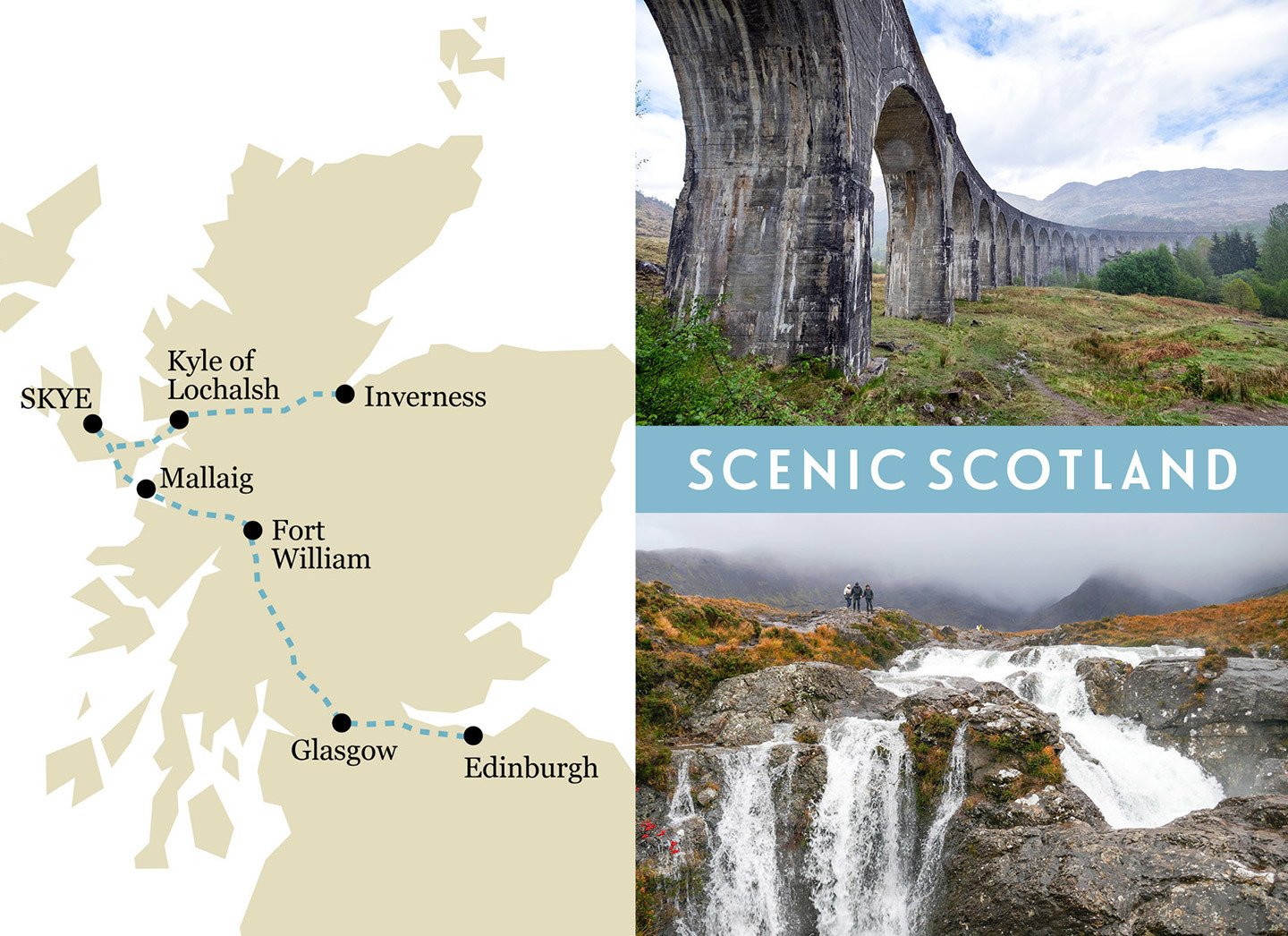
The Cornish coast
St Ives > Falmouth > St Austell > Newquay > Looe > Plymouth
This UK train trip takes you to the far south-west of England, along some of Cornwall’s most beautiful coastal and countryside railways. Start off in the arty seaside town of St Ives , home to the Tate and Barbara Hepworth galleries along with beaches and coast walks.
If you’re travelling from London you can get reach St Ives on the Night Riviera overnight sleeper train (8 hours), changing at St Erth onto the St Ives Bay Line which runs past the golden sands of Carbis Bay. Then travel east to Falmouth (1.5 hours), changing in Truro onto the Maritime Line which runs through unspoilt countryside to the coast.
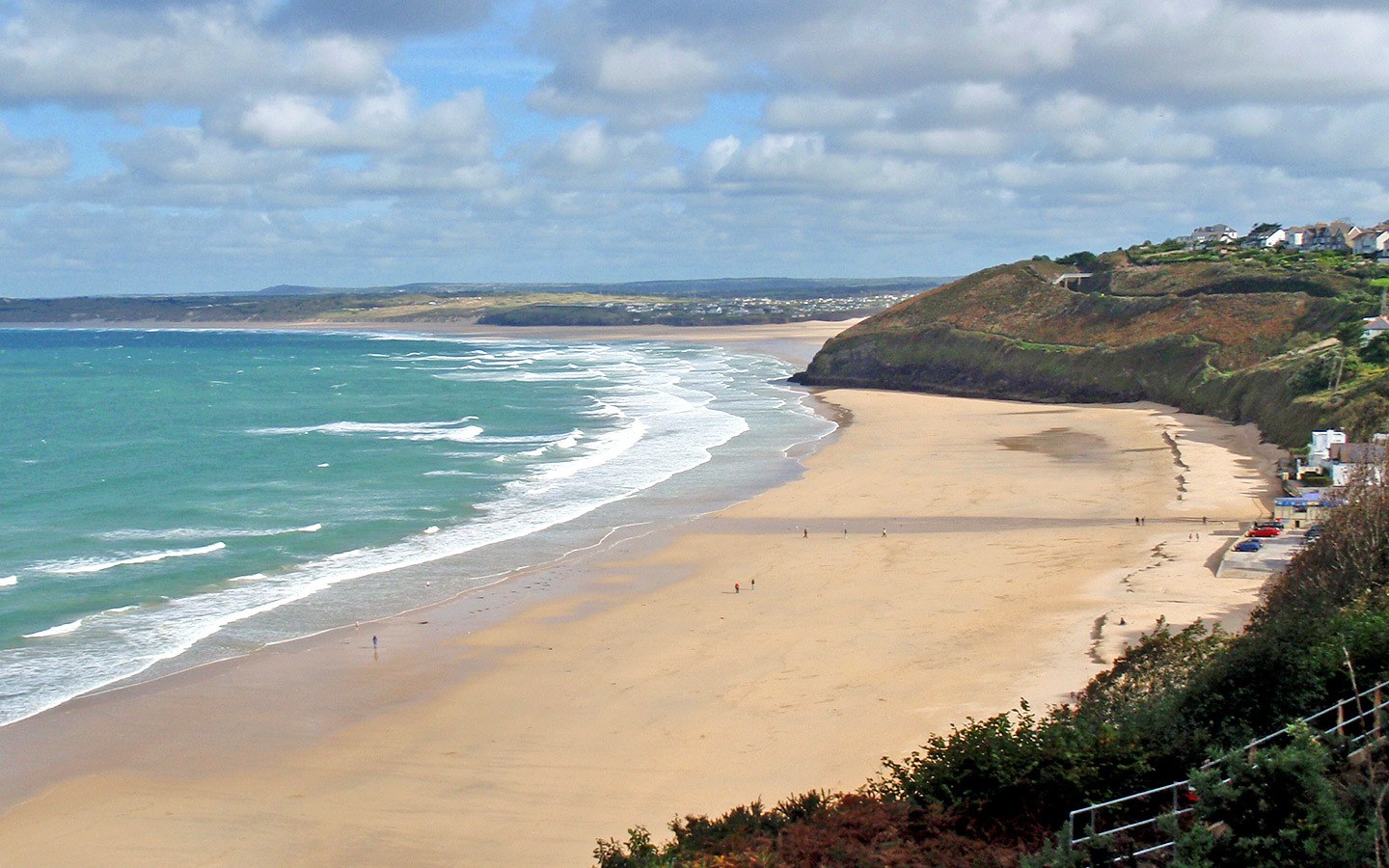
Visit Falmouth’s castle and maritime museum, or take a boat ride along the Fal River or across to neighbouring St St Mawes and the Roseland Peninsula. Then take a morning train to St Austell (1.5 hour) where you change onto a bus to reach the Eden Project, whose two giant biomes bring the rainforest and the Mediterranean to Cornwall.
Head back to St Austell to catch the train along the Atlantic Coast Line to Newquay (1 hour 20 mins). Check out some of Newquay’s 11 beaches and watch the surfers in action on Fistral Beach – or give it a try yourself. Grad a traditional Cornish pasty and watch the fishing boats come into Newquay harbour, or head underwater at Blue Reef Aquarium.
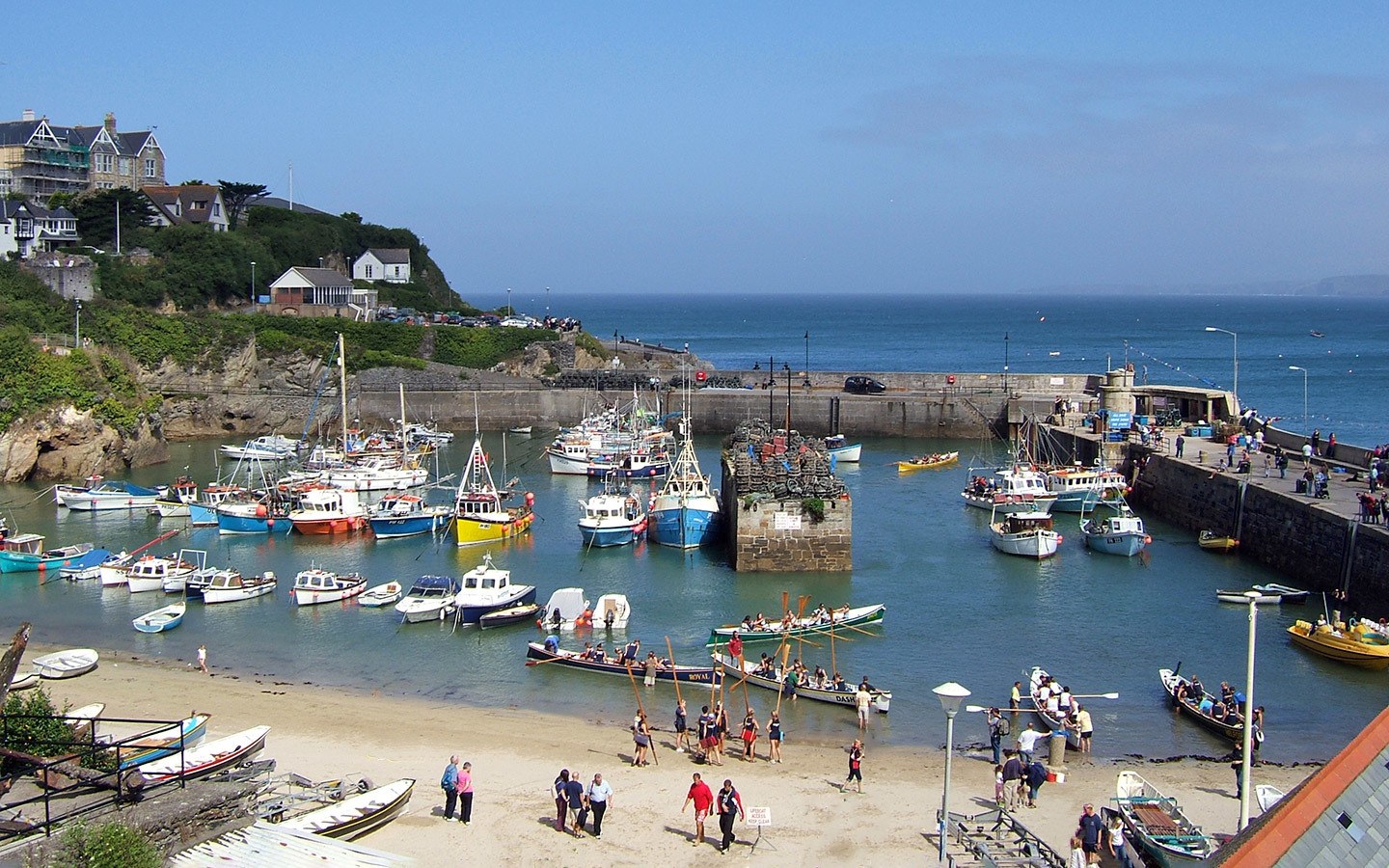
Then travel on to the pretty fishing village of Looe (3 hours). The Looe Valley scenic train line connects Liskeard and Looe, running along an estuary full of birdlife. Walk a stretch of the South West Coast Path to Polperro or visit the marine nature reserve of Looe Island, and make sure to try some local seafood and wine from Looe Valley Vineyard.
Finally travel on to your final stop in Plymouth (1 hour). Take a walk along the city’s waterfront, climb to the top of Smeaton’s Tower lighthouse and follow the journey of the Pilgrims at the Mayflower Museum before heading home – or exploring more of Devon.
Read the full Coastal Cornwall by train itinerary
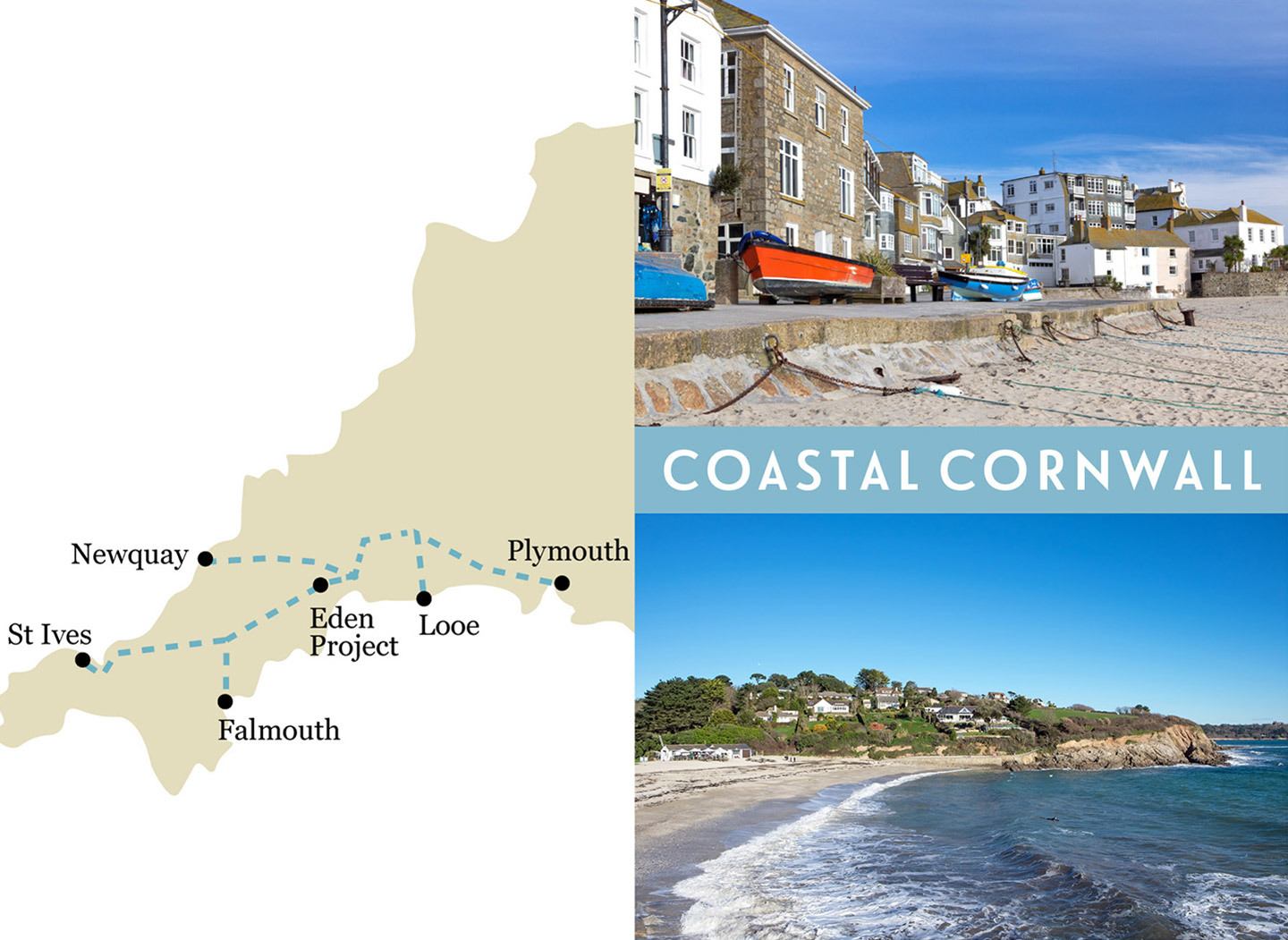
London > Brighton > Bristol > Manchester > Liverpool > Leeds
This city-centric train route takes you to some of the UK’s coolest cities, with coffee shops, vintage shops, street art and quirky bars along the way. Start off in London and the East End’s most hipster neighbourhood – Shoreditch. Visit Brick Lane market, take a graffiti tour and try food from around the world at the Box Park shipping container pop-up market.
Then catch the train south of London to Brighton (1 hour 15 mins) for a day at the seaside. Visit the Brighton Pavilion, browse the indie shops in the narrow streets of the Lanes and play the slot machines on the pier before tucking into fish and chips on the beach.

The next day travel west to Bristol (1.5 hours). This harbourside city is a centre for independent food, art and craft businesses. Try tasty street food at St Nicholas Market or at Cargo in Wapping Wharf, and go Banksy spotting in Stokes Croft. Visit Brunel’s historic steamship the SS Great Britain or walk over Clifton Suspension Bridge at sunset.
Catch the train north to Manchester (3 hours). This north-west city famous for its football and music is a great place to catch a gig or shop for vinyl and vintage fashion before a night in the Northern Quarter’s bars. Or visit the museums and media hubs of Salford Quays.
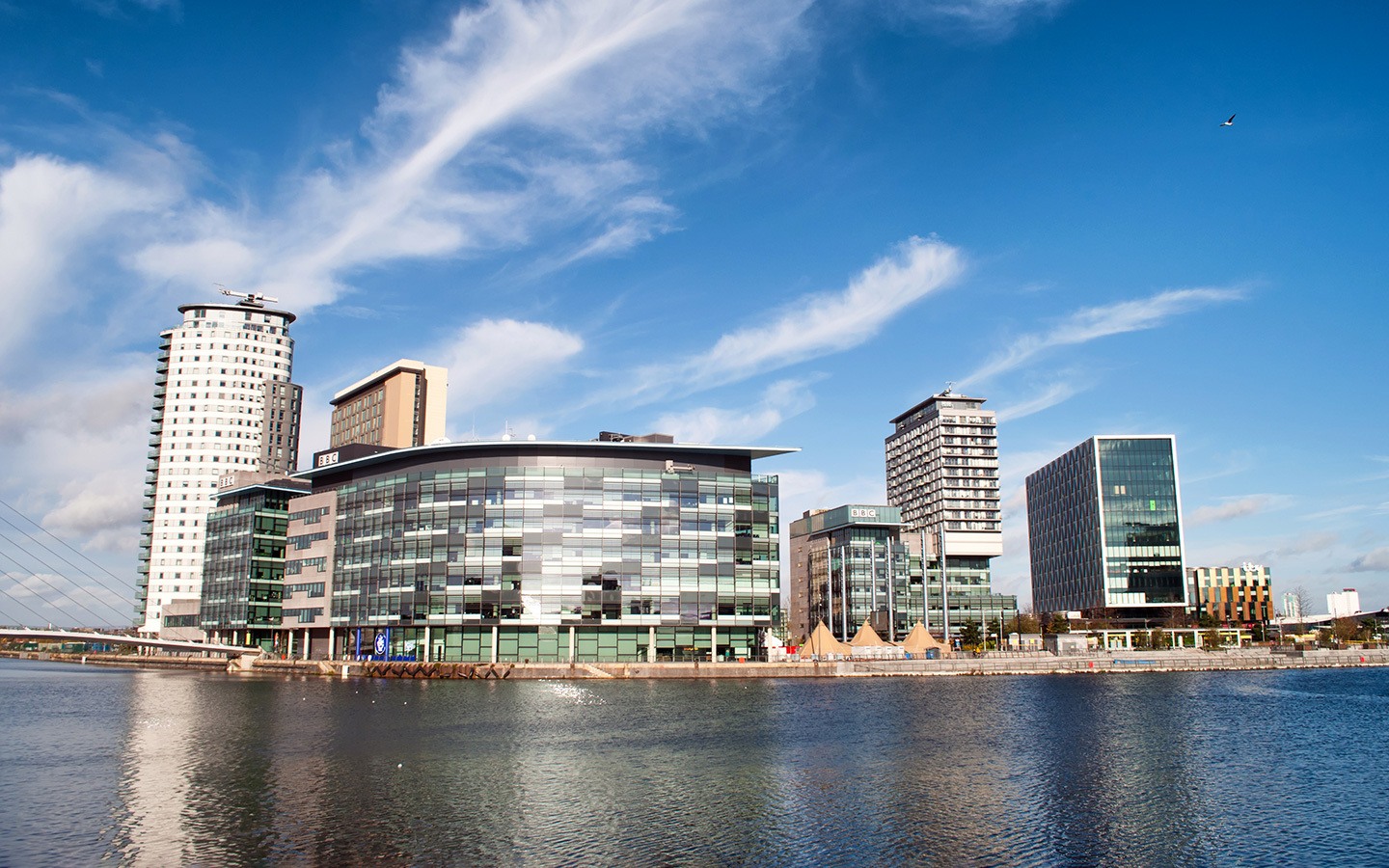
Then from Manchester, it’s only around an hour by train to local rivals Liverpool. Check out the exhibits at the Tate Liverpool and Merseyside Maritime Museum in the Albert Dock, or take a Beatles themed walking tour and catch the ferry across the Mersey.
Then finally travel north-east to the West Yorkshire city of Leeds (1.5 hours). Discover local artworks on the Leeds Welcome Art Trail, visit the Corn Exchange for boutique shops in a stunning setting, sunbathe in Roundhay Park or take a tour of Leeds’ craft breweries.
Read the full UK cities by train itinerary
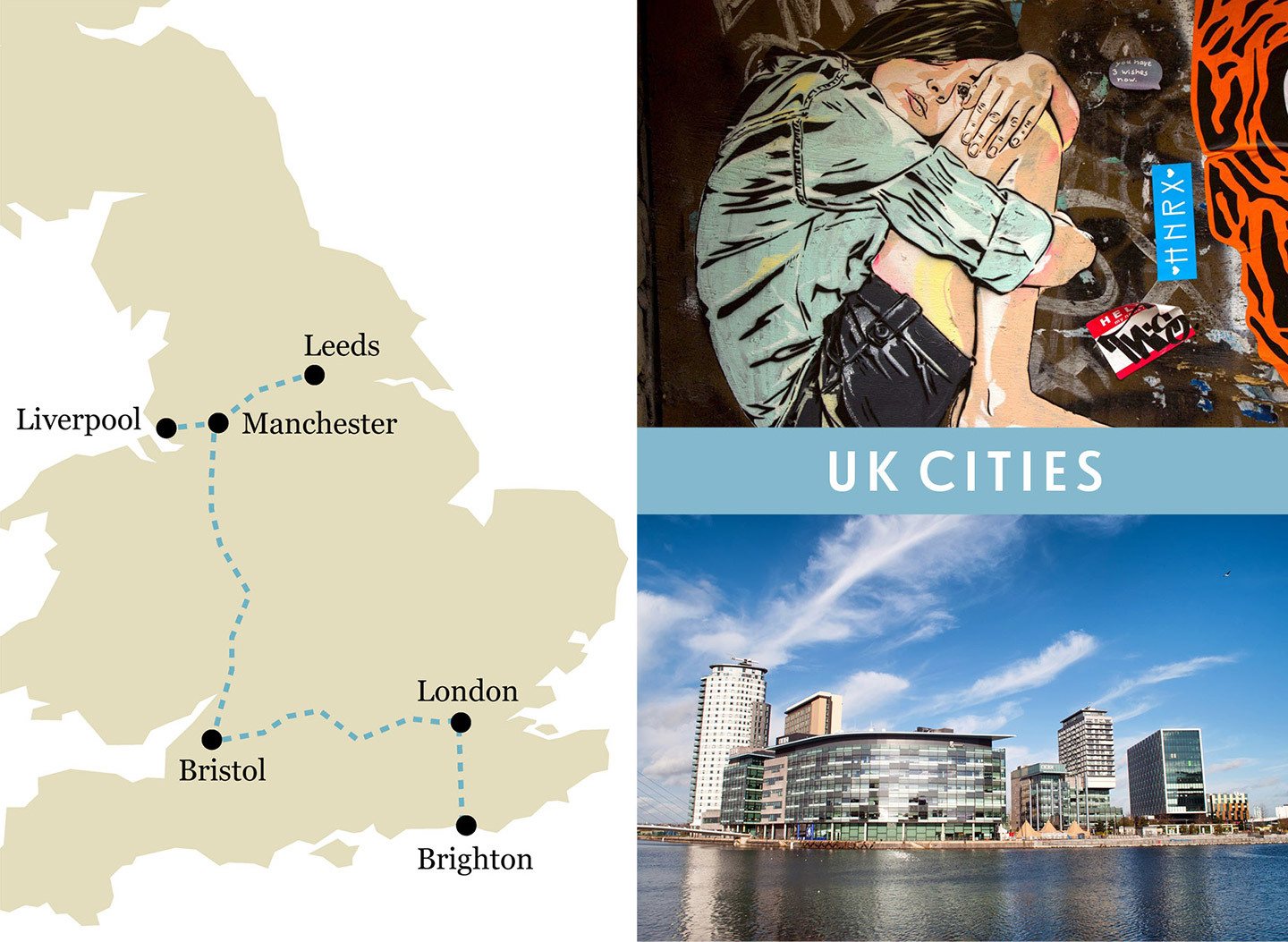
Wales and the Borders
Cardiff > Shrewsbury > Aberystwyth > Harlech > Llandudno > Chester > Cardiff
Our final Britain by train itinerary takes you across Wales, travelling from the capital through the unspoilt Welsh Marches to the spectacular coastline and mountains of North Wales. Start in Cardiff and spend the day exploring its historic side at the castle and its modern side among the contemporary buildings of redeveloped Cardiff Bay.
Then catch the train north to Shrewsbury (2 hours), a traditional market town across the border which was home to Charles Darwin. Visit its castle and take a boat trip on the River Severn. Then head back into Wales and the coastal town of Aberystwyth (2 hours) – a seaside holiday favourite with its sandy beach, Victorian promenade and Wales’ oldest pier.
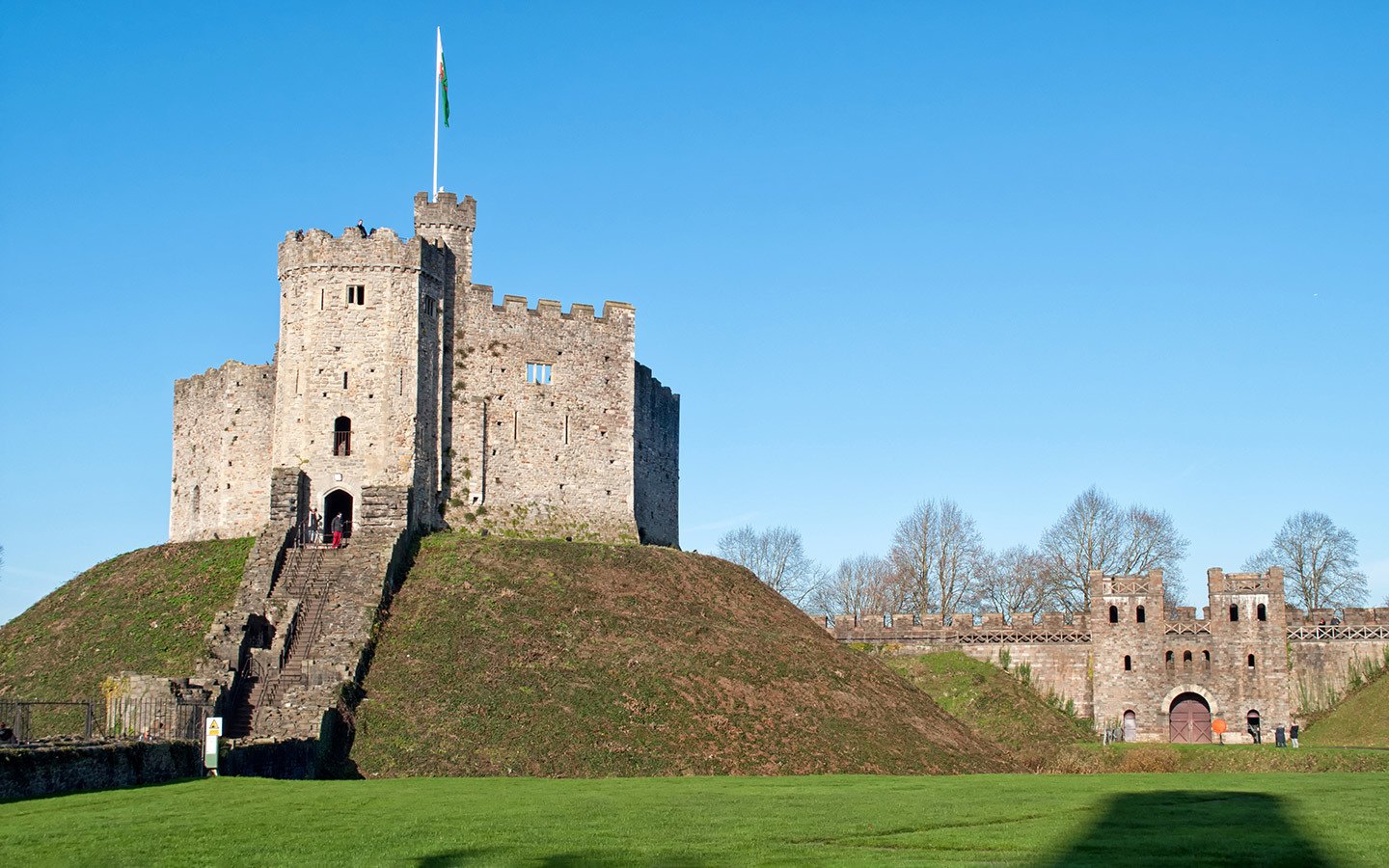
Next catch the Cambrian Coast Line north through Snowdonia (Eryri) National Park to Harlech (3 hours), with scenic views along the way as you cross the estuary at Barmouth. Then explore Harlech’s hilltop castle or take an afternoon trip to the nearby quirky, Italian-style village of Portmeirion (the closest station is at Minffordd, 15 mins from Harlech).
Next head to Porthmadog (25 mins) and change onto the Ffestiniog Railway’s historic steam trains to travel to Blaenau Ffestionig in style (1 hour 20 mins). (Note the Ffestiniog Railway only runs from March–October, so outside of that you’ll need to take a bus.)

Then head back into the 21st century as you travel on to Llandudno (1 hour 15 mins). Another of Wales’ Victorian seaside resorts, Llandudno has panoramic views from Great Orme, which you can reach on foot or via the vintage tram or Llandudno Cable Car.
Finally travel across the border to Chester (1 hour 20 mins). Explore the city’s Roman ruins, walk around its city walls, admire the Eastgate Clock and shop the medieval black and white Rows. Then finish off your trip by travelling south back to Cardiff, passing the impressive Pontcysyllte Aqueduct, Herefordshire countryside and Shropshire Hills.
Read the full Borders and Wales by train itinerary
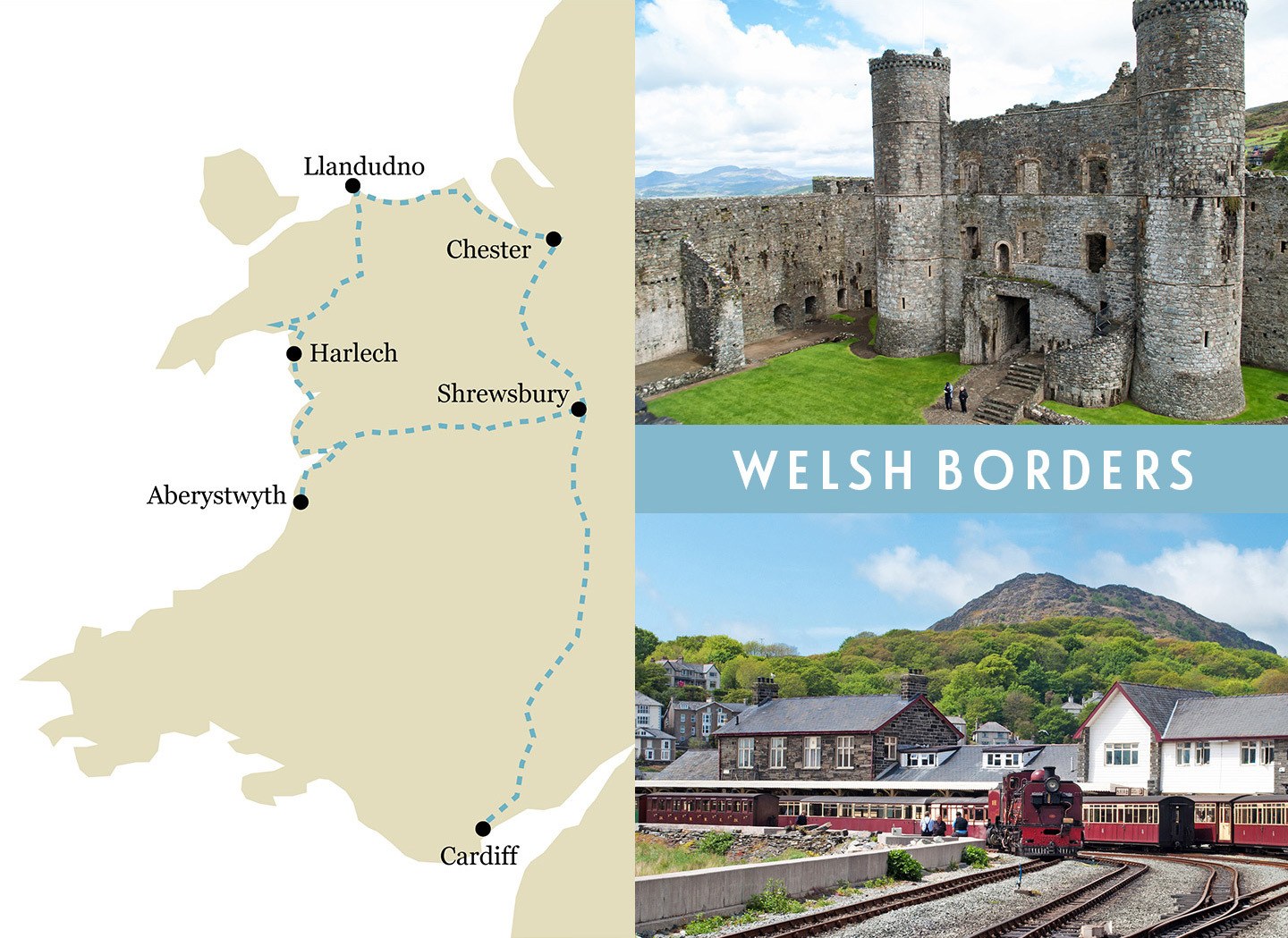
Don’t want to organise it yourself? You can also book a custom rail trip based on any of our Britain by train itineraries through our partners Byway ,* the flight-free holiday platform, which include transport and accommodation.
Save for later
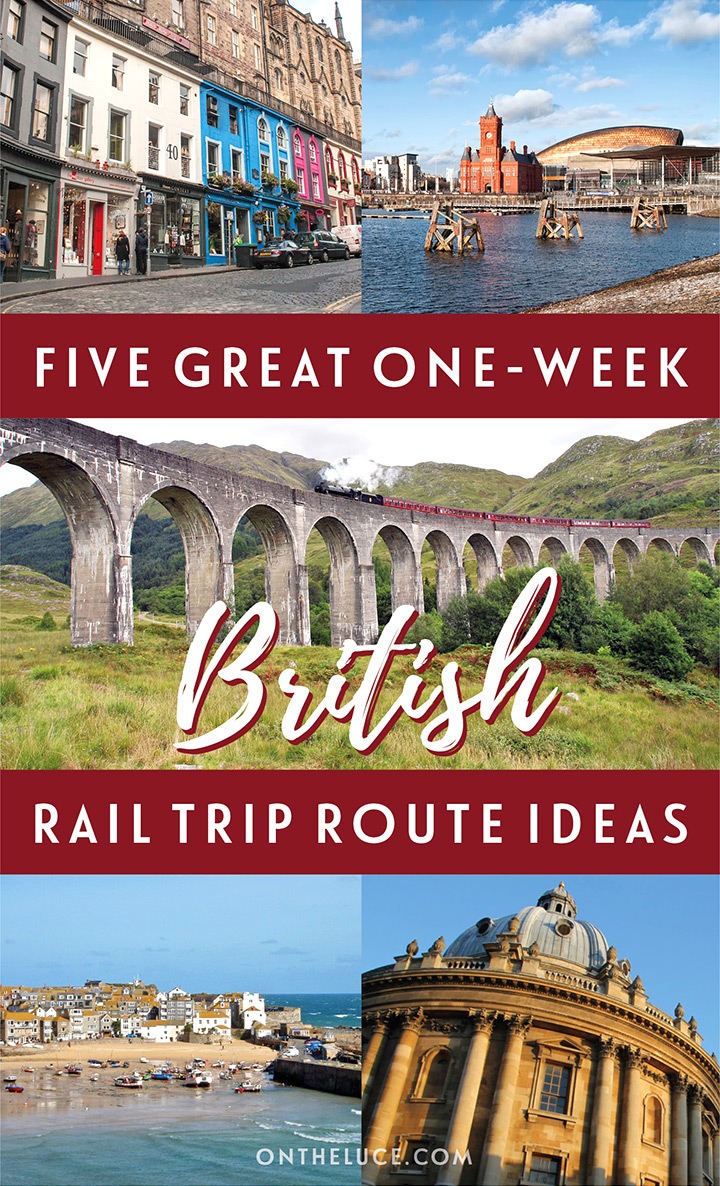
You might also like
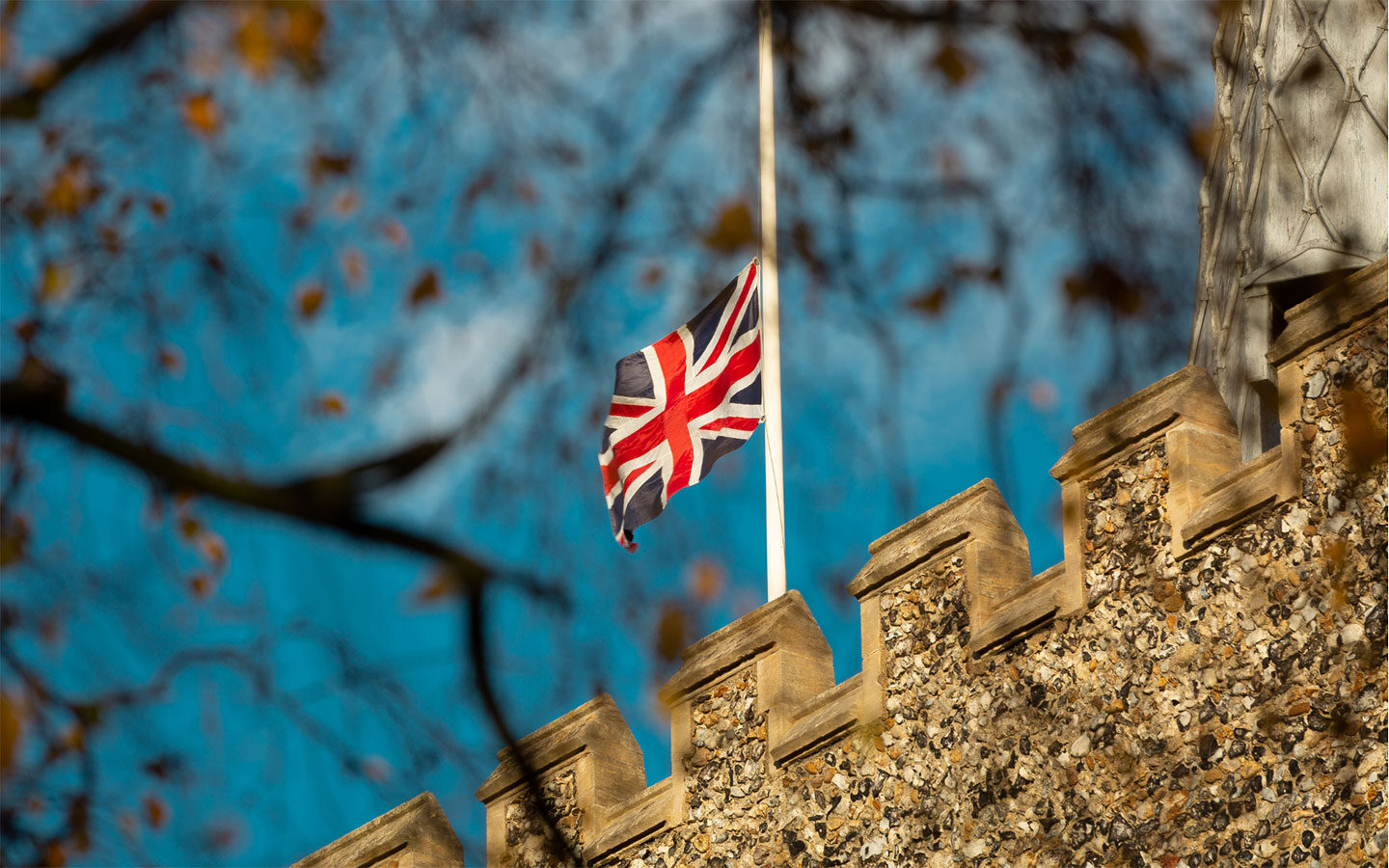
10 great UK weekend break ideas
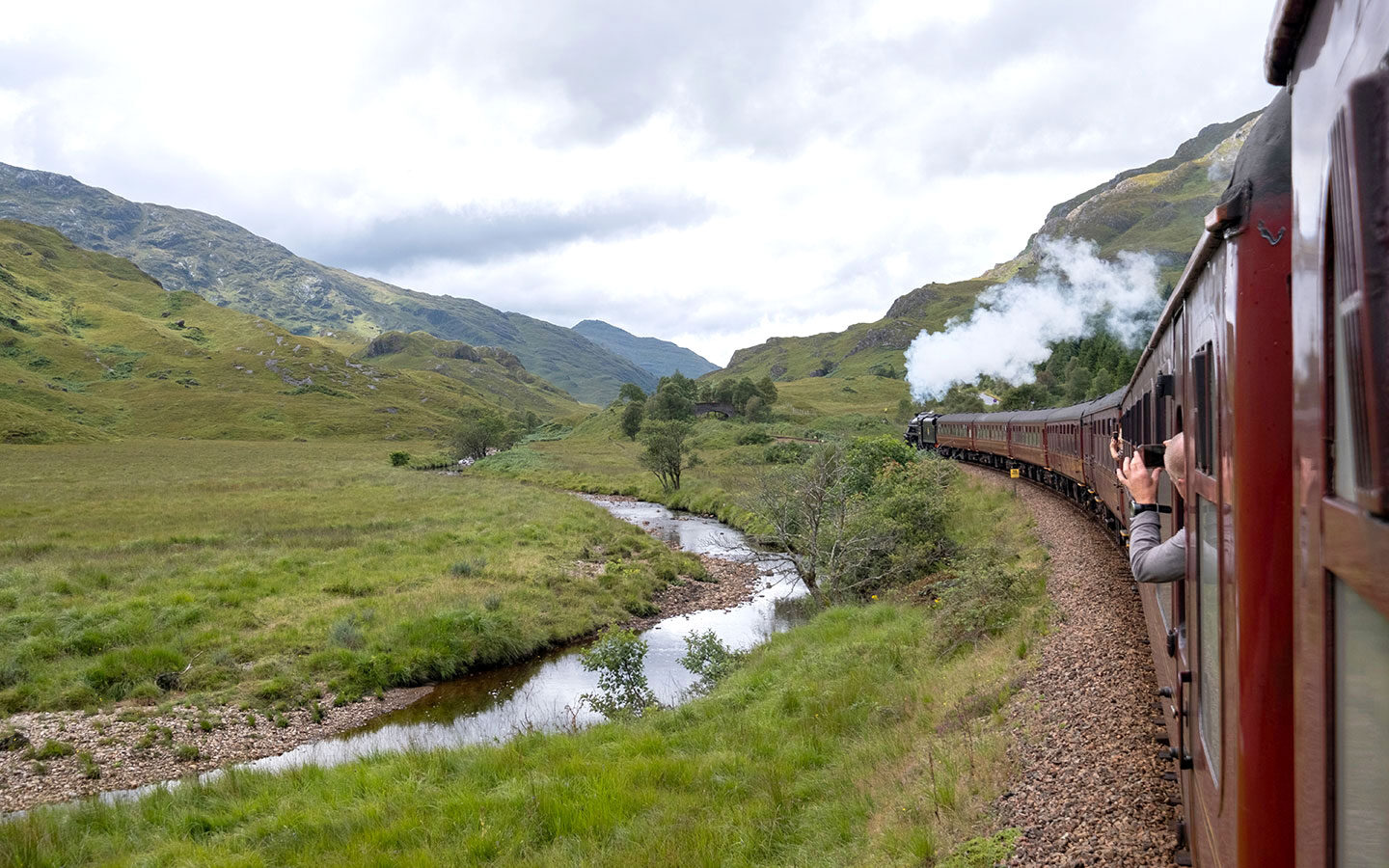
A guide to Scotland’s Jacobite steam train: The real Hogwarts Express

How to save money on train travel in the UK
Gregory Bass
Monday 15th of January 2024
Hey Lucy I enjoy reading about all your travels and Itineraries but feel that it would somewhat overwhelming for me to plan. It has been a dream of mine to travel the UK by car or train. Twenty years ago I traveled Spain and Portugal by train but there was no planning involved. I was younger and just took a train to a city or town and if I liked it I stayed and if I didn't I moved on. I have also planned a year of traveling the west coast of the US for work when I was younger and that was before GPS. I just don't feel I know where to start. We definitely will want London as the starting point and Harry Potter is a must have since my husband is crazy about the series. We plan on spending anywhere from 10 to 15 days and that will all depend on what we try to squeeze into our trip. I was wondering if you had any ideas on how to start and what to do and see that are must dos. I would want to depart from London as well so whatever we do will have to include returning to London. We like nice accommodations but don't want to break the bank. Our travel schedule would be sometime between May thru August of 2025. I do have friends that live there so some downtime to allow visits with them would be needed as well. Any suggestions you can give would be greatly appreciated.
Lucy Dodsworth
Monday 22nd of January 2024
Hi Gregory, if you want to book through a company I would recommend Byway who can organise custom train itineraries and book all the train travel and hotels for you. With 10–15 days you could cover a lot of the UK depending on what your interests are, or add on a trip on the Eurostar to Paris or Amsterdam.
Wednesday 31st of May 2023
Hi Lucy This site is great! My husband and I will be arriving at Southampton after a transatlantic cruise on Sat April 20, 2024. We don't have our return flight plans yet as we are hoping to stay in England for at least a week. In 2012 we spent a month (Sept) traveling and sightseeing the UK by rail and had a great time - carrying only backpacks. We had time to visit the popular spots: London, Bath, York, Chester, Edinburgh, Loch Ness, Penzance, Bournemouth, Aberystwyth and much of Wales. This time (we are older!) and we will have luggage (ugh). We are thinking about exploring some less touristy places and poking around smaller villages, etc. Maybe staying at a B&B or somewhere that is centrally located and near a well connected train station where we can take day trips or short rail excursions in and out. Is that possible or even a good idea? Where would you suggest? Do we need a travel agent? I expect we will depart from Heathrow. Any advice will be appreciated!!
Sunday 25th of June 2023
Hi Martha, one area I'd definitely recommend is the Cotswolds. You can stay in Moreton-in-Marsh which is on a mainline train route from London and get from there via train to Oxford and Stratford-on-Avon, and there is a good Cotswold tour from Moreton as well as buses to places like Broadway, Chipping Campden and Stow-on-the-Wold. I have a whole website about the Cotswolds with lots of info (https://explorethecotswolds.com) and it's easy to explore without needing a travel agent.
Tuesday 23rd of May 2023
Hi Lucy, We are going to be in UK for 14 total days (not including travel to and from the US). We want to do two of these (exactly what I was thinking and perfectly laid out, thank you!). Wondering if you can help me understand the best way to buy the train tickets. We are family of 4 with an 18 yr old and 16 yr old. Starting and ending in London - want to do this: London > Salisbury > Bath Spa > Oxford > Stratford-upon-Avon > York - then from York do this: Glasgow > Fort William > Mallaig > Isle of Skye > Edinburgh to catch the Tattoo then back down to London. Maybe I need a travel agent to help :-)
Friday 26th of May 2023
You can buy tickets for specific trains in advance from the rail companies but it might be worth looking at getting a railpass – either an InterRail One Country Pass for the UK or a Britrail pass – as that means you can be more flexible. You can buy these in advance online and there are good discounts for under 25s.
Thursday 27th of February 2020
This info is amazing, thank you for posting Lucy! I am researching/looking into traveling to the UK (specifically Scotland) for the first time (coming from Toronto, Canada) this year and wasn't really sure where to start in terms of transportation once I arrived. I have bookmarked your page just for future reference. These routes and links will be so helpful, especially for a newbie to the area.
Also, love your blog & will definitely check out more of your recommendations .
Monday 9th of March 2020
Thanks Amy, great to hear it was useful! And have a wonderful trip.
Ellen D Leeper
Wednesday 25th of September 2019
Hi Lucy, What a comprehensive and great resource! I heard dogs are allowed on trains in the UK? Any feedback on that? I have a small guy but we are doing a couple months in the UK and Scotland so thinking trains vs. driving are the way to go. Thanks for such a great website! I'll watch this one!
Thursday 26th of September 2019
Hi, yes you can take dogs on trains in the UK so you should be fine with that!

- English in the UK
- Why study English in the UK?
- Living and studying in the UK
- Booking your English course
- UK student visas
- British Council accreditation
- Student complaints procedure
- Student Emergency Support
- Where in the UK
- Choosing where you study
- Travelling around the UK
- Central England
- East England
- North of England
- Northern Ireland
- South East England
- South West England & Channel Islands
- South of England
- Your study options
- Types of accredited courses
- Types of course providers
- Your stay in the UK
- Student accommodation
- Student health & travel insurance
- Working and volunteering
Travelling around the UK - how to explore
Britain is a small country, and it is easy to travel between towns and cities.
Most language centres offer weekend trips as part of their student activity programme to popular places in the UK like Cambridge, Oxford, Stonehenge, Bath, Liverpool, Edinburgh and others.
If you want to travel on your own or with friends, it is easy to use public transport to explore the UK.

What is the fastest way to travel around the UK?
Trains are the fastest way to travel around the UK, especially for long journeys. When you travel by train, you can enjoy the green British countryside through the window and take a picnic for the journey.
How to get cheap train tickets:
- Train tickets are usually cheaper if you buy them online in advance. You can see train times, prices and buy online at www.thetrainline.com . For long distance journeys, train tickets can be very expensive if you buy them on the day of travel.
- Students aged 16 to 25 can buy a Young Person's Railcard if they plan to take multiple train journeys. This card costs £30, and you can save one third on all train journeys for a year.
What is the cheapest way to travel around the UK?
Coaches are usually the cheapest way to travel to UK cities and popular tourist destinations. For the best prices, book in advance.
National Express is the main coach company in the UK. Megabus also offer low-cost coach journeys between major cities. Prices start from £1!
How can I travel from the UK to Europe?
- Catch the Eurostar train from London to France or Belgium. The high-speed train travels under the sea (the English Channel) and only takes 2 hours 15 minutes to reach Paris. There are direct trains to Calais, Lille, Paris, Disneyland Paris and Brussels. And in the summer there are direct trains to the south of France: Lyon, Avignon and Marseille.
- Fly from any UK international airport to European cities, including Berlin, Barcelona, Prague, Amsterdam, Venice and Copenhagen. Flying is often the quickest and cheapest way to visit our neighbours in mainland Europe.
- Travel by coach. If you have longer than a weekend for your journey, international coaches can be the cheapest way to travel to Europe. Journeys often start in the evening and travel overnight.

Do I need a visa to visit other European countries?
Some students need a Schengen Visa to travel to other European countries. With this visa, you can visit most countries in the European Union.
- To find out if you need visa and how to apply visit the European Commission website
Cookies on GOV.UK
We use some essential cookies to make this website work.
We’d like to set additional cookies to understand how you use GOV.UK, remember your settings and improve government services.
We also use cookies set by other sites to help us deliver content from their services.
You have accepted additional cookies. You can change your cookie settings at any time.
You have rejected additional cookies. You can change your cookie settings at any time.
- Business and industry
Travelpac: travel to and from the UK (2023 edition)
Travel to and from the UK, with detail on traveller age and sex, trip purpose, length, and spending. From International Passenger Survey (IPS), quarterly data.
https://www.ons.gov.uk/releases/travelpactraveltoandfromtheuk2023edition
Official statistics are produced impartially and free from political influence.
Is this page useful?
- Yes this page is useful
- No this page is not useful
Help us improve GOV.UK
Don’t include personal or financial information like your National Insurance number or credit card details.
To help us improve GOV.UK, we’d like to know more about your visit today. Please fill in this survey (opens in a new tab) .
Select language
What are you looking for, latest covid-19 information.
VisitBritain/Rod Edwards

Introduction
Britain and Northern Ireland currently have no official COVID-19 restrictions in place, however there is still guidance on what to do should you catch coronavirus while here on holiday. For more information, please check the official government websites using the links below.
Getty Images

Northern Ireland
VisitBritain/Ben Selway

VisitBritain/Graham Niven

VisitBritain/Crown Copyright

Money blog: Tourist taxes being imposed across Europe (and in UK) - here's how much they all are
An increasing number of cities are either imposing or increasing the cost of tourist taxes on visitors. Read this and our other Weekend Money content below, and let us know your thoughts. We'll be back with live updates on Monday.
Saturday 18 May 2024 17:03, UK
Weekend Money
- How to sell your home without an estate agent
- Tourist taxes to watch out for in popular holiday destinations
- Childcare vouchers, hard work and new skyscrapers: What readers have said this week
- Three things you need to know from Money this week
Best of the week
- The rise of Michelin starred 'fast food'
- How much do buskers make?
- Basically... What is PIP - and what could government changes mean?
- How to make sure your car passes its MOT
- Money Problem : My workplace wants to pay us by the minute - what can I do?
- Best of the Money blog - an archive
Ask a question or make a comment
As we've been reporting in the Money blog over the last few months, an increasing number of cities are either imposing or increasing the cost of tourist taxes on visitors.
Many say they are preventing damages from overtourism, as well as funding local infrastructure and businesses.
Here are the latest tourist fees for the most popular spots in Europe...
Tourists visiting Venice for the day will have to pay a €5 entry fee to enter the city between the hours of 8.30am and 4pm.
Meanwhile, those staying overnight in Venice are charged a fee between €1 to €5 within the accommodation price for the first five consecutive nights.
People visiting the Spanish city now have to pay €3.25 if they're staying in official accommodation, up from €2.75.
Manchester
Visitors must pay £1 per room, per night across 73 hotels.
The scheme, which has raised more than £2m within a year, is for improvements to attract more tourists.
Tourists must pay €2 per person for every night they stay, although this is only applied for a maximum of seven nights.
The Greek government has introduced a Climate Crisis Resilience Fee to charge tourists anywhere from €0.50 to €10 per room, per night.
The amount depends on the hotel category and the time of year.
Visitors to the Croatian city must pay €2.65 per person, per night throughout April to September.
However, the fee has been temporarily reduced to €1.86 for the rest of this year.
Different amounts are charged depending on the type of accommodation.
The most expensive charge is €14.95 for a stay in palaces, and €0.65 at one or two-star campsites, per person, per night.
Those staying in a typical four-star hotel are charged around €8.
Those staying in the Hungarian capital are charged an additional 4% each night, which is calculated based on the price of the room.
Tourists in Berlin must pay 5% of the room price, excluding VAT and service fees.
The tourist tax here has increased from €0.82 to €1.97 per day.
Prices researched by travel insurance site Quotezone.co.uk
By Ollie Cooper , Money team
Estate agent fees are one of the big expenses in selling a house - but rule changes and the rise of private sale websites have made it more common for people to go it alone.
But how easy is it - and what do you need to know? We spoke to industry experts to find out.
Firstly, what do estate agents do for their money?
An estate agent will typically charge in the range of 1%-3.5% of the sale price.
That means for the average house price (£284,691 from December) you could pay anywhere from £2,846 to £9,964 in commission fees.
"When you use an estate agent, their fee includes taking professional photographs, advertising your home, conducting property viewings, and negotiating a price on your behalf," says Jack Smithson from the home ownership site Better.co.uk .
In addition, an estate agent will compile comprehensive details of your house, including room sizes and descriptions of fixtures and fittings.
"They will also provide a concise write-up about the local area, highlighting amenities, schools, and transportation links," Jack adds.
And they'll conduct checks on buyers for you (more on this later).
It sounds like a lot, but...
"Selling your home yourself can be a manageable process with a few key steps," Jack says.
Preparation
You should begin by thoroughly researching house prices in your area, using websites like Rightmove and Zoopla - but seek free valuations from local estate agents to ensure you have a realistic asking price in mind.
Next, you want to take high-quality photos of your house.
Jack advises using tutorials on YouTube to learn new shooting and editing techniques that can take you to the next level.
You then want to write down what makes your home unique.
"While browsing other listings for inspiration, take it a step further by emphasising what you love about living in your home and the surrounding area," Jack suggests.
"Whether it's the refreshing scent of the coastline or the tranquil sounds of village life, incorporating these details can help potential buyers visualise living there," he advises.
Like using YouTube for photography tips, you can use free tools such as ChatGPT and Grammarly if you need help with your writing, Jack says.
Advertising
This is probably the biggest perk of going through an established estate agent - your home is much more likely to be viewed because they will have an established audience and a market. But it's very possible to do it alone.
"When it comes to advertising your home, explore a variety of avenues including local newspapers and social media," Jack says.
"Consider using websites like Strike, which allow individuals to list their properties for free on platforms like Rightmove," he suggests.
Viewings
Once you've secured some viewings, you've got the opportunity to make it a bit more personal than estate agents ever could - a real advantage.
"Explain the reasons behind your decision to purchase the property, highlight its unique features, and share the aspects of your neighbourhood that make it a desirable place to live," Jack says.
The small things matter when showing people round - so try to take an objective look around before you bring anyone in.
Do the things you'd do normally - make sure it smells nice and it's clean and tidy.
"Lastly, it's worth knowing that you must legally provide potential buyers with a free Energy Performance Certificate (EPC)."
The sale itself
Perhaps the most daunting aspect is the physical exchange of contracts and money.
An estate agent would typically oversee the process of the initial offer acceptance to the transfer of keys to the new owner.
However, if you go it alone, you'll need to become the central point of contact - bridging the gap between your solicitor or conveyancer and the buyer and their legal representative.
"Once you've accepted an offer on your property, your first task is to draft what's called a memorandum of sale," Jack says.
This document is a written confirmation of your acceptance of the offer and details the agreed price along with any specific conditions you've both agreed to.
"It's then recommended to engage the services of a solicitor or conveyancer to ensure all legal obligations are met," Jack says (of course, you'll need to do this even if you have an estate agent).
The cost of hiring one typically ranges from a few hundred to over £1,000, depending on factors such as fixed fees, hourly rates, the complexity of the sale and additional costs like property searches or land registry fees.
"In the absence of an estate agent, you'll be responsible for keeping your buyer informed about the progress of the sale. This involves regular updates on the status of legal procedures and any relevant developments," Jack says, before adding that this can actually be a good thing.
"By taking on these responsibilities independently, you'll have greater control over the sale process. However, it will require you to be exceptionally organised, and you'll need to be very good at communicating too."
Any risks to be aware of?
Rita Patel, legal director at law firm Browne Jacobson , tells us the biggest risk for people selling their properties without an estate agent is the lack of a vetting and verification process of the potential buyer.
Estate agents will verify the buyer's identity and check the buyer's proof and source of funds - without this, there's no way to assess the buyer is legitimate and can afford to buy.
"Whilst this process is something lawyers can help with, this is often at an additional cost, and you'll need to start from square one if there is an issue with a potential buyer's identification and/or financial eligibility," Rita says.
More generally, selling without an agent can extend the time it takes to sell.
"Zoopla suggests this timeframe is normally around 17-34 weeks, but with no one on hand to consistently promote and drive the property sale at all stages, going solo drags this process out," Rita says.
"Agents can also help mediate any potential breakdowns in communication between the buyer and seller - reducing the likelihood of having to go back to market and start again."
The advantages
Laura Owen-Brown, a PR manager from Gloucestershire, tells us she is set to sell her house without an estate agent in the near future.
"My disappointment with estate agents stems from their lack of familiarity with the properties they attempted to sell me when I was buying my current house," she says.
"They couldn't tell me about the details that truly matter, like the optimal times for sunlight in the garden, how much council tax I'd pay, what the roof was made of, the places I could walk my dog off lead or the impact of post-football match traffic on Sundays.
"These types of details can shape the experience of living in a house for years and are just as important as the square footage, EPC rating or how many bedrooms a property has," she adds.
She says the current "transactional" approach to selling houses feels "impersonal and outdated" to her.
"Yes, I'll have to handle more admin, but the savings in both money and time will make it worthwhile. Liaising with buyers and solicitors directly without a third party slowing everything down will mean I can be in control and have transparency throughout the process, especially during negotiations," she says.
All in all...
As Laura says, it's very much a case of whether you can stomach the admin and are happy to take the risks on background financial checks.
If you are aware of all the above and willing to take on the organisational burden, you could save yourself a serious chunk of cash.
The main topics from the Money blog that got you commenting this week were...
Government-funded childcare
- Michel Roux Jr's comments about the future of the restaurant industry
Nearly 600 new skyscrapers for London
From last Sunday, eligible working parents of children from nine-months-old in England have been able to register for access to up to 15 free hours of government-funded childcare per week.
Those hours can be claimed from September.
Some readers pointed out the T&Cs...
This 15 hrs a week is for term time ONLY. So full-time working parents will have to either tell their employer they can't work in school holidays or pro-rata it across the year which is 10 hours a week. Yvonne grandma
Others said it spoke to issues in the wider childcare sector...
Is the government going to give pay rises to nursery staff? They are very low paid staff, and can't get enough staff as it is!! Nurseries may have to close if they don't get staff, so parents won't be able to take up the offer!! What is the government going to do about it? Carol
Chefs or delivery drivers?
Celebrity chef Michel Roux Jr has suggested that restaurants may only open three days per week because young people prefer other jobs - like delivering parcels.
"Just because I worked 80 hours a week or more doesn't mean the next generation should," he said.
"Quite the contrary. That is something that we have to address in our industry."
Readers said...
That's because one [job] is on the verge of slave labour and one definitely is slave labour. And the latter I'm referring to is working in a kitchen for a chef. Realist2024
Spent 35 years working as a chef. Young people nowadays are not willing to do the extra hours (usually unpaid) and work every weekend. Godsends like my generation of chefs did and do. Bucks
There's been considerable backlash in our comments section after a thinktank said a total of 583 skyscrapers are "queuing up in the pipeline" to be built across central London.
That is more than double the 270 built in the past decade...
"600 new skyscrapers on way for London" while the majority are struggling. When will something serious be done about growing wealth inequality in the UK? A growing economy is useless while the gap between the ultra rich and everyone else increases. Qwerty1
How many unnecessary skyscrapers for London? It's fine, as long as they are not made using steel, glass, concrete or bricks - don't people know there's a climate emergency? Shanghaiwan
Who's paying for it? What about the North? treelectrical
The energy price cap is set to fall by about 7% in July, a respected energy markets researcher has said.
Ahead of next Friday's announcement by Ofgem for the July-September period, Cornwall Insights said: "For a typical dual fuel household, we predict the July price cap to be £1,574 per annum" - a drop from £1,690.
Looking further ahead, it forecasted the cap will rise again slightly in October, before falling in January next year.
"A predicted 7% drop in energy prices in July is clearly good news, with the price cap looking likely to hit its lowest level in over two years," a spokesperson for Uswitch said.
Around 100 more prosecutions of sub-postmasters unrelated to the Horizon scandal could be "tainted" , a Sky News investigation has found, as officials worked with now discredited Post Office investigators to secure convictions.
The prosecutions of Post Office staff were led by the Department for Work and Pensions (DWP) between 2001 and 2006.
It is understood these usually involved the cashing in of stolen order books.
The Post Office itself wrongly prosecuted hundreds of sub-postmasters between 1999 and 2015 - based on evidence from the faulty Horizon accounting system.
Read more from our business correspondent Adele Robinson by clicking here ...
The UK's mega rich are dwindling in a sign Britain's "billionaire boom has come to an end" , according to the latest Sunday Times Rich List.
The list reveals the largest fall in billionaires in the guide's history - from a peak of 177 in 2022 to 165 this year.
While the combined wealth of the list's 350 wealthiest individuals amounts to more than £795bn - larger than the GDP of Poland - the guide's compiler says time will tell what impact a drop in billionaires could have.
"This year's Sunday Times Rich List suggests Britain's billionaire boom has come to an end," Robert Watts said.
Read on here ...
The Money blog is your place for consumer news, economic analysis and everything you need to know about the cost of living - bookmark news.sky.com/money.
It runs with live updates every weekday - while on Saturdays we scale back and offer you a selection of weekend reads.
Check them out this morning and we'll be back on Monday with rolling news and features.
The Money team is Emily Mee, Bhvishya Patel, Jess Sharp, Katie Williams, Brad Young and Ollie Cooper, with sub-editing by Isobel Souster. The blog is edited by Jimmy Rice.
The Body Shop’s administrators are to launch an auction of the chain after concluding that an alternative restructuring of one of Britain’s best-known high street retailers was not viable.
Sky News has learnt that FRP Advisory, which has been overseeing the collapsed business since January, is to begin formally sounding out potential buyers in the coming weeks.
The move raises the prospect of new owners taking control of The Body Shop, which was founded nearly half a century ago.
Read more here ...
The UK's mega rich are dwindling - in a sign Britain's "billionaire boom has come to an end", according to the latest Sunday Times Rich List.
Published today, the list reveals the largest fall in billionaires in the guide's history - from a peak of 177 in 2022 to 165 this year.
"Many of our home-grown entrepreneurs have seen their fortunes fall and some of the global super rich who came here are moving away."
Top of the list is British-Indian businessman Gopi Hinduja and his family, whose wealth of £37.2bn is the largest fortune in the ranking's history.
But other familiar names in the list saw their riches fall, with Sir Richard Branson's total dropping by £2.4bn, which is back to his 2000 level.
Last year's top climber Sir Jim Ratcliffe, who bought a stake in Manchester United this year, fell two positions with a decline of £6.1bn.
Euan Blair, Tony Blair's eldest son, made the list for the first time, as did Sir Lewis Hamilton.
It comes as the UK continues to deal with a cost-of-living crisis, with new figures this week revealing a record 3.1 million food bank parcels were distributed over the course of a year.
The top 10:
- Gopi Hinduja - £37.2bn
- Sir Leonard Blavtanik - £29.2bn
- David and Simon Reuben and family - £24.9bn
- Sir Jim Ratcliffe - £23.5bn
- Sir James Dyson and family - £20.8bn
- Barnaby and Merlin Swire and family - £17.2bn
- Idan Ofer - £14.9bn
- Lakshmi Mittal and family - £14.9bn
- Guy, George, Alannah and Galen Weston and family - £14.4bn
- John Fredriksen and family - £12.8bn
A group of social media influencers have been charged in relation to promoting an unauthorised investment scheme.
The Only Way Is Essex (TOWIE) original cast member Lauren Goodger, 37, former Love Island star Biggs Chris, 32, and Celebrity Big Brother winner Scott Timlin, 36, also known as Scotty T, are among seven TV personalities alleged to have been paid to promote the scheme to their combined 4.5 million Instagram followers.
The others charged by the Financial Conduct Authority (FCA) include former Love Islanders Rebecca Gormley, 26, Jamie Clayton, 32, and Eva Zapico, 25 and TOWIE member Yazmin Oukhellou, 30.
The UK's financial watchdog brought the charges in a crackdown on "finfluencers" who use their online platforms to offer advice and information on various financial topics.
It alleges that between 19 May 2018 and 13 April 2021 Emmanuel Nwanze, 30, and Holly Thompson, 33, used an Instagram account to provide advice on buying and selling investments known as contracts for difference (CFDs) when they were not authorised to do so.
The watchdog said CFDs were high-risk investments used to bet on the price of an asset, in this case the price of foreign currencies.
It previously warned that 80% of customers lost money when investing in CDFs.
Mr Nwanze has been charged with running the scheme. He faces one count of breaching the general prohibition of the Financial Services and Markets Act 2000, and one count of unauthorised communications of financial promotions.
Ms Thompson, Mr Chris, Mr Clayton, Ms Goodger, Ms Gormley, Ms Oukhellou, Mr Timlin and Ms Zapico each face one count of unauthorised communications of financial promotions.
All nine will appear at Westminster Magistrates Court on 13 June.
The FCA asked anyone who believed they had sustained a loss due to the scheme to contact its consumer contact centre.
A hotel part-owned by Gary Neville and other ex-Manchester United legends has been named one of the best places to work in hospitality.
Each year, The Caterer releases its top 30 best places for employees in the sector, with the top six featuring some familiar names.
The list is compiled via anonymous employee survey - with no input from managers or owners.
Hotel Football, the only hotel with a rooftop five-a-side pitch, was among the top six venues selected by employees across the UK.
The hotel's benefits package was particularly well-praised by those who work there - given that it "prioritises the financial wellbeing of employees during the cost of living challenge".
Management at the hotel, which is situated next to Manchester United's Old Trafford stadium, was also praised for enhanced maternity, paternity, parental and adoption leave policies and a strong belief in diversity and inclusion.
The other five to make up the top six are The Biltmore in Mayfair, Cycas Hospitality (which has 18 locations across the UK), Dalata (which boasts some 1,000 employees), Gleneagles Hotel in Edinburgh and Nobu Hotel in Shoreditch, London.
The energy price cap is set to fall by about 7% in July, a leading thinktank has said.
Cornwall Insights said: "For a typical dual fuel household, we predict the July price cap to be £1,574 per annum" - a drop from £1,690.
Looking further ahead, it forecasted the cap to rise again slightly in October, before falling again in January next year.
Reacting to the news, Uswitch said the predicted drop was "clearly good news".
"The future still remains uncertain, and with the price cap changing every three months – currently expected to rise in October before falling slightly in January – it's crucial not to be complacent," Richard Neudegg, director of regulation, said.
However, "a predicted 7% drop in energy prices in July is clearly good news, with the price cap looking likely to hit its lowest level in over two years", he said.
He also urged households who want to lock in rates for price certainty to run a comparison to see what energy tariffs are available to them.
"There are many 12-month fixed tariffs available at rates cheaper than the current price cap, and even some that are 2% below these new predicted July rates," he said.
Be the first to get Breaking News
Install the Sky News app for free

NEWS... BUT NOT AS YOU KNOW IT
London Tube ticket from the 80s drives home just how much fares have risen

Share this with

An old London travel card reveals how much the cost of Tube travel has increased over the years.
London would not be the same without the underground.
Whether you love it or hate it, the Tube has been a fundamental part of life in the capital since it opened more than 160 years ago.
Ticket price increases on the Transport of London network are also a regular occurrence – although fares were frozen again this year.

A Londoner discovered a 1988 London Underground travel card when going through their parents’ old books, sharing the rare find online on Reddit.
It shows how much prices have ballooned since.
Back then, an off-peak travel card across zones 1 to 3 for one day cost £2, MyLondon reports.

Because of inflation, that equals £5.36 today.
Today, hopping on the Tube for one day of travel between zones 1-6 will set you back by £15.90.
The discovery sparked nostalgic memories on Reddit, with one user saying ‘that’s a blast from the past. People selling cards at stations! I remember doing it too.’
Another said: ‘Wow, talk about nostalgia! Back then I was riding the tube in to University every day.’
Latest London news
- Boy, 6, dies after falling more than 150ft from tower block
- Iconic London gay bar up for sale after it didn't show Eurovision in Israel row
- Urgent measles warning to parents as cases rise in London
To get the latest news from the capital visit Metro.co.uk's London news hub .
Travel cards were introduced on the London Underground and buses in 1983, while day tickets were launched the following year, according to MyLondon .
The graphic below reveals how much Tube prices have increased for one-day travel cards in zones 1 to 4.

Londoners let out a sigh of relief in 2016, when TfL announced a ticket price freeze.
Passenger fares were frozen between 2017 and 2020, preventing a rise of 12%, the BBC reported.
The Mayor of London Sadiq Khan announced another fare freeze in January until March 2025 ahead of the mayoral race .
It comes after the transport authority announced an average rise of 5.9% last year.

The average pay-as-you-go Tube fare went up by 30p, while the fare for a single bus journey increased by 10p, according to the broadcaster.
A spokesperson for the Mayor said Khan pledged to freeze TfL fares until at least 2025 to ‘support Londoners with the cost of living crisis.’
‘This is the fifth time Sadiq has frozen fares as he continues to build a greener and fairer London for everyone,’ they added.
Overall consumer prices in Britain have increased by around 236% since the ticket was issued.
The Tube has been modernised since it opened, including the addition of the Elizabeth Line , a better phone signal and an off-peak Friday price trial announced by City Hall.
Passengers are set to get mobile signal within most of London underground by the end of this year – to the delight of those who rack up hours of travel on the Tube each month.

Stretching 249 miles, the underground network has hundreds of secret passages, historical Grade II-listed stations and even ghost platforms.
If you ever feel you are being watched when catching the Tube, it could be because some of the passages have metal grates with views of unassuming passengers.
Travel influencer Dan Thomas revealed a tour of the historic passages.
It could also be because there are more than 15,500 CCTV cameras in the London Underground.
@danthomasuk Replying to @Dan Thomas | Travel & Music🩵 The Hidden Tunnels in Shepherds Bush Station Others in Baker Street: @Dan Thomas | Travel & Music🩵 TFL transport museum Hidden London tour Secret London Abandoned stations Closed underground stations Closed tube station For fans of Secrets of the London Underground and Siddy Holloway #hiddenlondon #secretlondon #londonunderground #abandonedplaces #abandonedstation #tfl #londontube #shepherdsbush ♬ Lovin On Me – Jack Harlow
A TfL spokesperson told Metro.co.uk if it plans to extend the off-peak Fridays trial: ‘We continue to analyse the impact of our trial of off-peak pay as you go fares on Tube and rail services on a Friday, which remains ongoing until May 31.
‘This analysis will take into account a number of aspects including assessing changes to both morning peak ridership and overall daily ridership, as well as the impact to businesses across London.’
The London Underground

Here is everything you need to know if you ever find yourself in a Tube-themed pub quiz.
The underground was affectionately nicknamed Tube after the shape of its tunnels.
The Tube opened in 1863, and since then the passenger numbers have increased to a whopping 1.35 billion each year.
Today, it boasts 11 lines with 272 stations stretching across the capital and beyond Greater London.
The furthest Underground station from central London is Chesham in Buckinghamshire located in zone 9.
It stretches for 249 miles.
The busiest station is Waterloo with 100.3 million passengers annually, according to TfL.
Waterloo is also the station with most escalators – 23 in total.
While the average train speed across the Tube is around 20 mph, the Metropolitan Line can reach speeds of up to 62 mph.
Get in touch with our news team by emailing us at [email protected] .
For more stories like this, check our news page .
MORE : Royal Vauxhall Tavern future hangs in the balance after row over Eurovision boycott
MORE : Urgent measles warning to parents as cases rise in London
MORE : How Britain’s shopkeepers are fighting back against flower pot stealth tax
Sign Up for News Updates
Get your need-to-know latest news, feel-good stories, analysis and more.
Privacy Policy

Get us in your feed

Britain by train – top 10 UK rail journeys (+ map & tips)
By: Author Tracy Collins
Posted on Last updated: October 21, 2022
Are you planning to take some rail journeys around Britain in the future? Are you confused about using the UK rail network? Not sure where to start to put together your train trip itinerary? Perhaps you have limited experience of rail travel or are unsure of where to go in Britain via train?
In this article you will find all the help you need to start your planning. Reflecting on a background of 25+ years working (and 50+ years travelling) on the UK rail network we have picked 10 of the top UK rail journeys to take around the country and the journeys which will enable you see the best of Britain by rail .
Tip – If you are considering travelling around the UK by train it may be cost effective to purchase a BritRail Pass to cover your rail travel. There are a variety of different passes available – click here for more information about the BritRail Pass.
1. London Paddington to Penzance Cornwall
2. london euston to glasgow central, 3. london liverpool street to birmingham new street via cambridge & ely, a. london kings cross to edinburgh waverley, b. london st pancras to edinburgh waverley via sheffield, complete guide to uk train travel written by doug and tracy collins.
- 6. Birmingham New Street to Llandudno via Hereford, Shrewsbury & Chester (+optional return to Shrewsbury via the Blaenau Ffestiniog Independent Narrow Gauge Railway)
7. Sheffield to Manchester Piccadilly (extend to Liverpool Lime Street)
8. glasgow to fort william and mallaig (west highland line), a. edinburgh waverley to inverness via dundee or aberdeen, b edinburgh waverley to inverness via stirling, listen to our introduction to uk train travel podcast, read our guide to travelling on the uk train network, where can i book tickets for these journeys, how can i save money on uk train travel, enjoy your rail journeys in the uk and beyond.

London Paddington > 3 hours > Reading > Taunton > Tiverton > Exeter > Newton Abbot > Totnes > change at Plymouth > 2 hours > lots of small stations including Liskeard St Austell Truro St Erth (change for St Ives) > Penzance 305 miles from London Paddington to Penzance Cornwall (via Plymouth)
This journey takes around 5 hours from London Paddington to Penzance in Cornwall (with a change of train in Plymouth).
The train operating company for this journey is Great Western Railway.
The first part of the journey takes you from the hustle and bustle of London on Brunel’s Great Western route to the West Country . At Plymouth you change trains from the faster modern service to a smaller regional service which features regular stops at smaller quaint stations.
Beautiful scenery typifies this route as it passes through several counties including Somerset, Wiltshire, Oxfordshire, Devon and into Cornwall .
Places of historical interest on this journey include the cathedral city of Exeter.
If you to wish to include a visit to the beautiful city of Bath in your itinerary it is possible to take an alternative route. Catch a CrossCountry train service from London Paddington to Bath then onto Bristol (1 hours 20 mins to Bath and an additional 15 minutes to Bristol)
Trains to Plymouth from Bristol/Bath take approximately 2 hours. At Plymouth connect with the Penzance train.
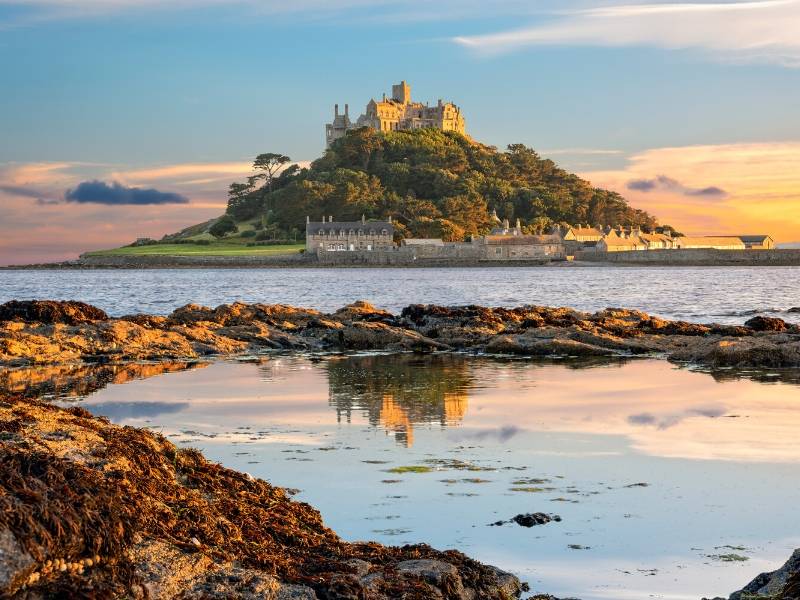
Good to know – To provide an additional option there is a Cornwall sleeper train service called the Night Riviera . This leaves from London Paddington 6 times a week starting on Sunday evenings with Penzance its final destination. There are around 15 stops in-between.
It departs London Paddington at 23:45. Cabin passengers can board at 22:30 pm. It arrives at Penzance the next morning at around 8 am. Seating options are available as well as sleeper cabins. The Night Riviera is operated by Great Western Railway .
Alternatively travel back to London via train. The Night Riviera leaves Penzance at 21:45 (21:15 Sundays) and arrives into Paddington at around 5:30 am.
Click for ticket prices
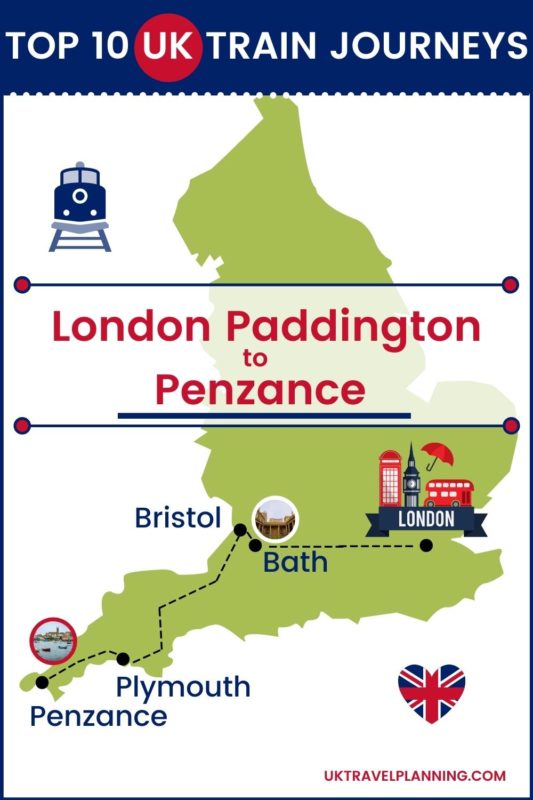
London Euston > 4 hours 50 minutes > Glasgow Central 343 miles from London Euston to Glasgow Central
The train journey takes you up the West Coast Mainline . This is a fast service which is perfect if you want to get from London to Glasgow quickly.
This 4 hour 50 minute trip has no changes. There are a limited number of stops which includes principal stations only so as to decrease travel time.
At present this route is operated by Avanti West Coast . There are new trains on order for this route.
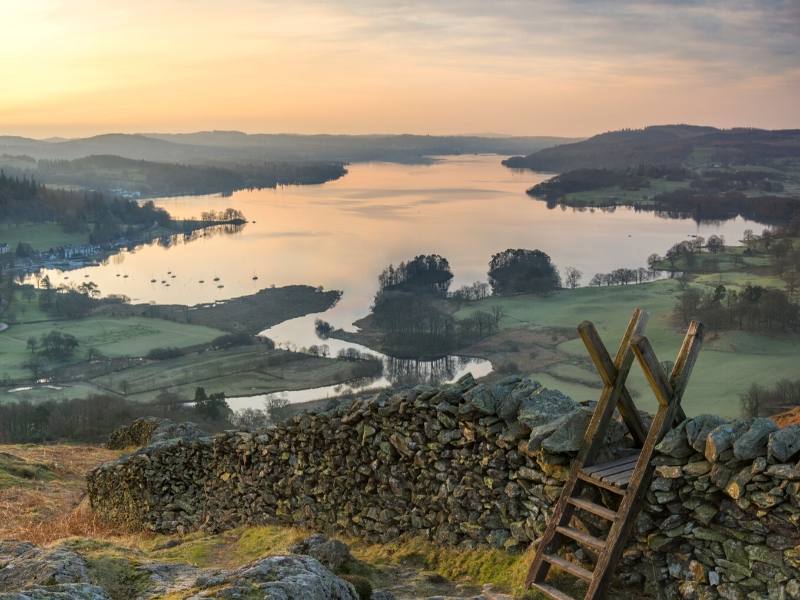
The route incorporates some of the most beautiful countryside in northern England including the Lake District .
This service takes you into the centre of Glasgow perfect to pick up other train services in Scotland.
Good to know – Travel during daylight hours (leave early in the day) to enjoy the scenery en route.
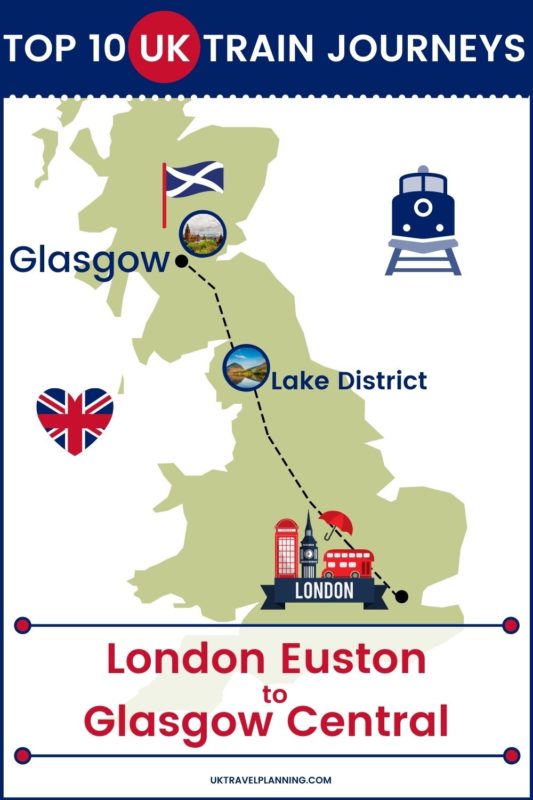
London Liverpool Street > 1 hour 15 mins > Cambridge > 15 minutes > Ely > 30 mins > Peterborough > 60 mins > Leicester > 50 mins > Birmingham New Street
Trains leave roughly every 15 minutes (Monday to Friday/less frequently during weekends and public holidays) from London Liverpool Street direct to Cambridge. This takes approximately 1 hour 15 minutes and is currently operated by Greater Anglia .
Stop off in Cambridge as it is worth exploring. The station is about 45 minutes from the main centre though buses are available outside the station (directly outside and to the left)
The train from Cambridge to the historic cathedral city of Ely takes approximately 15 minutes. This is a CrossCountry service and the train’s final destination will typically be Birmingham New Street (total travel time Cambridge to Birmingham New Street is 2 hours 45 minutes)
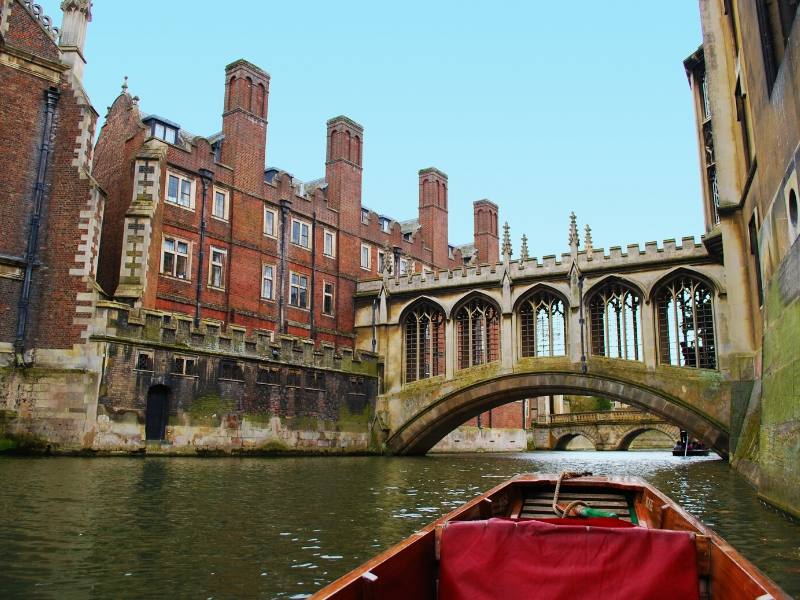
The first calling point after 15 minutes is Ely. Even if you don’t plan to get off keep an eye out for beautiful 12th century Ely Cathedral on the hill on the left hand side of the train as you approach the town. It is a 10 minute walk from the train station into Ely town centre.
After Ely the train calls at Peterborough. This is a stopping point on the East Coast Mainline so you could hop onto that line at this point for travel to York/Durham/Newcastle and Edinburgh.
After Peterborough the train calls in at Leicester then onto Birmingham New Street.
This is not a fast route and you will be using more regional services with a multitude of station stops but it is a great way to see the country.
Good to know – At Ely there is also a lovely train trip to Norwich over the Norfolk countryside.
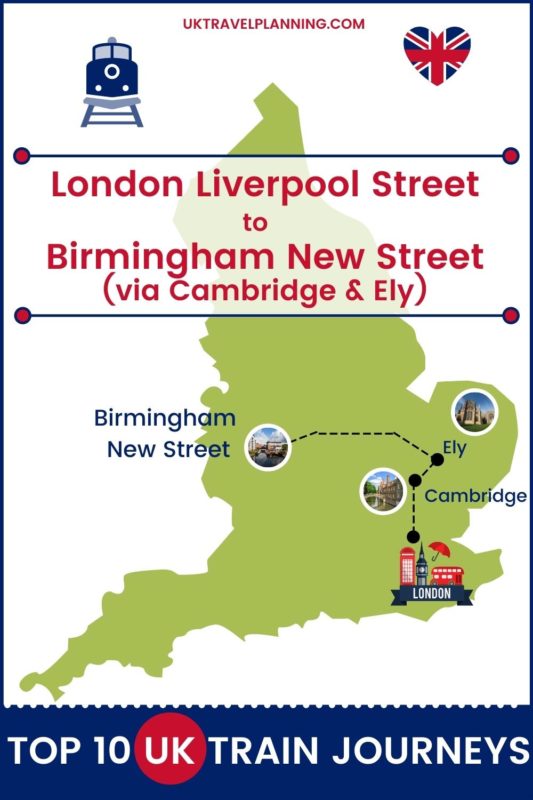
4. London to Edinburgh
There are various routes to take from London to Edinburgh depending on your preferences. I am going to talk about 2 possible routes.
London Kings Cross > 2 hours > York > 50 mins > Durham > 15 mins > Newcastle > 1 hour 45 mins > Edinburgh
London Kings Cross to Edinburgh Waverley is along the East Coast Mainline route.
This is the most direct route to Edinburgh from the capital and takes approximately 4 hours and 30 minutes. The route is operated by London North Eastern Railway (LNER)
General stopping points include Peterborough, York , Darlington, Durham and Newcastle. The route is best for speed and new modern trains tend to service this line. This is the route of the famous Flying Scotsman steam train.
The route from Newcastle to Edinburgh is particularly scenic as you hug the Northumberland coastline. Sit on the right for views of Bamburgh Castle and the Holy Island of Lindisfarne .
Good to know – This journey is about the rail experience and getting to Edinburgh quickly from London. It zooms through the cities and countryside so you don’t get time to absorb the countryside as you travel.
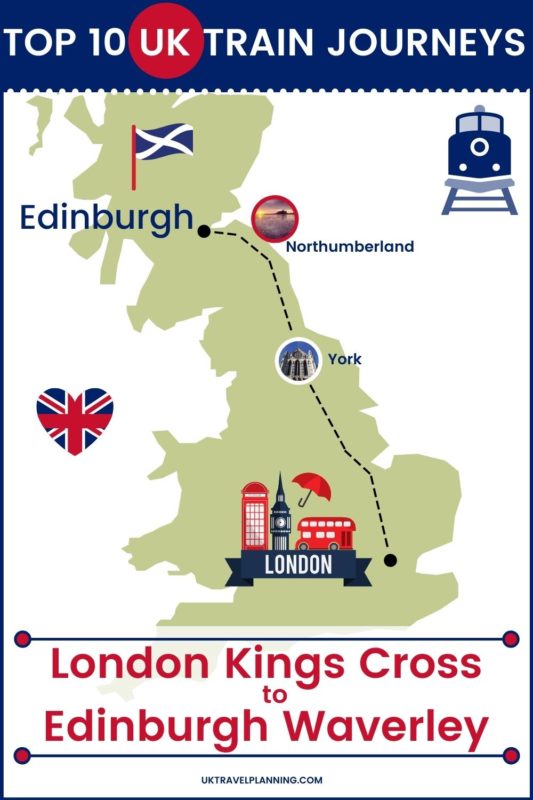
London St Pancras > 2 hours > Sheffield > 3 hours 50 mins > Edinburgh
An alternative route to that above is from St Pancras (next to Kings Cross) using East Midlands Railway Service .
On this journey from London to Edinburgh you will see different scenery as it takes you on the cross country route via Sheffield and the Derbyshire Dales .
This journey will give you more a sense of the countryside in central England and passes through the cities of Leicester, Derby and Chesterfield (look for the crooked spire as you travel into Chesterfield)
You need to change trains at Sheffield from the East Midlands trains onto an Edinburgh service run by CrossCountry. The slower service from Sheffield to Edinburgh goes via Leeds. A faster route bypasses Leeds but may mean a change of trains in York or Newcastle .
Check which train operator you have a ticket with as they are generally not interchangeable between each other.
(Please note if you have booked your ticket through a retailer such as thetrainline.com you will have a valid ticket for the entire journey as you will have selected the relevant tickets and seat reservations)
The cross country route joins the East Coast Mainline at Doncaster (south of York).
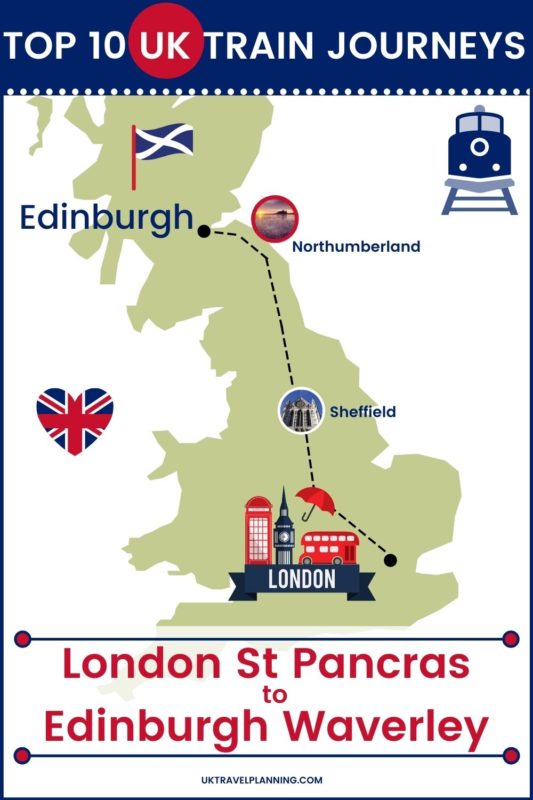
Learn more – 19 beautiful destinations in Scotland for your bucket list
5. Leeds (Settle) to Carlisle Line
Leeds > 2 hours 45 minutes > Carlisle 72 miles
This is a famous route which joins the cross country lines to the West Coast mainline. Cross the Pennines surrounded by rugged countryside and stunning views.
The train passes through a number of beautifully restored train stations. This line came within a whisker of being closed down but only a lobby group prevented its permanent closure.
From Leeds the train passes through Saltaire a model Victorian town and UNESCO World Heritage Site. Two stops further you pass through Keighley (the home of the famous steam railway the Keighley and Worth Valley Railway)
After Settle Junction you head north through stations such as Horton-in-Ribblesdale, Kirkby Stephen, Lazonby & Kirkoswald and Langwathby. The station at Dent is the highest mainline train station in England at 1150 feet.
After Horton-in-Ribblesdale and Ribblehead the train passes over the famous Ribblehead Viaduct . With 24 arches set on a curve (and an incline) the Ribblehead Viaduct is instantly recognisable in iconic steam train images (along with the Glenfinnan Viaduct in Scotland)
There are several tunnels along the line including the Bleamoor Tunnel which is 2629 yards long. The entire line was a massive achievement of Victorian engineering.
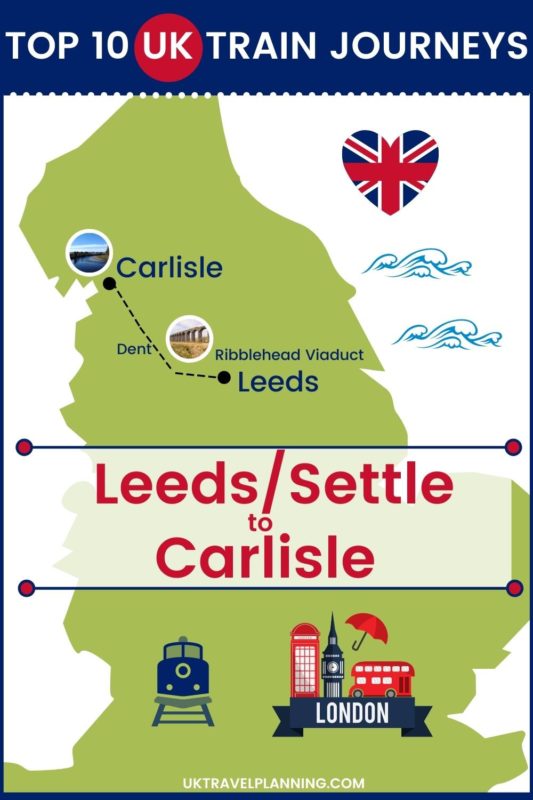
6. Birmingham New Street to Llandudno via Hereford, Shrewsbury & Chester ( +optional return to Shrewsbury via the Blaenau Ffestiniog Independent Narrow Gauge Railway )
Birmingham New Street > 1 hour 25 mins > Hereford > 60 minutes >Shrewsbury > 1 hour 5 mins > Chester > 1 hour 10 mins > Llandudno Junction > 10 mins > Llandudno > 10 mins > Llandudno Junction > 1 hour 10 mins > Blaenau Ffestiniog (private railway) > 30 mins > Penrhyndeudraeth > 3 hours > Shrewsbury
This is a potential two to three day trip depending on where you decide to stop off along the way.
The journey from Birmingham New Street to Hereford takes approximately 1 hour 25 mins via West Midlands trains . Train passes through Worcestershire and the picturesque Malvern Hills into Hereford.
The journey from Hereford to Shrewsbury along the Welsh marches line (one of the England’s most scenic railway routes) takes around an hour and passes through many places of historical interest including the famous market town of Ludlow.
In Shrewsbury change trains to Llandudno via Chester. If you decide to head into Shrewsbury you will find half timbered houses in the Tudor centre of town.
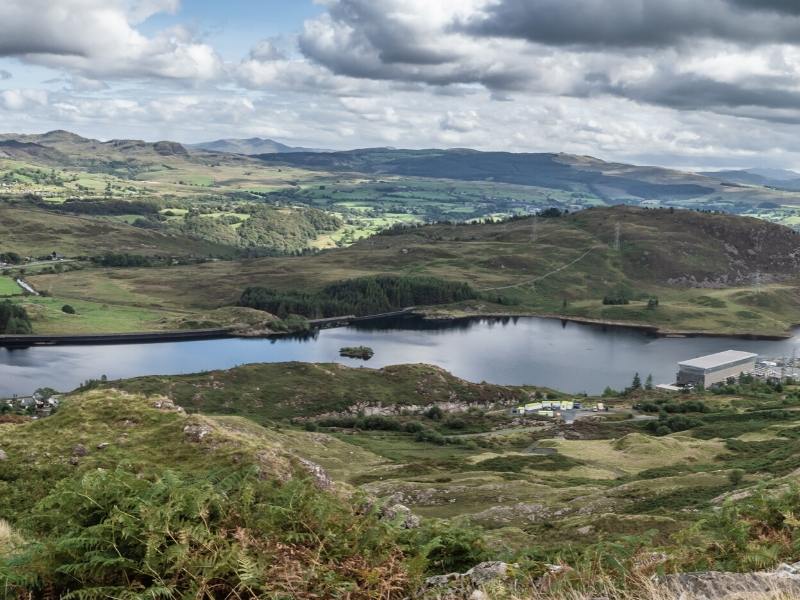
The journey time from Shrewsbury to Chester on Transport for Wales services is about 1 hour 5 mins. The train line passes into Wales and then back into England before pulling into the beautiful walled city of Chester.
It is worth planning to spend the day in Chester as there are lots of things to do and see in the city including the cathedral, Roman walls, the Tudor timbered buildings, and the Rows (a medieval two level covered arcade)
From Chester to Llandudno change at Llandudno Junction where it is a further 10 minutes into the Welsh seaside town .
For those of you who would like to explore further we recommend you take the train to Blaenau Ffestiniog where you can catch the narrow gauge private heritage railway which runs for 21 kms and is located within Snowdonia National Park.
Frequency of these services depend on the time of year so do check before traveling to avoid disappointment.
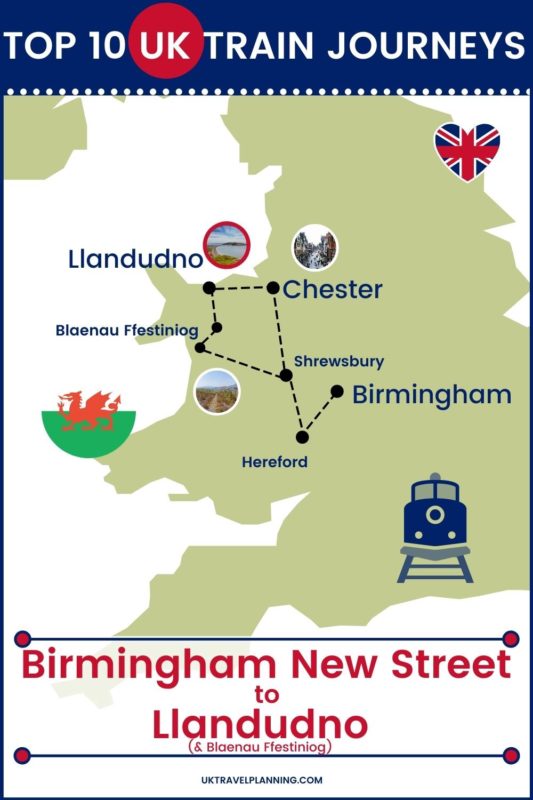
Sheffield > 1 hour 20 mins > Manchester Piccadilly > 1 hour > Liverpool Lime Street
The Sheffield to Manchester Piccadilly line is operated by multiple train operating companies . This route takes you up and over the Pennines and down across the Hope Valley and Edale in the Peak Distric t. This is beautiful all year round scenery. Temperature and weather changes can be rapid.
On this train journey you will witness the contrast between the industrial heart of the country and the beautiful lush countryside.
I recommend taking the slowest possible train journey with stops at all of these fabulous stations Dore & Totley, Grindleford, Hathersage, Hope, Edale and Chinley to name but a few.
Change at Manchester Piccadilly for services to Liverpool Lime Street.
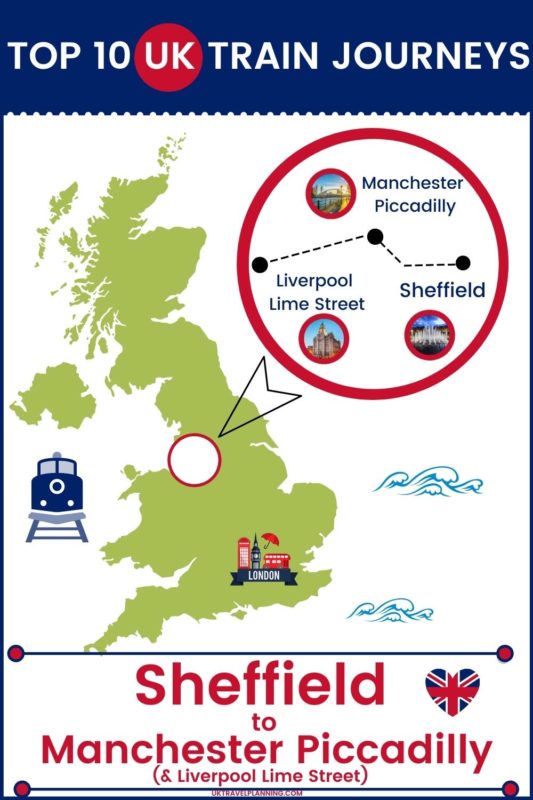
Glasgow Queen Street > 1 hour 45 mins > Crianlarich > 1 hour 45 mins > Fort William > 1 hour > Mallaig
There are a few trains a day that run this route. From Glasgow Queen Street to Fort William it takes 3 hours 45 minutes. For services to Oban and ferry services to the Inner Hebrides Islands of Mull, Tiree, Barra, and Coll etc change at Crianlarich.
For the best views as you leave Glasgow sit on the left hand side of the train.
This is a ScotRail service. Take this trip in the daylight as the scenery is stunning. North of Crianlarich the train crossed over the bleak wilderness of Rannoch Moor. Look out for Ben Nevis (the UK’s highest mountain) as you approach Fort William.
Change trains at Fort William for Mallaig. This journey takes about 1 hour and takes you over the famous 21 arch Glenfinnan curving viaduct (as seen in Harry Potter) with views of Loch Shiel and the Jacobite Monument.

Further along this route you reach the coast at Arisaig – the western most train station in Britain. As the train turns north enjoy views of the Sound of Sleat and the islands of Aigg, Rum and Muck .
It is vitally important to plan your travel in advance so you don’t get stranded. There are very limited trains from Glasgow to Oban, Fort William and Mallaig.
The Jacobite is another train service from Fort William to Mallaig. This is a private service that only runs in the summer months and is extremely popular (and pricy). Many photographs you will see of the Glenfinnan Viaduct feature the Jacobite steam train service puffing its way across the arches.
Good to know – If you are starting your journey in Edinburgh you will find a multitude of trains every half hour. It takes roughly 50 mins between the two cities.
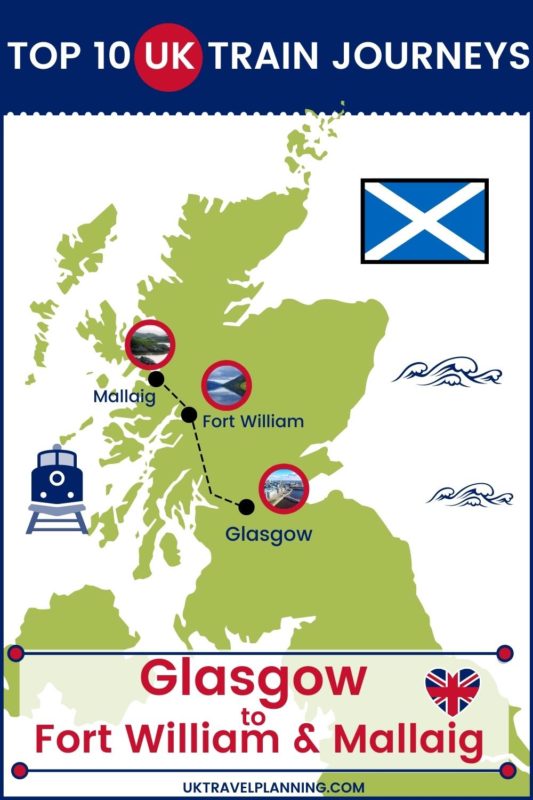
9. Edinburgh to Inverness (via Dundee or via Stirling)
Edinburgh > 1 hours 10 mins > Dundee > 2 hours 20 mins > Aberdeen > 2 hours 15 mins > Inverness
This is a ScotRail service. It takes 1 hour 10 minutes to Dundee from Edinburgh Waverley train station where you can change trains for Inverness or you could stay on the train and change at Aberdeen.
This route will take you over the Forth Rail Bridge. (Also as you leave Edinburgh look upwards for a view of Edinburgh Castle)
I would only recommend taking this route in daylight or during the summer months. This is the slower route to Inverness but it takes you along the coast and through rural Scotland.
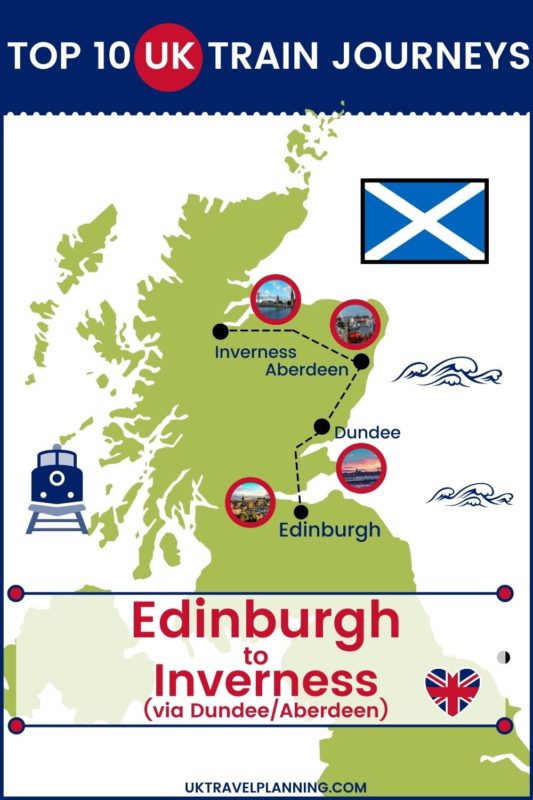
Edinburgh > 40 mins > Stirling > 3 hours > Inverness
The fastest routes from Edinburgh to Inverness are via Stirling and Perth. These take 3 hours 35 mins. If you want to go via Stirling you will need to change trains there for a service to Inverness via Perth.
Around 25 minutes into the journey to Inverness via Stirling look out of the right hand side of the train and you may catch a glimpse of the Kelpies at Falkirk. You will also see Stirling Castle on your approach into the city.
From Stirling the route takes you through Perth, Pitlochry, Kingussie, Aviemore and the Cairngorms National Park. This route is typified by beautiful scenery all year round.
Good to know – For a surprising contrast in terrain and scenery take the train up to Thurso and Wick from Inverness.
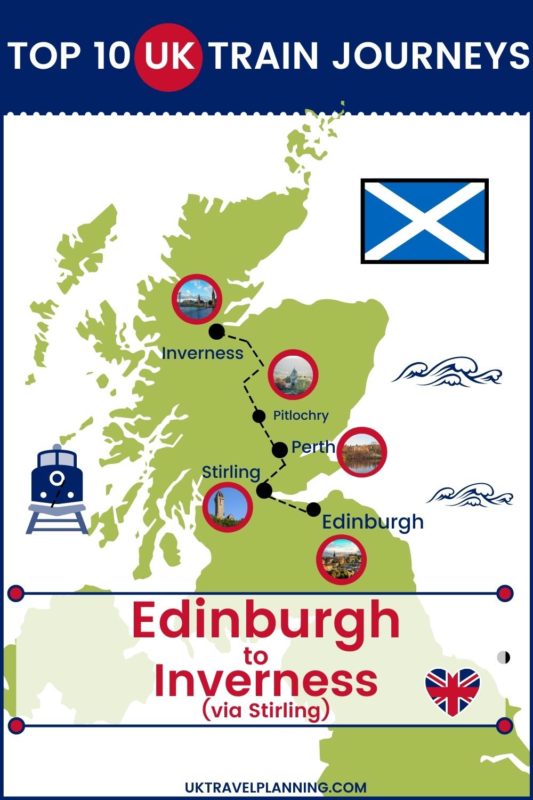
10. Inverness to Kyle of Lochalsh
Inverness > 2 hours 30 mins > Kyle of Lochalsh It is 82 miles from Inverness to the Kyle of Lochalsh
This is a beautiful train journey with scenic and dramatic views over the Highlands of Scotland .
There are many highlights along this route. Look out for the mountain of Ben Wyvis between the Muir of Ord and Dingwall. You may also be lucky to spot deer between Loch Luichart and Garve.
The train passes through Plockton where Hamish Macbeth (the TV series) was filmed in the 1990s.

As you head into the Kyle of Lochalsh enjoy spectacular views of the Isle of Skye .
Good to know – there is an Isle of Skye bus tour which operates every day at 11.45 am. The tour returns in time to catch the last train to Inverness. Alternatively take a day tour from Inverness to Skye (but you would miss this lovely train journey)
Do check for train times and frequency in advance as there are a limited number of daily services.
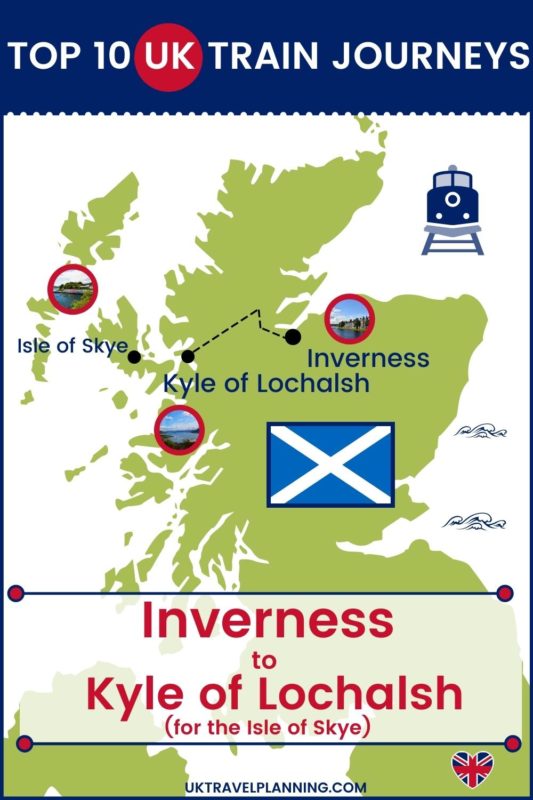
Plan your UK train travels
If you are unfamiliar with the UK rail network you will find our in-depth guide invaluable. You may also find our guide to getting around London useful too as it details all methods of public transport.
Written by Doug Collins (the co-founder of UK Travel Planning ) who has over 25 years experience working and traveling on the UK train network) the article answers all the questions you may have to help you plan your train journeys in the UK.
It is important to follow any advice around train travel in the UK from train operating companies as well as legal requirements in the light of Covid-19.
Note that it is the law that you must wear a face covering when travelling in England on a
- train or tram
- bus or coach
- ferry or hovercraft or other vessel
Reservations should also be made in advance where possible via contactless payment.
If you are planning train travel in the UK and you are not a UK permanent resident I would recommend checking out BritRail Passes .
There are 7 different passes available and you can choose depending on where you plan to visit. For example there are 3 different passes for Scotland – a Spirit of Scotland pass, a Scottish Highland Pass or a Central Scotland Pass.
Alternatively you can purchase the BritRail Pass which covers the entire UK.
Click the button below for more information.
As you can probably tell we love train travel and it is always our chosen method of transport.
Where possible we include at least one train trip into our holiday plans so you will find lots of train related tips, inspiration and resources for UK train travel on both this website and its sister site tracystravelsintime.com
- Discover 12 great day trips by train from London.
- Our best of Britain by rail 14 day itinerary – see 3 countries and 7 top destinations following our detailed itinerary
Back to the future? Airline sector poised for change post-COVID-19
It’s difficult to overstate just how much the COVID-19 pandemic has devastated airlines. In 2020, industry revenues totaled $328 billion, around 40 percent of the previous year’s. In nominal terms, that’s the same as in 2000. The sector is expected to be smaller for years to come; we project traffic won’t return to 2019 levels before 2024.
Financial woes aside, the pandemic’s longer-term effects on aviation are emerging. Some of these are obvious: hygiene and safety standards will be more stringent, and digitalization will continue to transform the travel experience. Mobile apps will be used to store travelers’ vaccine certificates and COVID-19 test results.
Other effects, though, are more profound. Unlike the 2008 global financial crisis, which was purely economic and weakened spending power, COVID-19 has changed consumer behavior—and the airline sector—irrevocably.
This article will explore five fundamental shifts in the aviation industry that have arisen from the pandemic. For each of these shifts, we also issue a call to action. By responding to these shifts decisively now, carriers should be able to look beyond the pandemic and adapt to the long-term realities of COVID-19.
1. Leisure trips will fuel the recovery
Business travel will take longer to recover, and even then, we estimate it will only likely recover to around 80 percent of prepandemic levels by 2024. Remote work and other flexible working arrangements are likely to remain in some form postpandemic and people will take fewer corporate trips.
In previous crises, leisure trips or visits to friends and relatives tended to rebound first, as was the case in the United Kingdom following 9/11 and the global financial crisis (Exhibit 1). Not only did business trips take four years to return to precrisis levels after the attacks on the World Trade Center but they also had not yet recovered to pre-financial-crisis levels when COVID-19 broke out in 2020. Therefore, we expect that as the pandemic subsides, the rise in leisure trips will outpace the recovery of business travel.
Some carriers are highly dependent on business travelers—both those traveling in business class and those who book economy-class seats right before they need to travel. While leisure passengers fill up most of the seats on flights and help cover a portion of fixed costs, their overall financial contributions in net marginal terms are negligible, if not negative. Most of the profits earned on a long-haul flight are generated by a small group of high-yielding passengers, often traveling for business. But this pool of profit-generating passengers has shrunk because of the pandemic.

A McKinsey Live event on 'Returning to corporate travel: How do we get it right?'
The call: Revisit flight economics
Airlines should reevaluate the economics of their operations, especially long-haul flights. First, a smaller contribution from business traffic could necessitate a different pricing logic. For example, today most carriers price point-to-point nonstop flights at a premium. Travelers who value time over price—mostly business travelers—book these nonstop flights. Leisure travelers, even those traveling in premium classes, are more price sensitive and may choose an indirect routing. This large gap between nonstop pricing and connect pricing may need to narrow.
Second, lower business traffic may require network changes. Airlines added many flights over the past few years between hubs and smaller cities, using small-size widebodies such as the Boeing 787. These flights work because of the high-yielding business demand. With business demand subdued, economics favor larger aircraft flying less frequently. Airlines may find that larger aircraft such as Airbus A350s or Boeing 777s—which have lower unit costs—become the base of the long-haul network.
Third, airlines may also look at reconfiguring the layout of their cabins to address the increased share of leisure traffic. At the simplest level, lower business-class demand may warrant smaller business-class cabins. Taking this further, products may shift to better cater to premium-leisure passengers, such as growth of premium-economy cabins or development of business-class seats more suitable for traveling as couples or groups.
2. Staggering debt levels will lead to ticket price increases and a larger role for government in the sector
Many airlines have had to borrow huge sums of money to stay afloat and cope with high daily cash burn rates. Tapping into state-provided aid, credit lines, and bond issuances, the industry collectively amassed more than $180 billion worth of debt in 2020, 1 “COVID-19 lowers airline credit ratings and raises the cost of debt,” International Air Transport Association, August 21, 2020, iata.org. a figure equivalent to more than half of total annual revenues that year. And debt levels are still rising (Exhibit 2). Repaying these loans is made even harder by worsening credit ratings and higher financing costs.
These costs will need to be recouped. Therefore, we’ll likely see ticket prices rise. By our estimates, this could amount to a rise in ticket prices of about 3 percent, assuming a ten-year repayment window for only the additional debt taken on.
Furthermore, when demand for air travel returns, it will likely outpace supply initially. We see a glut of latent demand of people eager to travel. It will take time for airlines to restore capacity, and bottlenecks such as delays in bringing aircraft back to service and crew retraining could lead to a supply–demand gap, resulting in higher short-term prices.
In many cases, airline rescue efforts come in the form of government bailouts—with strings attached. We’re seeing a reemergence of, or increase in, the level of state ownership and influence. In Europe alone, TAP Air Portugal, Lufthansa Group, and Air Baltic all received state aid combined with an increase or reintroduction of government shareholdings.
The call: Be a constructive collaborator
As the state becomes a more active player—whether as a creditor, a direct shareholder, or as part of the board—airlines will find themselves having to deal more closely with the authorities. Instead of seeing this as a necessary restriction to access much-needed funds, airlines can treat it as an opportunity to shape how the sector evolves with a key stakeholder.
Airlines can work with regulators to set standards across a gamut of issues. These could include committing to reductions in greenhouse-gas emissions in return for more labor flexibility; increasing the cash-on-hand requirements to make airlines more resilient against future shocks; more balanced value sharing between airlines and other sectors such as airports; or changes in the ownership caps to allow greater inflows of foreign capital, reducing the reliance on state capital further down the road.
3. We will see a greater disparity of performance among airlines in the future
Some airlines have responded to the pandemic by restructuring for greater efficiency; others are merely muddling through. Occasionally, this is linked to state-aid programs, which may reduce the incentive for much-needed measures such as cost, organizational, and operational restructuring. Airlines that are not proactively transforming risk failing to set the business up for longer-term structural value creation.
As such, we’re seeing some airlines pull ahead. Before COVID-19, an airline boasted an ROIC well ahead of the overall industry’s rate of 5.8 percent. Not only did its stronger position pre-COVID-19 enable it to navigate the crisis thus far without taking on government loans of the scale relative to other airlines, it also made it possible for it to restructure to emerge with an even more competitive cost base.
Another group of carriers that have an opportunity to transform their business are airlines that have access to a restructuring process, such as Chapter 11 in the United States. These carriers can renegotiate midlife leases, shed excess debt, and emerge leaner. They will be fierce competitors going forward.
The call: Aim higher when it comes to IT and digital investment
Becoming better can necessitate investment. Even though many airlines find themselves in financial straits, we recommend investing more in IT and digitalization, not less. Before the pandemic, airlines spent roughly 5 percent of their revenue on IT. This is relatively low compared with other sectors. By means of comparison, the retail industry spends around 6 percent on average, and financial services 10 percent.
Airlines could consider stepping up IT and automation investment now. For example, airlines can respond to the quicker recovery of domestic and short-haul flights by investing in direct sales and owning the customer relationship. Relationships with IT and distribution providers could be reexplored. Carriers can also invest in the customer experience—such as making check-in and boarding processes more seamless—and support services—from revenue accounting to invoicing—to drive the next level of efficiency. Beyond this, the next horizon is analytics, which involves, among other efforts, using data in smarter ways to enhance decision making, requiring some investment but yielding significant payoffs .
4. Aircraft markets may be oversupplied for some time to come
In the years before COVID-19, aircraft OEMs ramped up production in the anticipation of continued growth. This has led to a glut in aircraft availability. Furthermore, some carriers have returned relatively new aircraft to lessors, such as Norwegian Air Shuttle when it exited the long-haul market. Prices for used-aircraft leases have plummeted and are likely to remain lower. For instance, the monthly lease rate of a 2016 vintage Boeing 777-300ER aircraft was around $1.2 million in 2019. In 2020, the rate fell to less than $800,000. New aircraft are rumored to be available at even deeper discounts.
The call: Act countercyclically now, if you can
If finances permit, carriers can consider acting countercyclically: locking in orders for new aircraft or confirming operating leases now when demand is low. Aircraft are a significant expense for an airline, making up 10 to 15 percent of a carrier’s cost base. As lease rates and OEM pricing fluctuate with supply and demand levels, inking deals during a crisis could allow carriers to enjoy a cost advantage for years to come.
5. Air freight will see undersupply for some time
Over the past ten years, low cargo rates and the unprofitability of the cargo business have led many airlines to relinquish or scale back their dedicated cargo freighter fleets. However, cargo has been a lifeline for the aviation industry during COVID-19. Before the pandemic, cargo typically made up around 12 percent of the sector’s total revenue; that percentage tripled last year. Based on data from the Airline Analyst, only 21 (down from 77 in 2019) of the airlines around the world that disclosed their operating performance achieved positive operating profits for the third quarter of 2020, traditionally the industry’s most profitable quarter. Among these 21 airlines, cargo revenue accounted for 49 percent of total revenues on average.
During the pandemic, e-commerce sales soared while many passenger flights—which are responsible for delivering around half of total air cargo—were grounded. As a result, cargo yields increased by about 30 percent last year. As commercial flights gradually return, belly supply will increase, although not to pre-COVID-19 levels for at least a few years, as the industry is expected stay smaller than before the pandemic for several years.
The call: Bring back freighters, carefully
In response to the high demand and low supply of air freight right now, carriers could investigate short- to medium-term opportunities to boost their cargo services. Airlines can enhance their flexibility through measures such as increasing the deployment of so-called preighters, or passenger airplanes that are used to transport cargo. Airlines may look at freighter conversions, especially as their passenger fleets reduce in number.
Airlines need to be agile. Rushing headlong into developing and maintaining a large freighter fleet again comes with risk. Airlines need to grow cargo in an agile way that allows for quick adjustments; pursuing such a play should be seen as part of a wider theme of establishing a more flexible production setup. High fixed costs combined with unpredictable demand levels outside an airline’s control increase the need for airlines to be able to scale down supply nimbly.
The impact of the COVID-19 pandemic is far from over. There is some relief to be found in various parts of the world now that vaccinations have begun, but the road to recovery for air traffic will take several years. The shape of the post-COVID-19 airline sector is becoming clearer and holds lessons for airlines today. Multiple longer-running trends have been accelerated, such as digitization and the phasing out of less efficient aircraft. Burdened by debt, many carriers have depleted their cash reserves. But the forecast is not without bright spots. Travel will become greener and more efficient, and people are itching to travel again for holidays. Taking steps now will help airlines thrive in this transformed sector.
Jaap Bouwer is a senior expert in McKinsey’s Amsterdam office, Steve Saxon is a partner in the Shenzhen office, and Nina Wittkamp is a partner in the Munich office.
The authors wish to thank Alex Dichter and Vik Krishnan for their contributions to this article.
This article was edited by Jason Li, a senior editor in the Shanghai office.
Explore a career with us
Related articles.

Airline data: What next beyond crisis response?

Will airline hubs recover from COVID-19?

‘Prepare for the marathon and be ready for the course to change’: An interview with the Boston Logan Airport CEO
UK Edition Change
- UK Politics
- News Videos
- Paris 2024 Olympics
- Rugby Union
- Sport Videos
- John Rentoul
- Mary Dejevsky
- Andrew Grice
- Sean O’Grady
- Photography
- Theatre & Dance
- Culture Videos
- Fitness & Wellbeing
- Food & Drink
- Health & Families
- Royal Family
- Electric Vehicles
- Car Insurance Deals
- Lifestyle Videos
- UK Hotel Reviews
- News & Advice
- Simon Calder
- Australia & New Zealand
- South America
- C. America & Caribbean
- Middle East
- Politics Explained
- News Analysis
- Today’s Edition
- Home & Garden
- Broadband deals
- Fashion & Beauty
- Travel & Outdoors
- Sports & Fitness
- Sustainable Living
- Climate Videos
- Solar Panels
- Behind The Headlines
- On The Ground
- Decomplicated
- You Ask The Questions
- Binge Watch
- Travel Smart
- Watch on your TV
- Crosswords & Puzzles
- Most Commented
- Newsletters
- Ask Me Anything
- Virtual Events
- Betting Sites
- Online Casinos
- Wine Offers
Thank you for registering
Please refresh the page or navigate to another page on the site to be automatically logged in Please refresh your browser to be logged in
Tui earns record revenue with prices for cruises soaring
Demand for holidays rising inexorably – but mallorca hotel chief warns of ‘critical situation’ with overtourism, article bookmarked.
Find your bookmarks in your Independent Premium section, under my profile

Sign up to Simon Calder’s free travel email for expert advice and money-saving discounts
Get simon calder’s travel email, thanks for signing up to the simon calder’s travel email.
Post-pandemic demand for travel appears unstoppable, with Europe’s biggest holiday company revealing record revenue for the first three months of 2024.
A total of 2.8 million customers paid an average of 3 per cent more for their holidays in the quarter compared with a year earlier, taking revenue to €3.6bn (£3.1bn).
The Canary Islands and Egypt were the most popular package holiday destinations between January and March, with demand for Cape Verde – the Portuguese-speaking archipelago off the west coast of Africa “increasing further”.
Demand was particularly strong for Tui ’s cruise ships. The average daily rate rose by one-fifth to €221 (£190), while the number of empty cabins fell by three-quarters; on average 49 out of 50 are filled on the company’s vessels.
The quarterly loss fell by 22 per cent to €189m (£162m); Tui traditionally loses money in winter.
With planes flying 93 per cent full, the prediction for the full financial year is that profits will rise by 25 per cent.
Bookings for the summer are 5 per cent higher than 2023, with prices 4 per cent higher despite increasing competition from online travel agents and easyJet’s holiday operation.
“Travelling is very popular,” said Tui’s chief executive, Sebastian Ebel. “We are seeing high demand for package holidays , in particular.”
The company’s results statement said: “Tui continues to closely monitor geopolitical events, particularly in the Middle East and on the Arabian Peninsula.
“Should the situation or customer demand change, the Group’s business model allows it to flexibly shift capacity from the Eastern to the Western Mediterranean.”
The company would, if necessary, shift some of its flights from Turkey to Spain.
But the Tui announcement came hours after a leading tourism figure on the Spanish island of Mallorca said a “strategic plan” was needed to tackle overtourism .
The Majorca Daily Bulletin reports that Maria Frontera, president of the Mallorca Hoteliers’ Federation, said the Balearic Islands are “in a critical situation”.
“Seeking a balance of coexistence between residents and visitors has long been an issue on these islands,” she said.
Tui insists it “operates organised package tourism that does not impact local living spaces”.
Join our commenting forum
Join thought-provoking conversations, follow other Independent readers and see their replies
Subscribe to Independent Premium to bookmark this article
Want to bookmark your favourite articles and stories to read or reference later? Start your Independent Premium subscription today.
New to The Independent?
Or if you would prefer:
Want an ad-free experience?
Hi {{indy.fullName}}
- My Independent Premium
- Account details
- Help centre

IMAGES
VIDEO
COMMENTS
This UK road trip itinerary has you starting in London, and using a rental car as the transportation method. It covers some of our highlights in the UK, including cities, castles, and stunning natural scenery. I have spent a great deal of time living in and exploring the UK. I've drawn on my experiences travelling here to put together my ...
Travelling around Britain. Accommodation options. Budgeting tips. Accessible travel in Britain. VisitBritain Shop. Pre-order UK attractions, tours and travel tickets before you arrive in the UK. Go to Shop. Visas and entry. Visa and immigration. Latest COVID-19 requirements. Book your trip;
Travelling around Britain by train. Travelling by train is a green, scenic and relaxing way to discover Britain. The rail network here covers whole swathes of Britain, with more than 2,000 stations serving England, Scotland and Wales. It's an easy and efficient was to travel, with different train companies serving different parts.
How to travel around London. In London, there are several transportation options including taking the Tube (underground), overground trains, buses, black cabs (taxi), Thames clippers (boats) and even bicycles. For more information read our transportation guide to London which includes information about the Oyster Card.
It should be valid for the whole of your stay. You may also need a visa to come into or travel through the UK, depending on your nationality. Check which documents you'll need to come to the UK ...
Buses are usually the cheaper long-distance option. Long-distance buses are known as coaches in the UK, and services run between most major towns and cities. If you're on a tight budget, coaches are nearly always the cheapest way to get around England, although they're also the slowest - sometimes by a considerable margin.
Your Trip to the United Kingdom: The Complete Guide. There's a lot more to the United Kingdom than the usual list of top 10 London sights. For a start, there are four separate countries—England, Scotland, Wales, and Northern Ireland —each offering city and country pleasures, wilderness adventures, scenic villages, landmarks, free ...
Travelling to Britain by coach. Using coach or bus services is a cheap but often time-consuming way of travelling to the UK. Many services offer regular routes that cross the English Channel from the European continent. You could choose to terminate your journey in London or other major cities in the UK.
Days 1 & 2: London. No trip to the UK would be complete without a visit to the capital, London. Plus, the chances are very high that this is the city you're going to be flying in to. Although you could easily spend the full ten days of this itinerary wandering around London and still not see it all, we're on a mission to prove that there ...
Other Ways of Getting Around Britain. Coach Travel- Long-distance buses are known as coaches in the UK. Several intercity bus companies provide some of the cheapest ways to get around. Fares vary with operators, generally ranging from five-pound promotional fares to upwards of 35 pounds for longer trips.
If you plan to take a road or rail trip around the UK I recommend 3 days per destination (but consider travelling time and distances) It is possible to base yourself in London and take tours or day trips to nearby cities and areas of interest, plan a road trip around the UK or even a train travel itinerary that incorporates your areas of ...
In episode 97 of the UK Travel Planning Podcast, Tracy and Doug discuss easy day trips from London by train, focusing on destinations like Portsmouth, Winchester, Salisbury (for Stonehenge), Bath, and Oxford. They cover the best train stations to depart from, estimated travel times, and what to look forward to at each destination.
A passenger train is one of the best ways to travel around the UK. The current train strikes occurring throughout the nation are something to keep an eye on. South-eastern and West Midlands Trains were among the lines where Aslef union members embarked on a 24-hour strike. The Commonwealth Fixtures in Birmingham and fans travelling to English ...
The UK is one of the most expensive countries in Europe — and if you're planning a trip, you might be daunted by the cost of transportation within the UK. But it is very possible to travel the UK for cheap! Since settling in Chester, I've found a host of ways to save money on transportation. And all of them have one thing in common: BOOK ...
Here's how to plan the ultimate UK coastal road trip: 1. Get all the boring stuff squared away before you start. Getting your budget together, sorting out your vehicle, gathering the relevant documents (if you're coming from abroad), cancelling deliveries, paying the bills while you're away…these aren't the most exciting things to ...
Megabus. Serves large cities across Britain. Is known for its very cheap £1.50 advance-purchase fares. Regional and local buses provide essential service to metropolitan areas, small towns, rural regions and places where there is no train service. For example, with a little planning, you can use buses to explore the villages along the Welsh coast.
Foreign travel advice. Get advice about travelling abroad, including the latest information on coronavirus, safety and security, entry requirements and travel warnings. Search for a country or ...
Travelling around Britain. Accommodation options. Budgeting tips. Accessible travel in Britain. VisitBritain Shop. Pre-order UK attractions, tours and travel tickets before you arrive in the UK. Go to Shop. Visas and entry. Visa and immigration. Latest COVID-19 requirements. Open menu Close menu. Search.
Finally travel across the border to Chester (1 hour 20 mins). Explore the city's Roman ruins, walk around its city walls, admire the Eastgate Clock and shop the medieval black and white Rows. Then finish off your trip by travelling south back to Cardiff, passing the impressive Pontcysyllte Aqueduct, Herefordshire countryside and Shropshire Hills.
Trains are the fastest way to travel around the UK, especially for long journeys. When you travel by train, you can enjoy the green British countryside through the window and take a picnic for the journey. How to get cheap train tickets: Train tickets are usually cheaper if you buy them online in advance. You can see train times, prices and buy ...
Table Of Contents. See Britain by train with our 14 day itinerary. Days 1 - 3 London. Day 4 London - Bath. Day 5 Bath (Day trip - Cotswolds or Stonehenge) Day 6 Bath - Cardiff. Day 7 Cardiff - Liverpool or Lake District. Day 8 - Liverpool or Lake District. Day 9 Liverpool or Lake District to Edinburgh.
Travel to and from the UK, with detail on traveller age and sex, trip purpose, length, and spending. From International Passenger Survey (IPS), quarterly data.
In the West Midlands and South East, visits were around 20% lower, whereas in the North West and East of England, the number of visits was very close to that seen in 2019. ... Quarterly data on travel to and from the UK, taken from the International Passenger Survey (IPS). Includes detail on age and sex of travellers, purpose and length of trip ...
Travelling around Britain. Accommodation options. Budgeting tips. Accessible travel in Britain. VisitBritain Shop. Pre-order UK attractions, tours and travel tickets before you arrive in the UK. Go to Shop. Visas and entry. Visa and immigration. Latest COVID-19 requirements. Book your trip;
A journey through the UK in an electric car with Rian and Maya looking at wheeled transport and journeys through history. A series of cross-curricular films for KS1 on the topic of 'Travel and ...
It comes as the UK continues to deal with a cost-of-living crisis, with new figures this week revealing a record 3.1 million food bank parcels were distributed over the course of a year. The top ...
The nostalgic Tube travel card from 1988 (Picture: _reXic_/reddit) Because of inflation, that equals £5.36 today. Today, hopping on the Tube for one day of travel between zones 1-6 will set you ...
Alternatively travel back to London via train. The Night Riviera leaves Penzance at 21:45 (21:15 Sundays) and arrives into Paddington at around 5:30 am. Click for ticket prices. 2. London Euston to Glasgow Central. London Euston > 4 hours 50 minutes > Glasgow Central. 343 miles from London Euston to Glasgow Central.
In 2020, industry revenues totaled $328 billion, around 40 percent of the previous year's. In nominal terms, that's the same as in 2000. The sector is expected to be smaller for years to come; we project traffic won't return to 2019 levels before 2024. ... Burdened by debt, many carriers have depleted their cash reserves. But the forecast ...
Post-pandemic demand for travel appears unstoppable, with Europe's biggest holiday company revealing record revenue for the first three months of 2024. A total of 2.8 million customers paid an ...